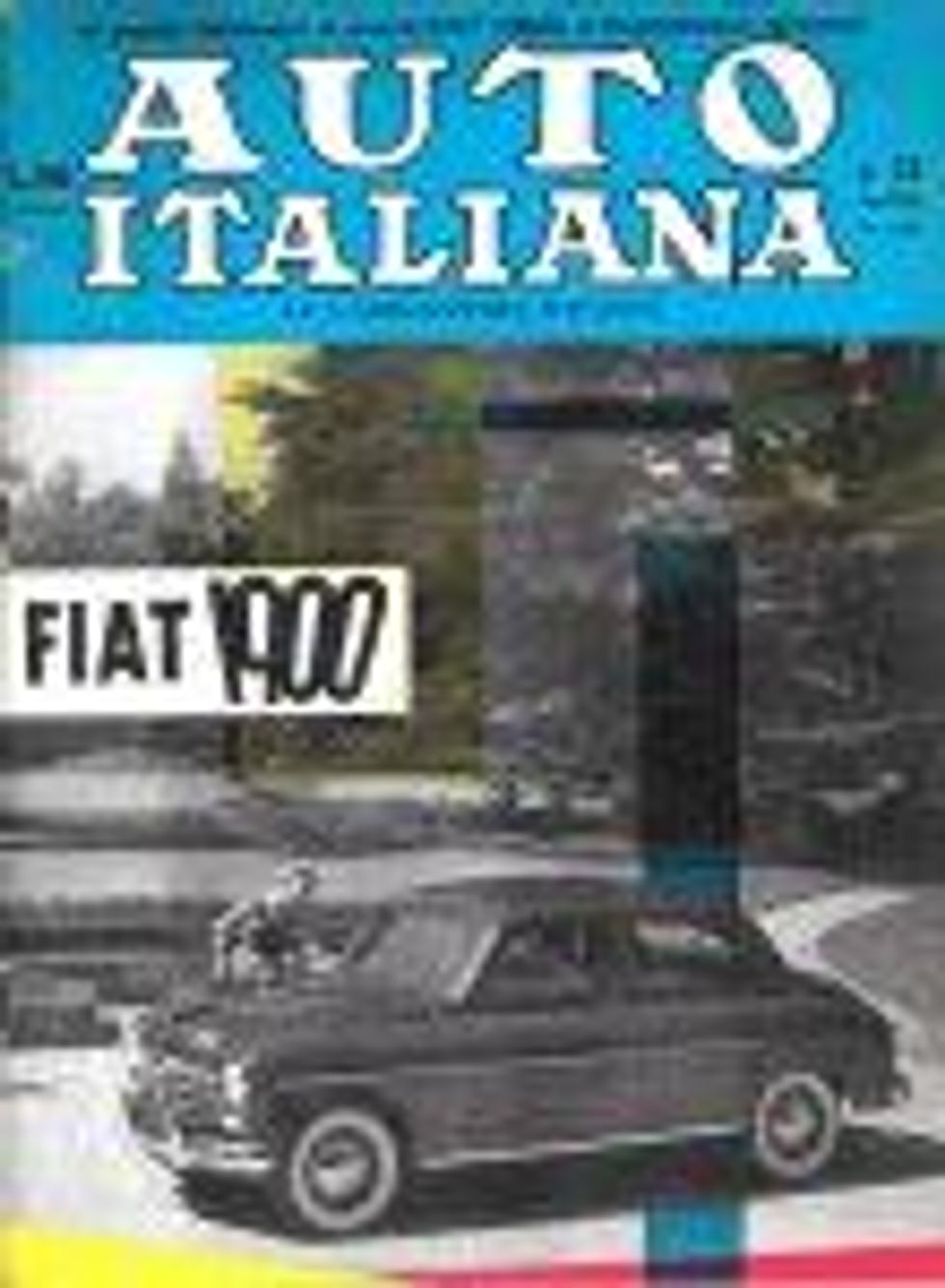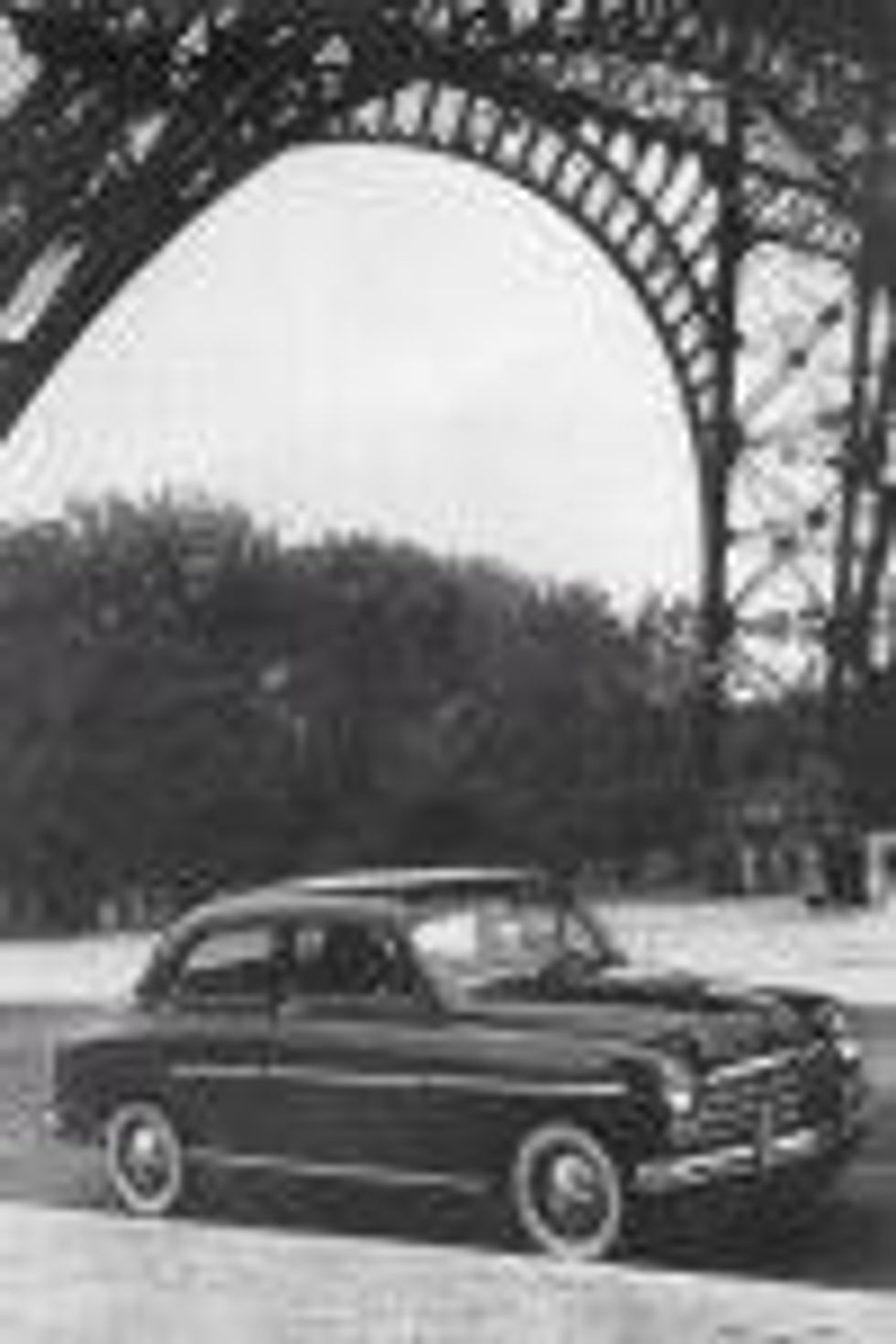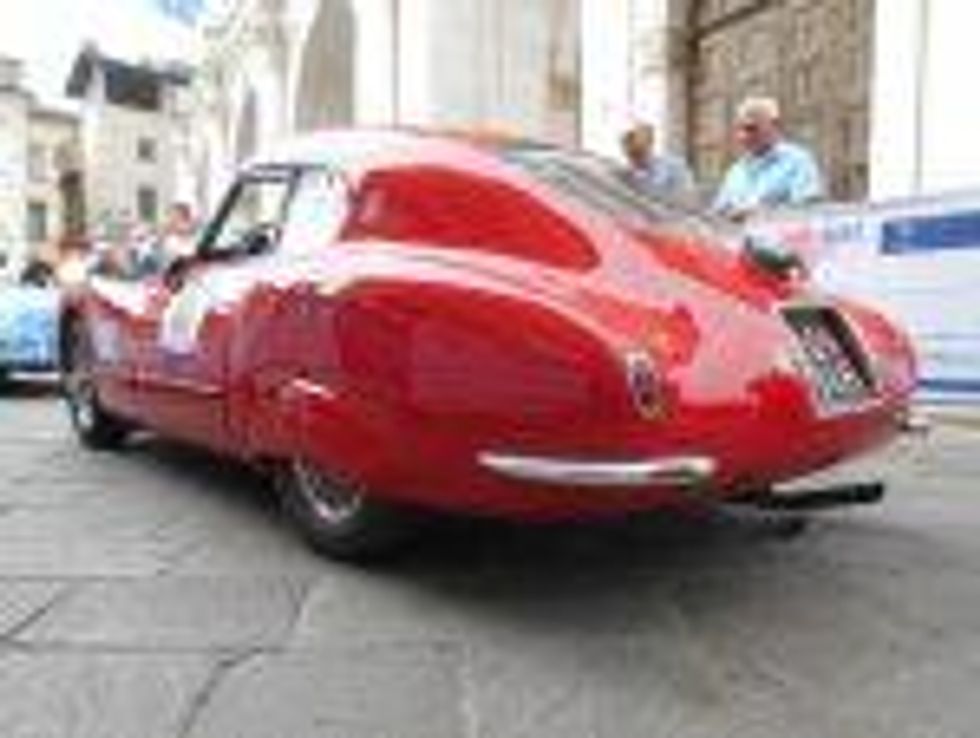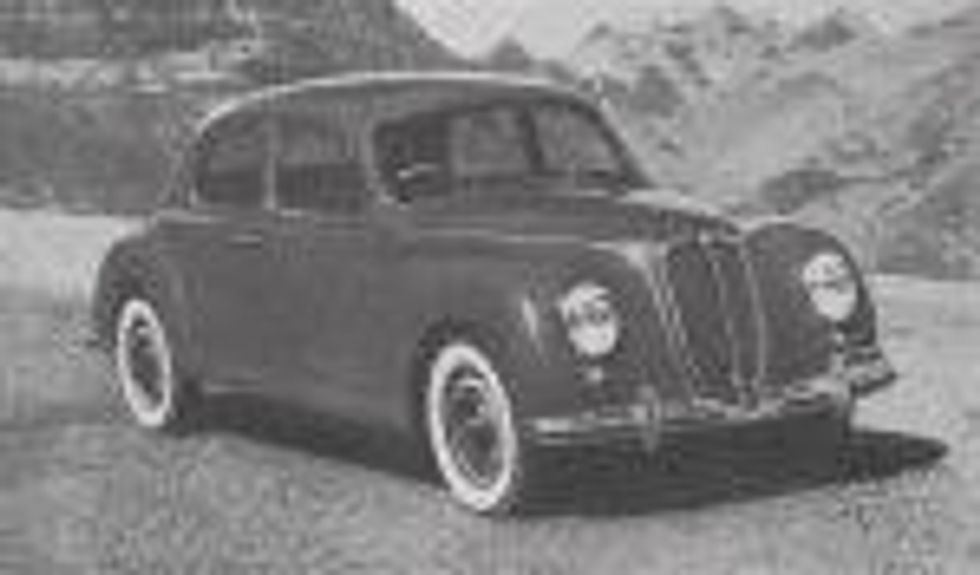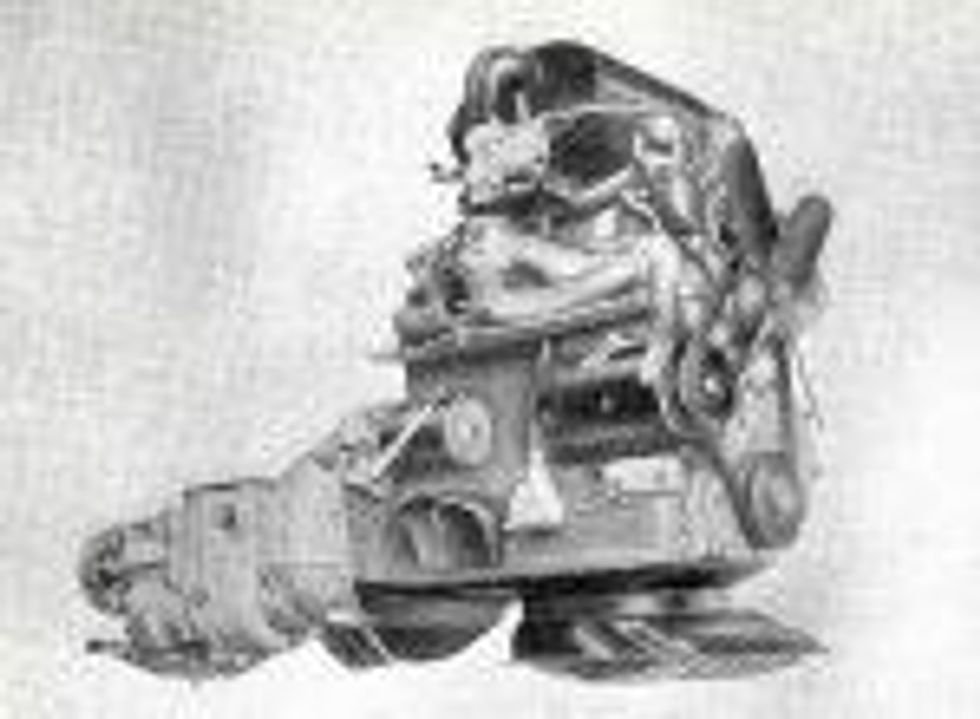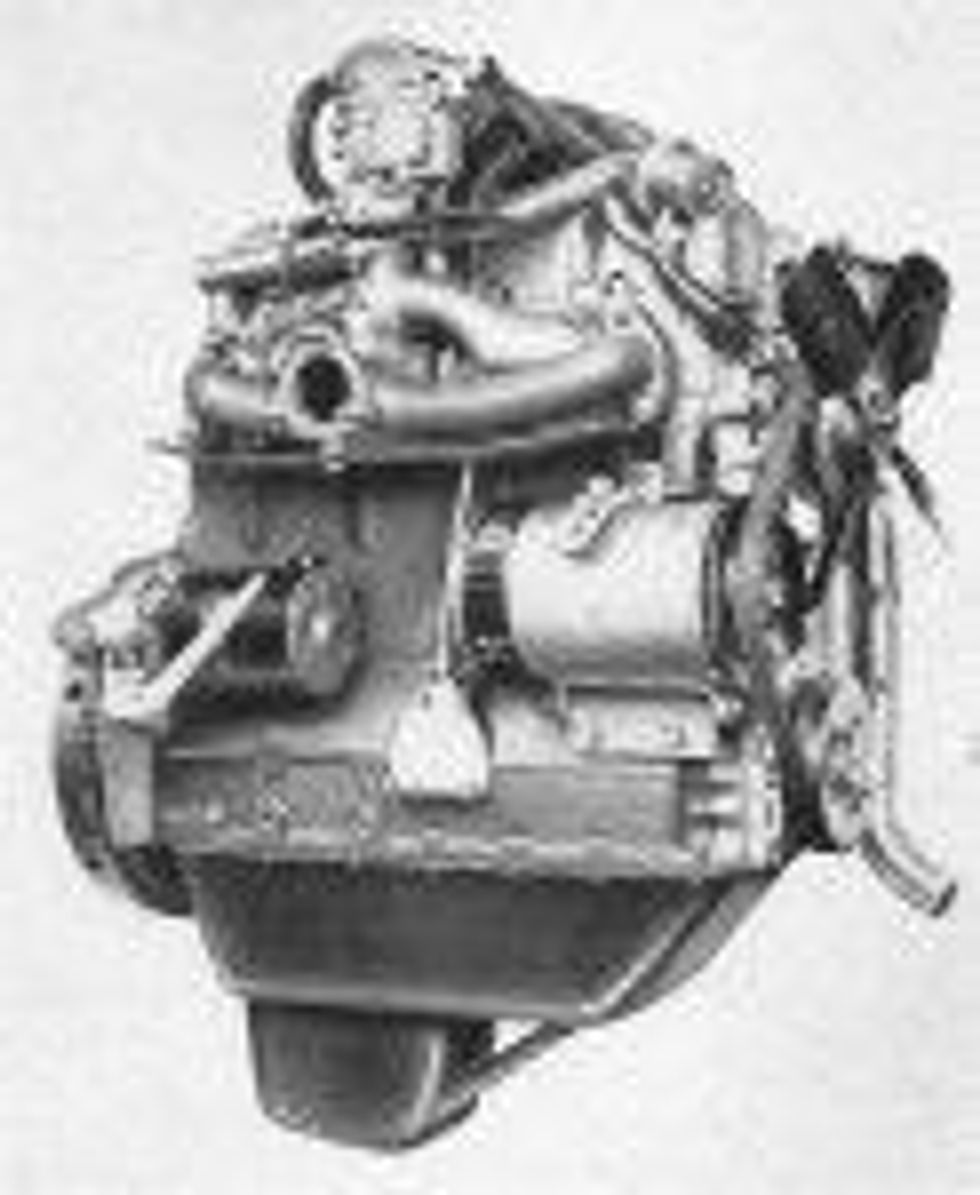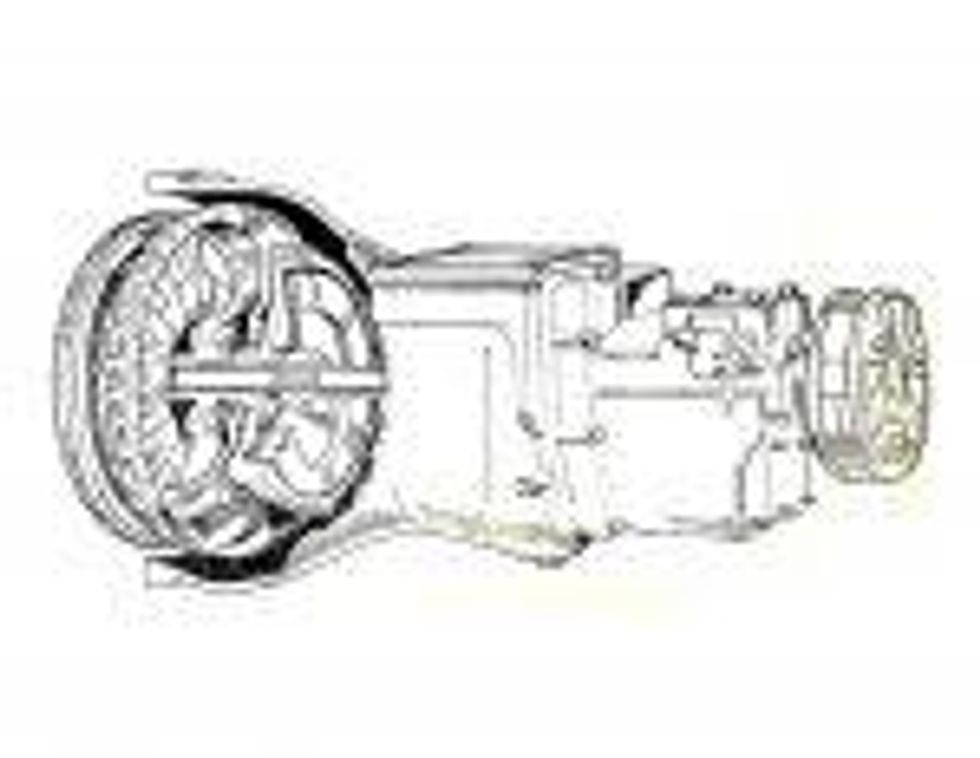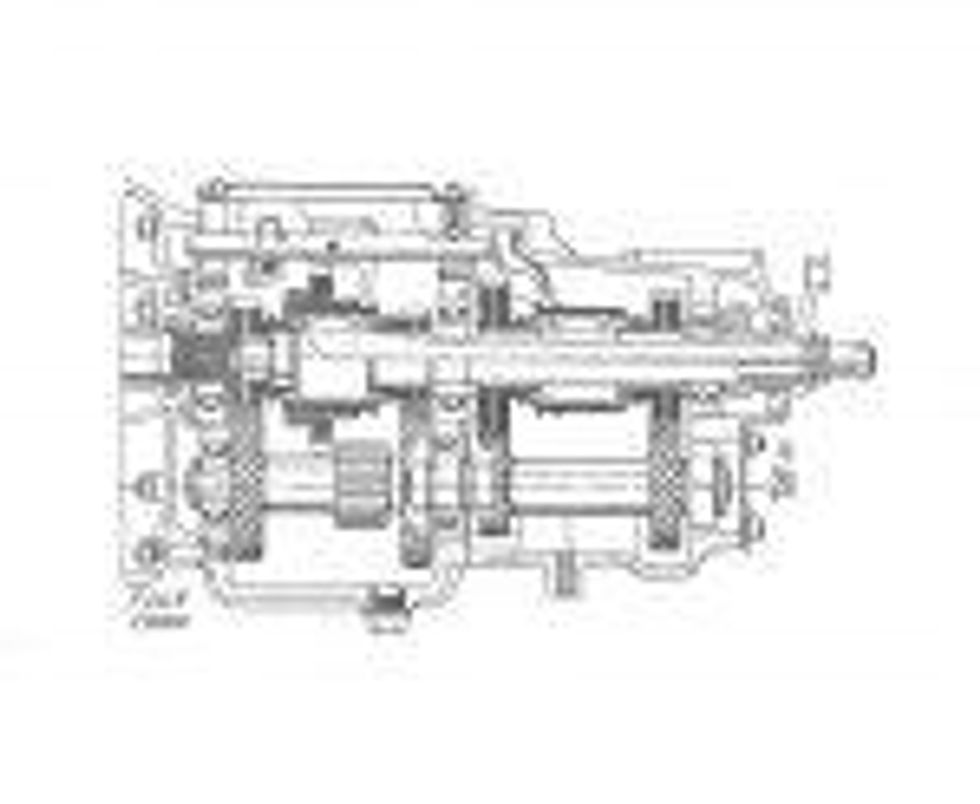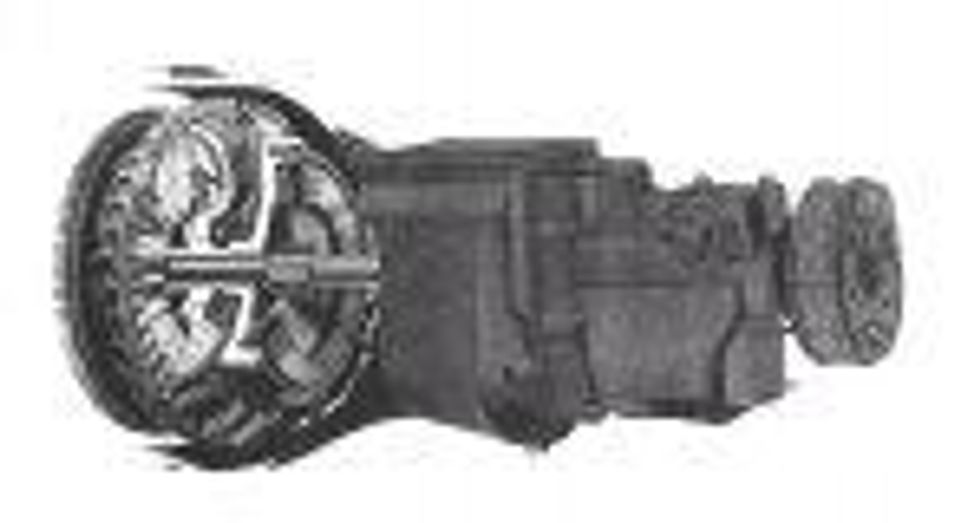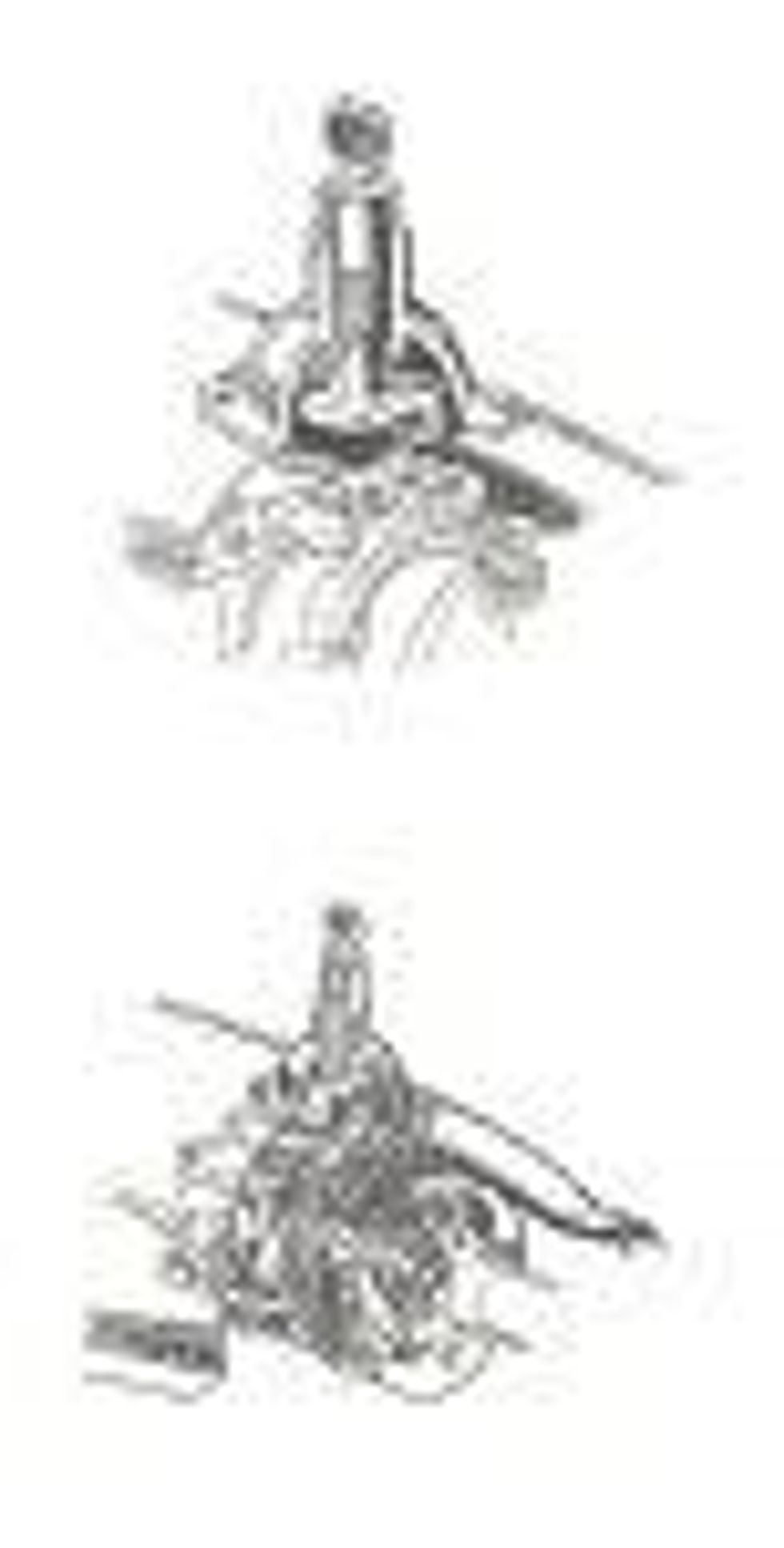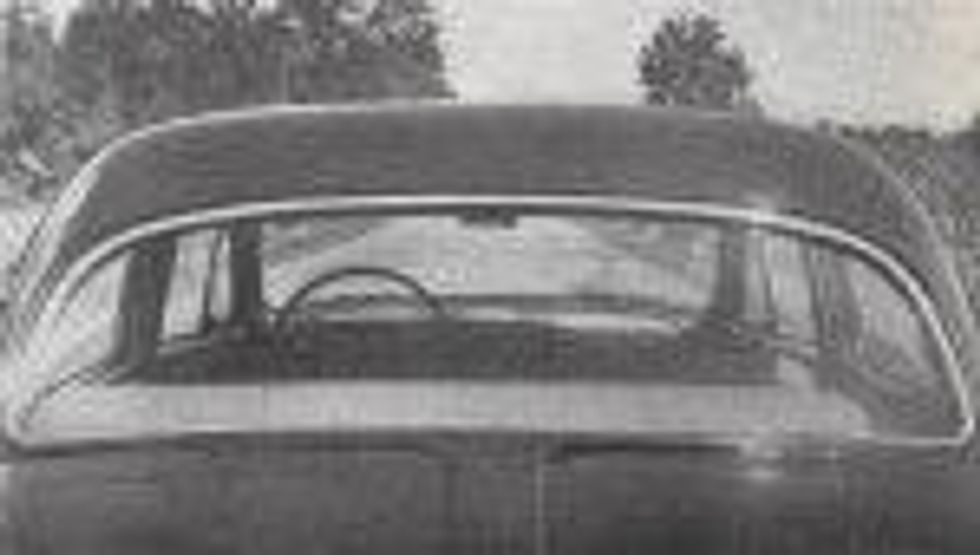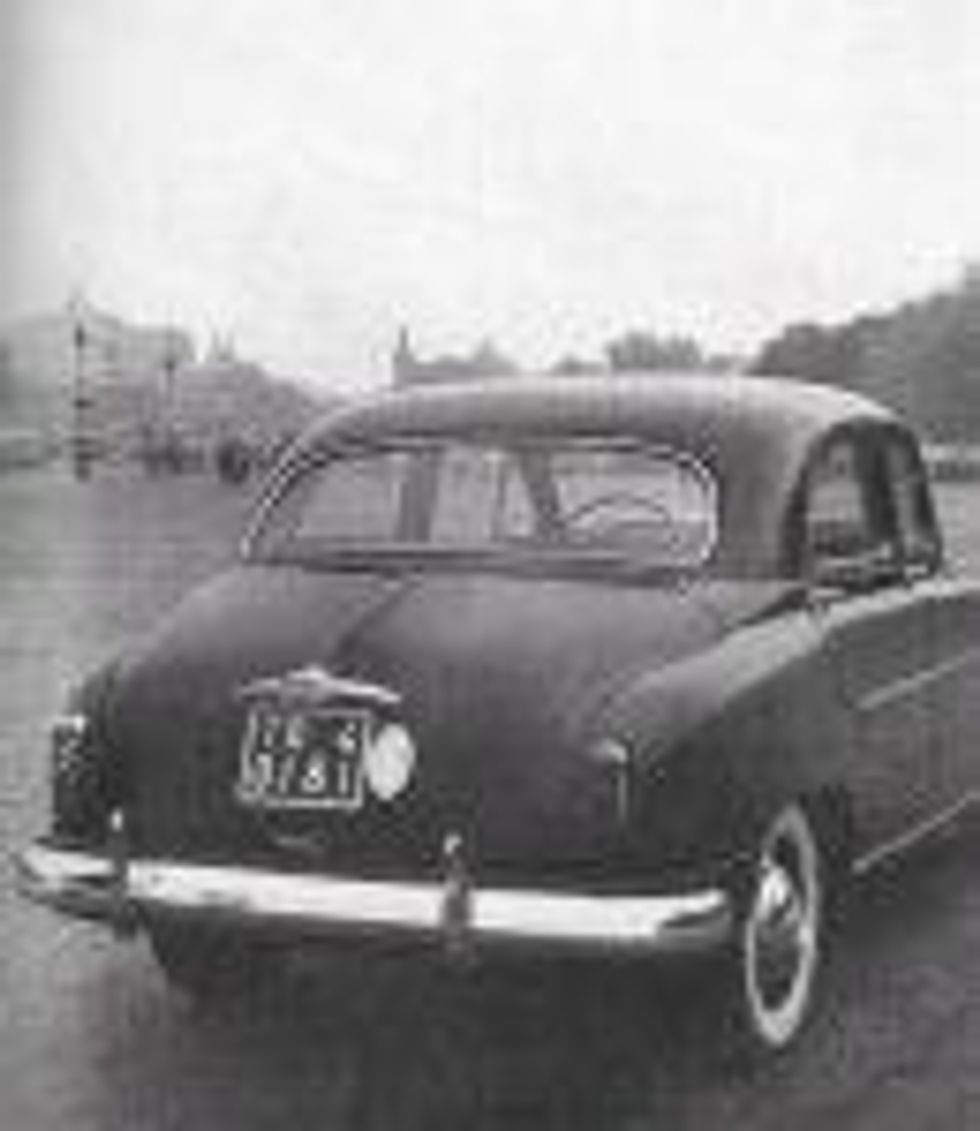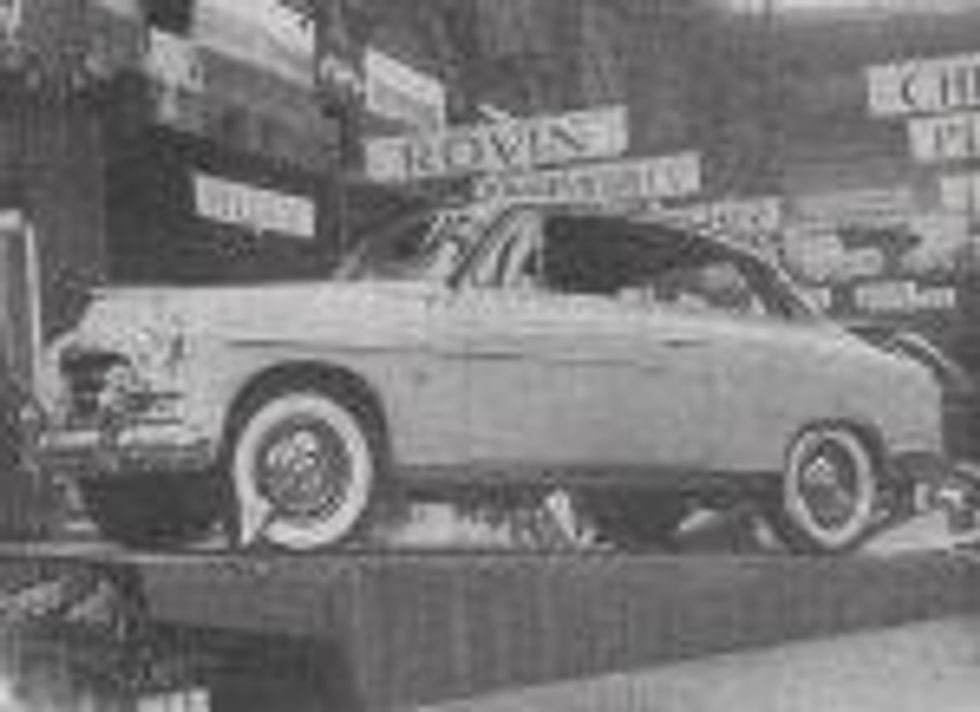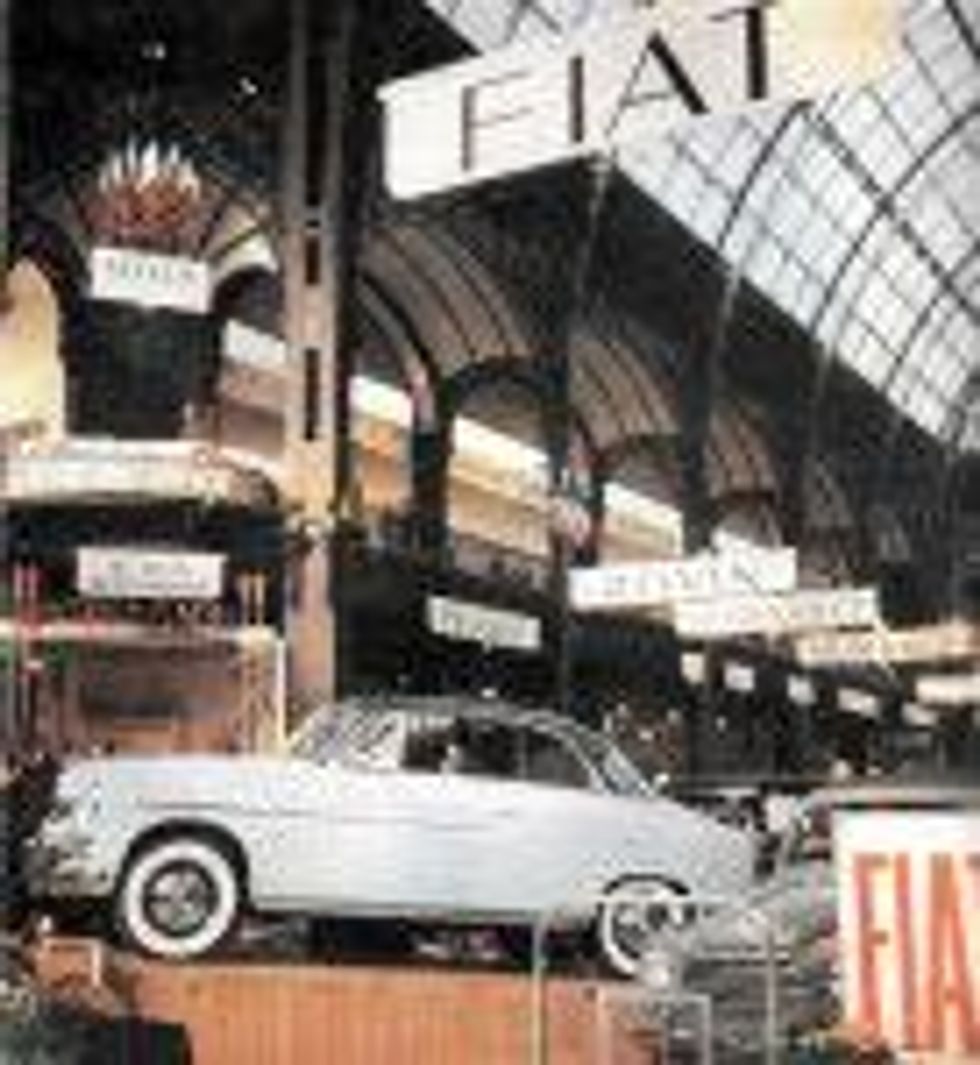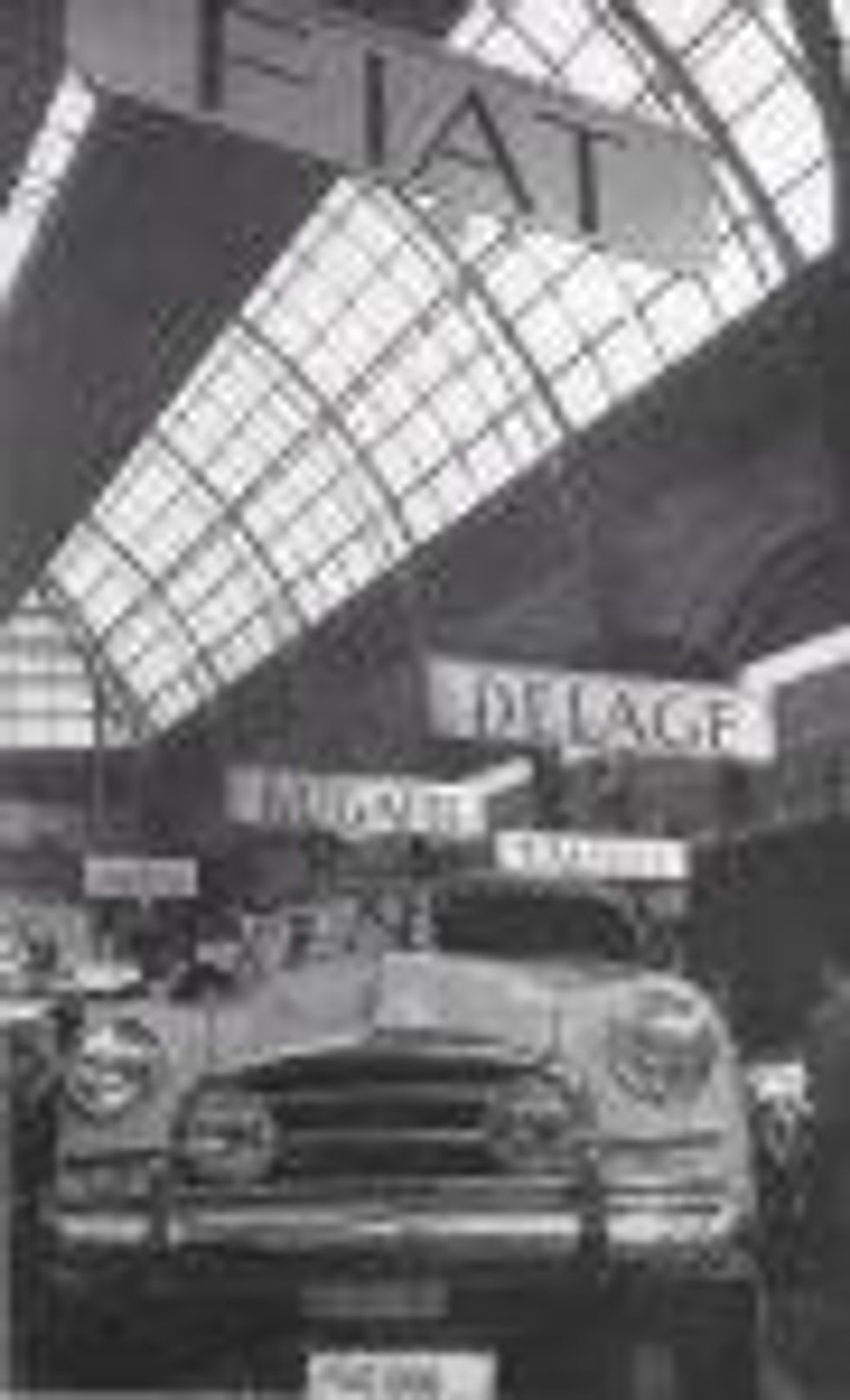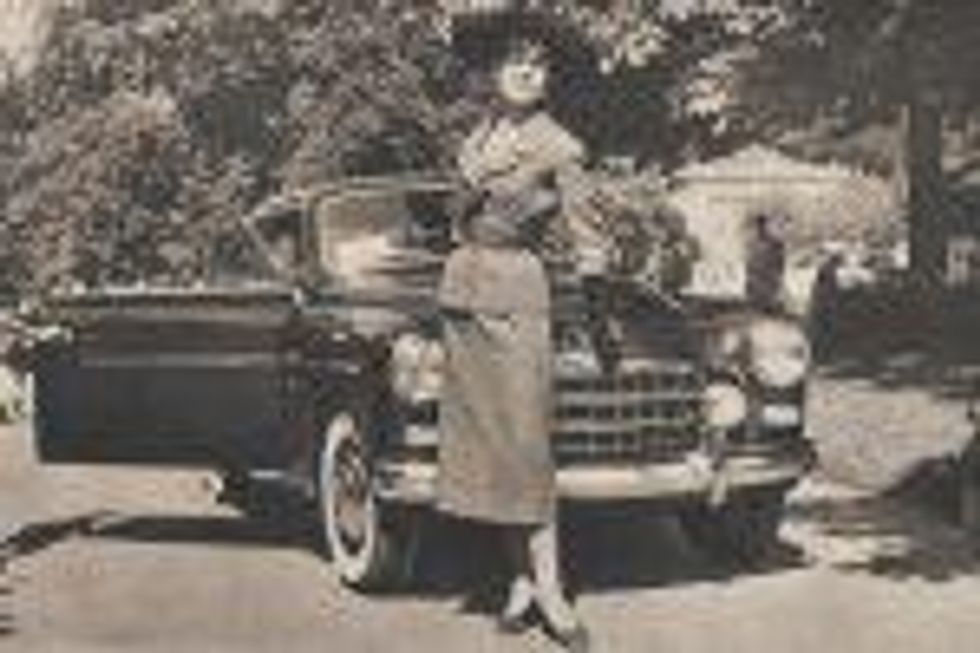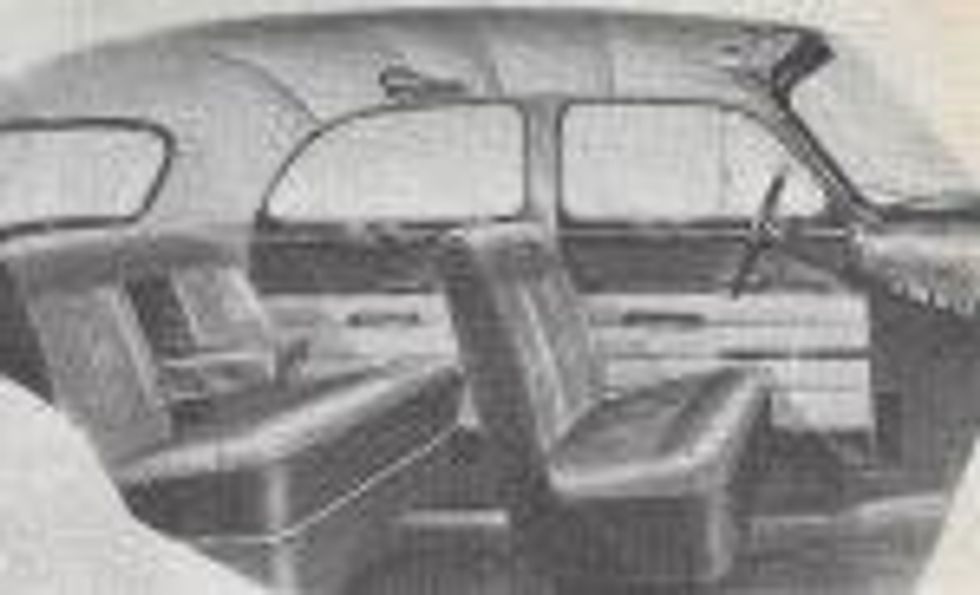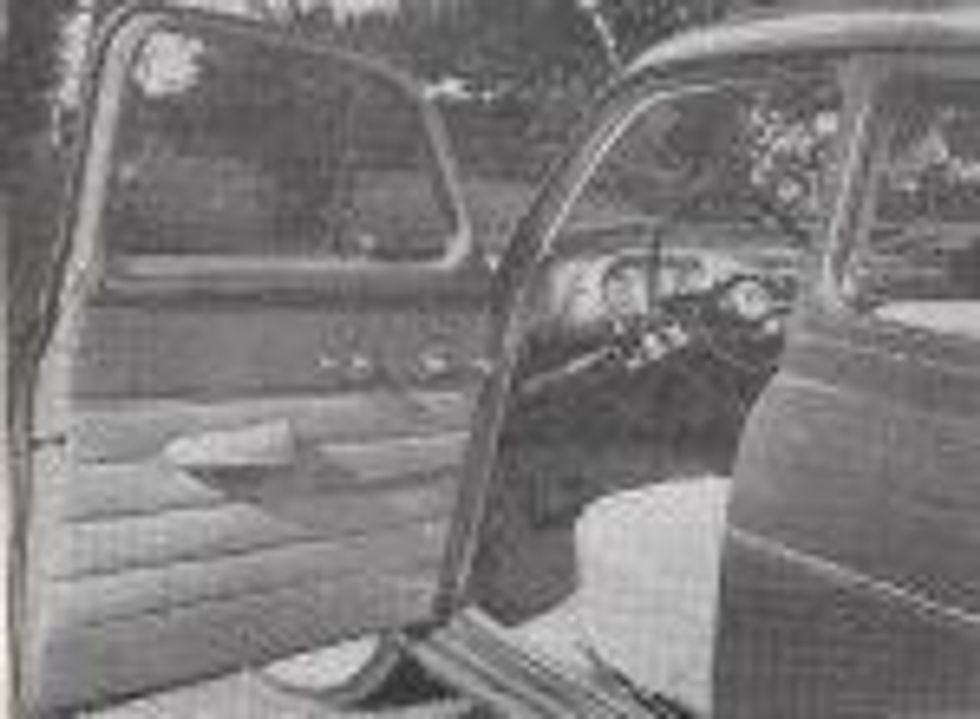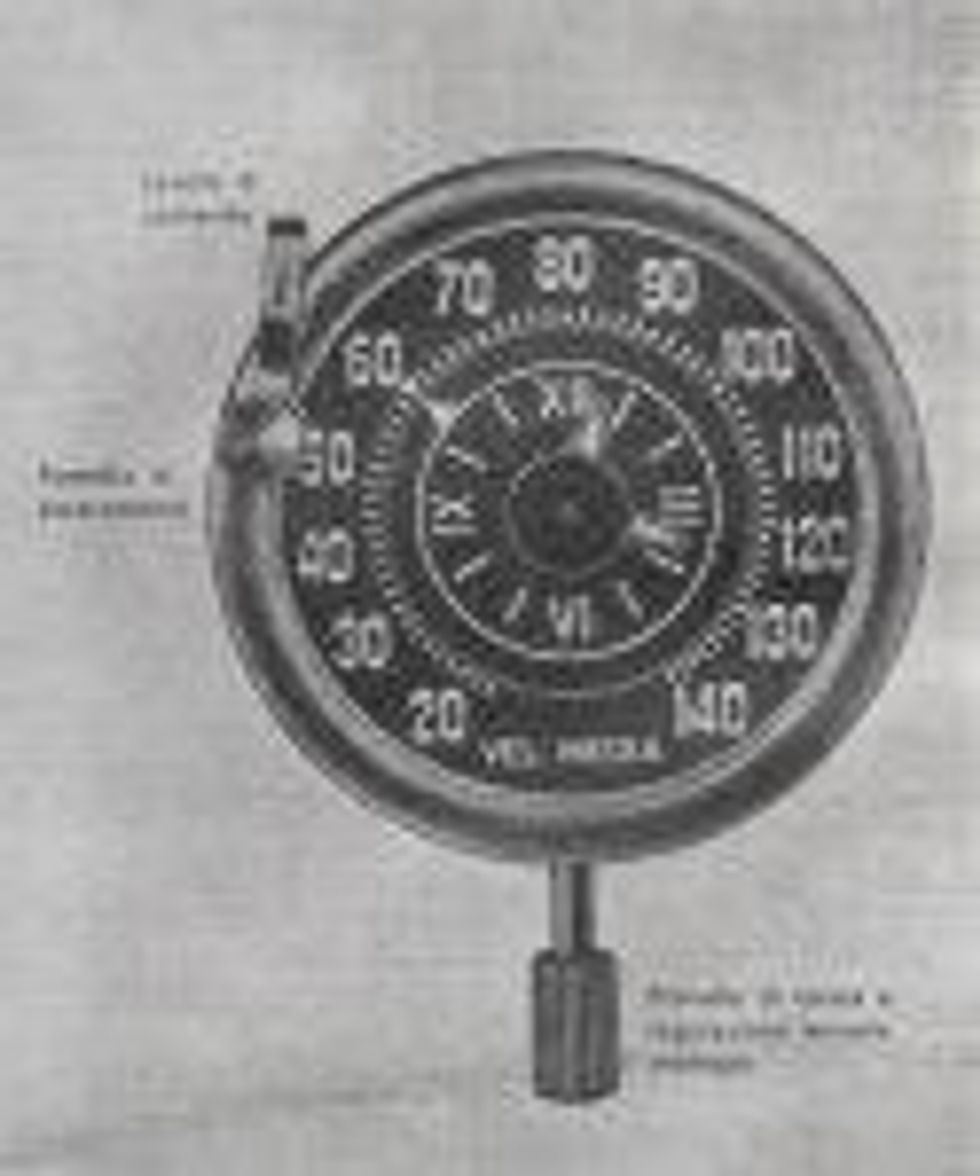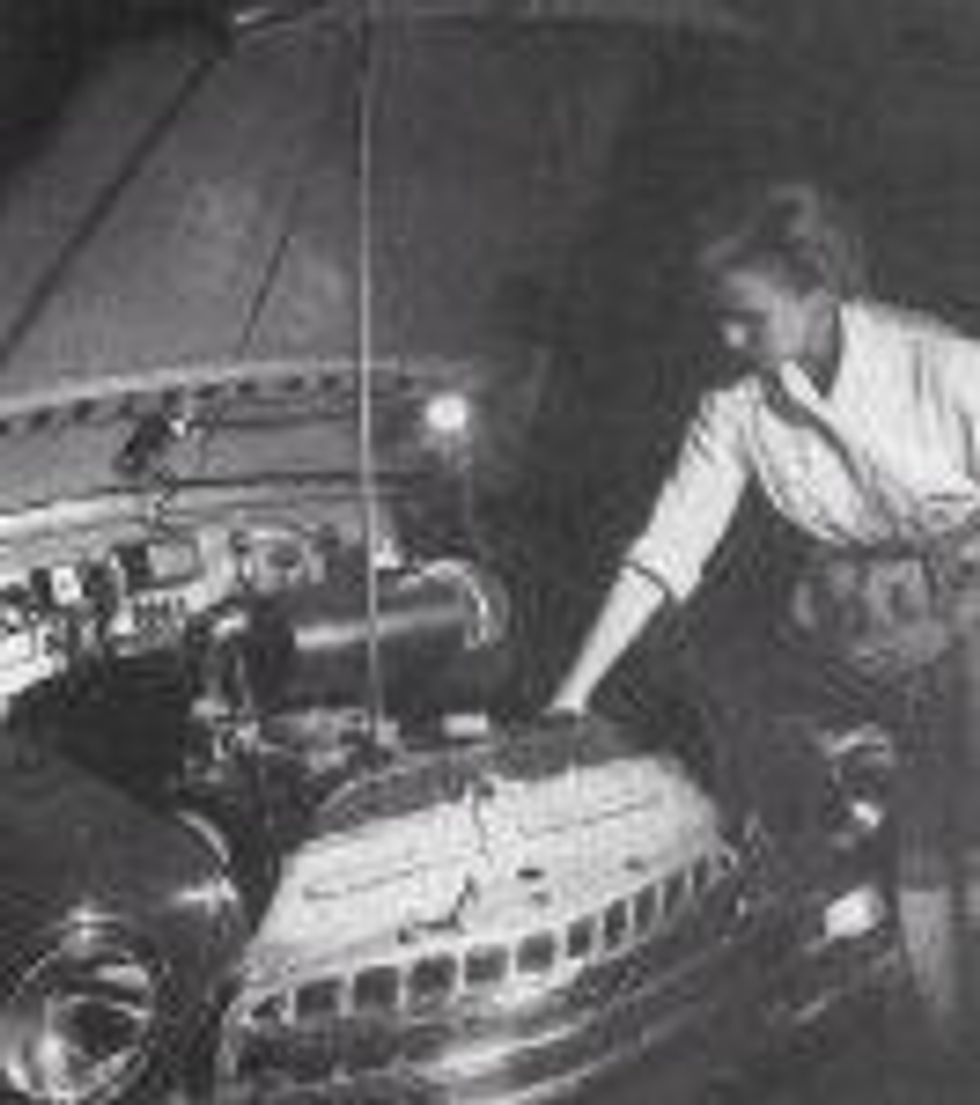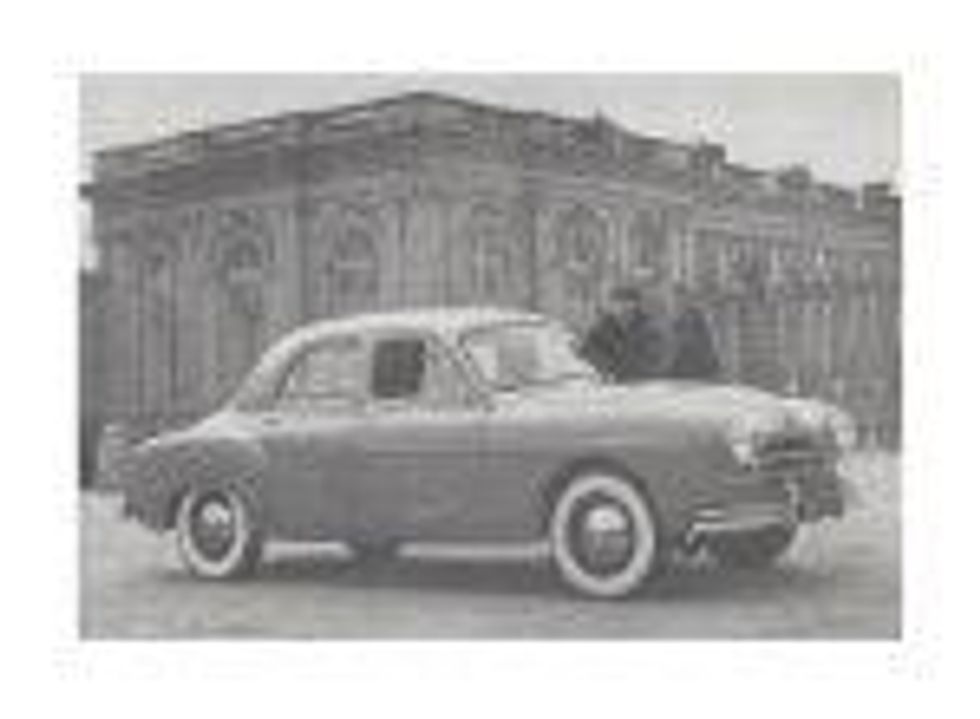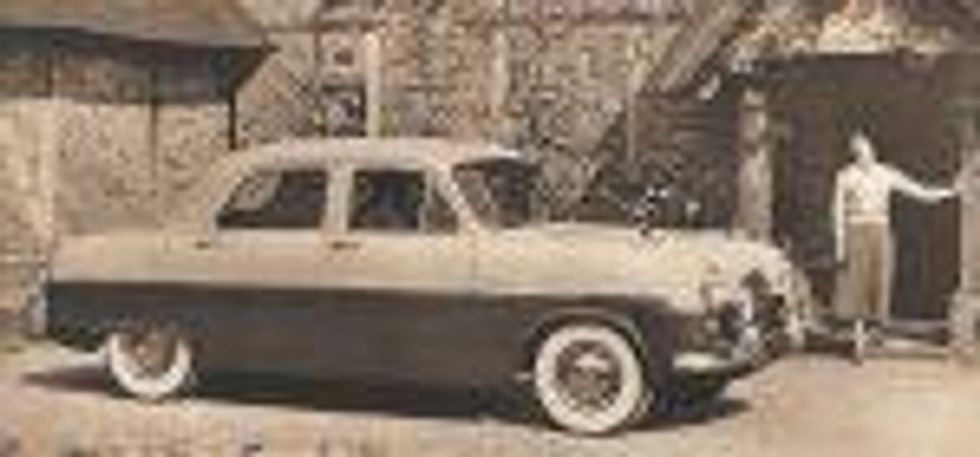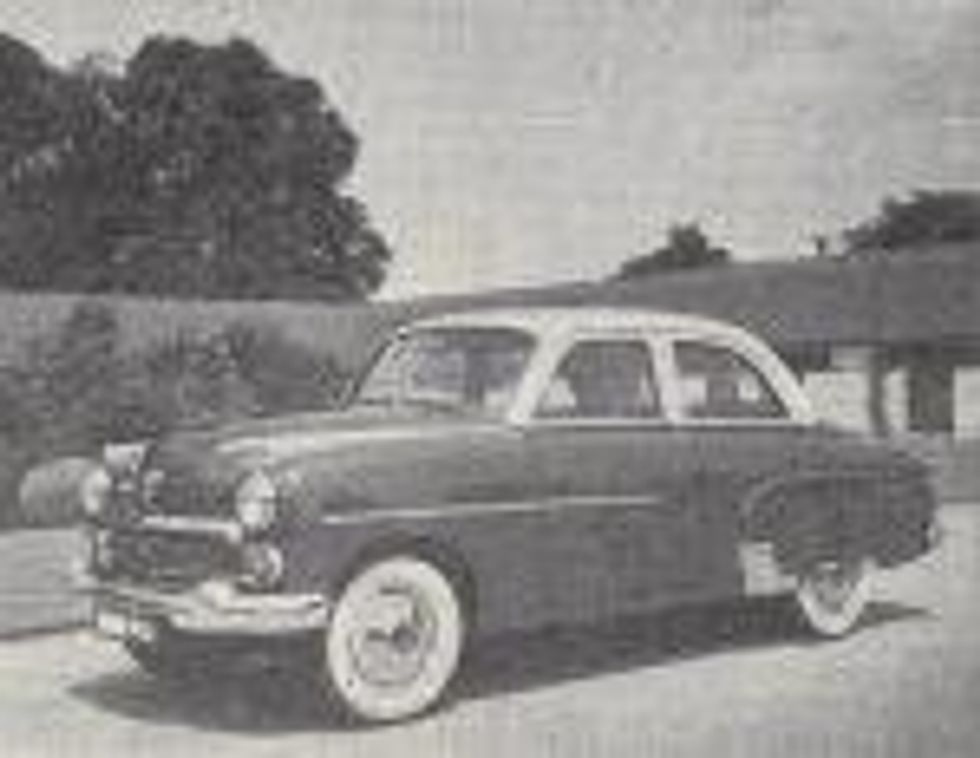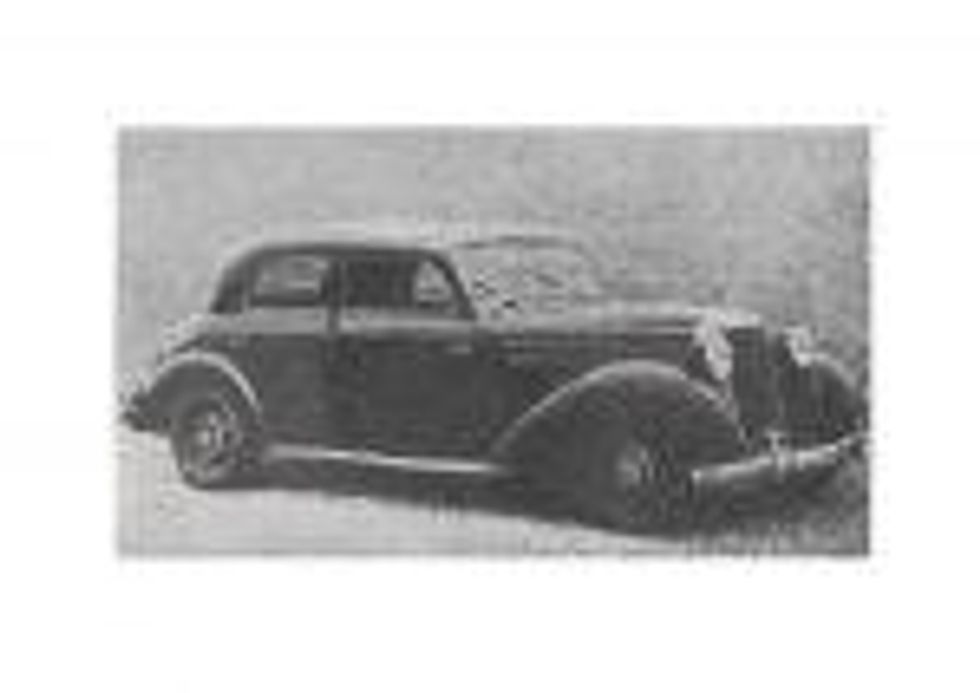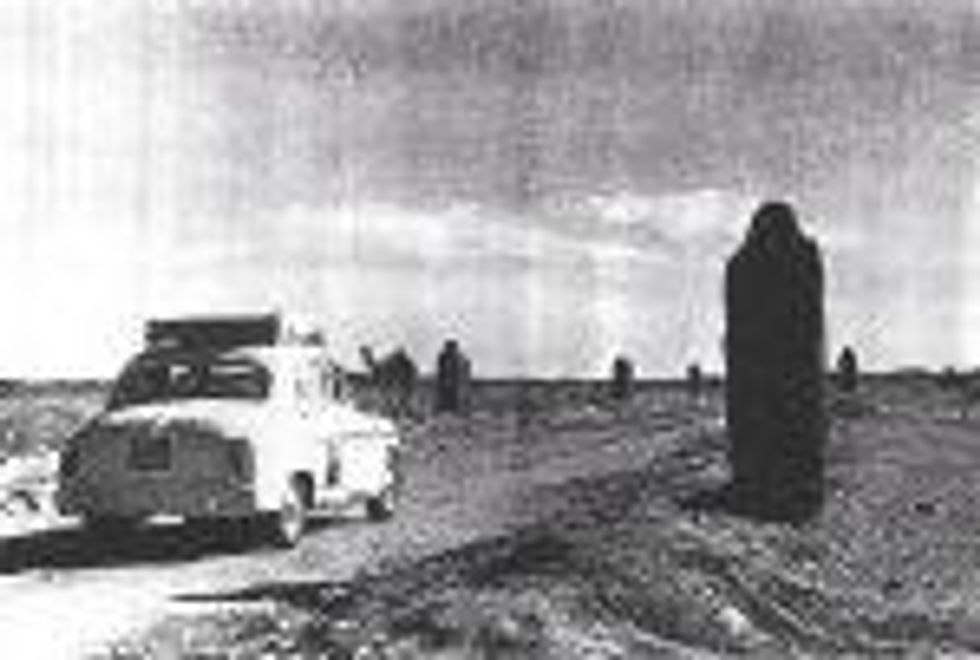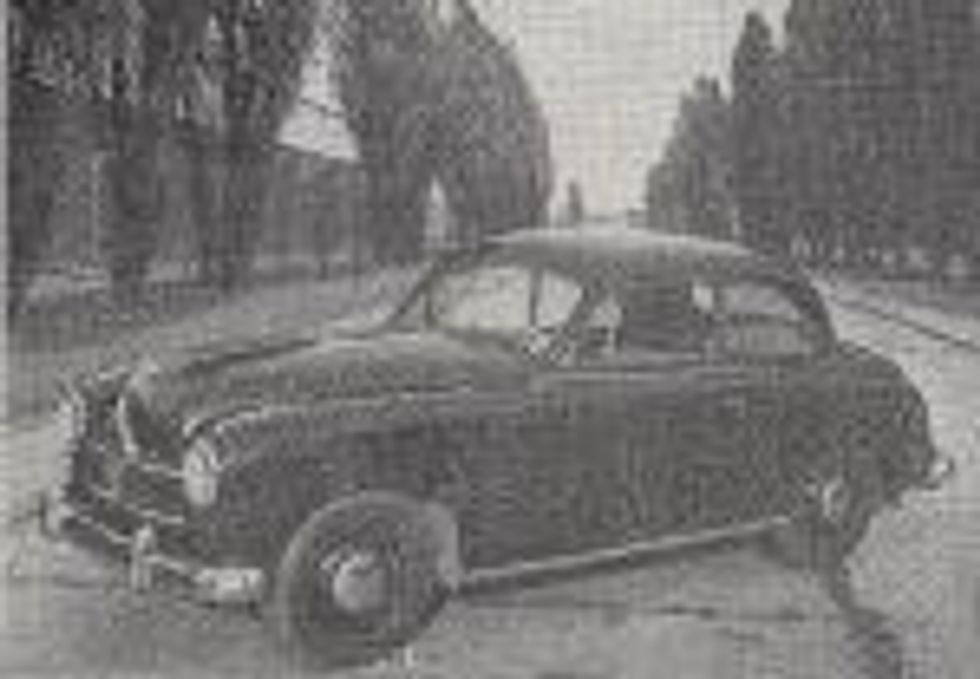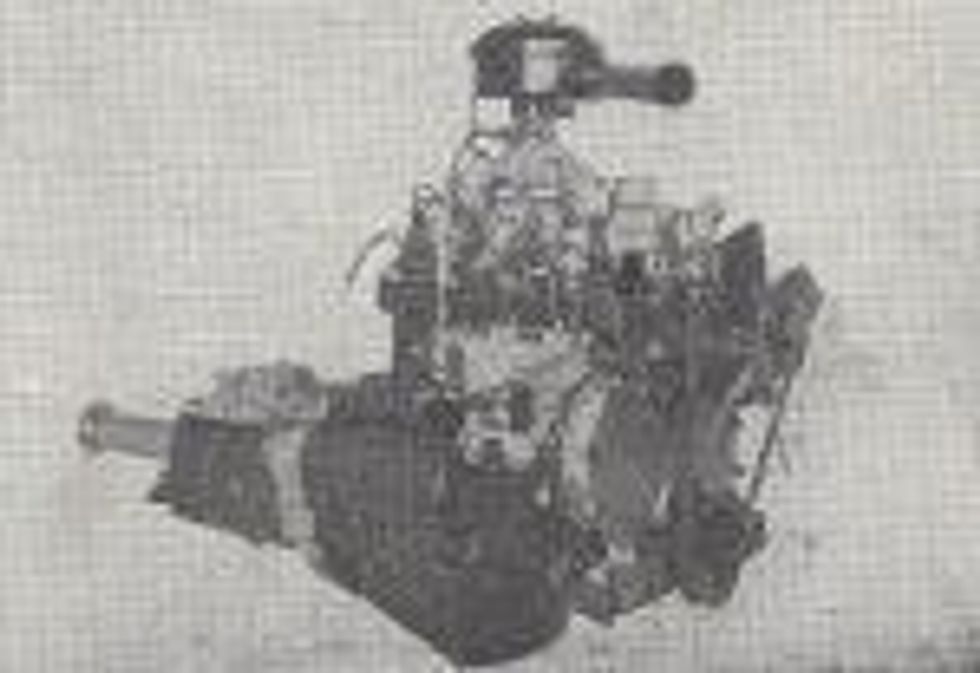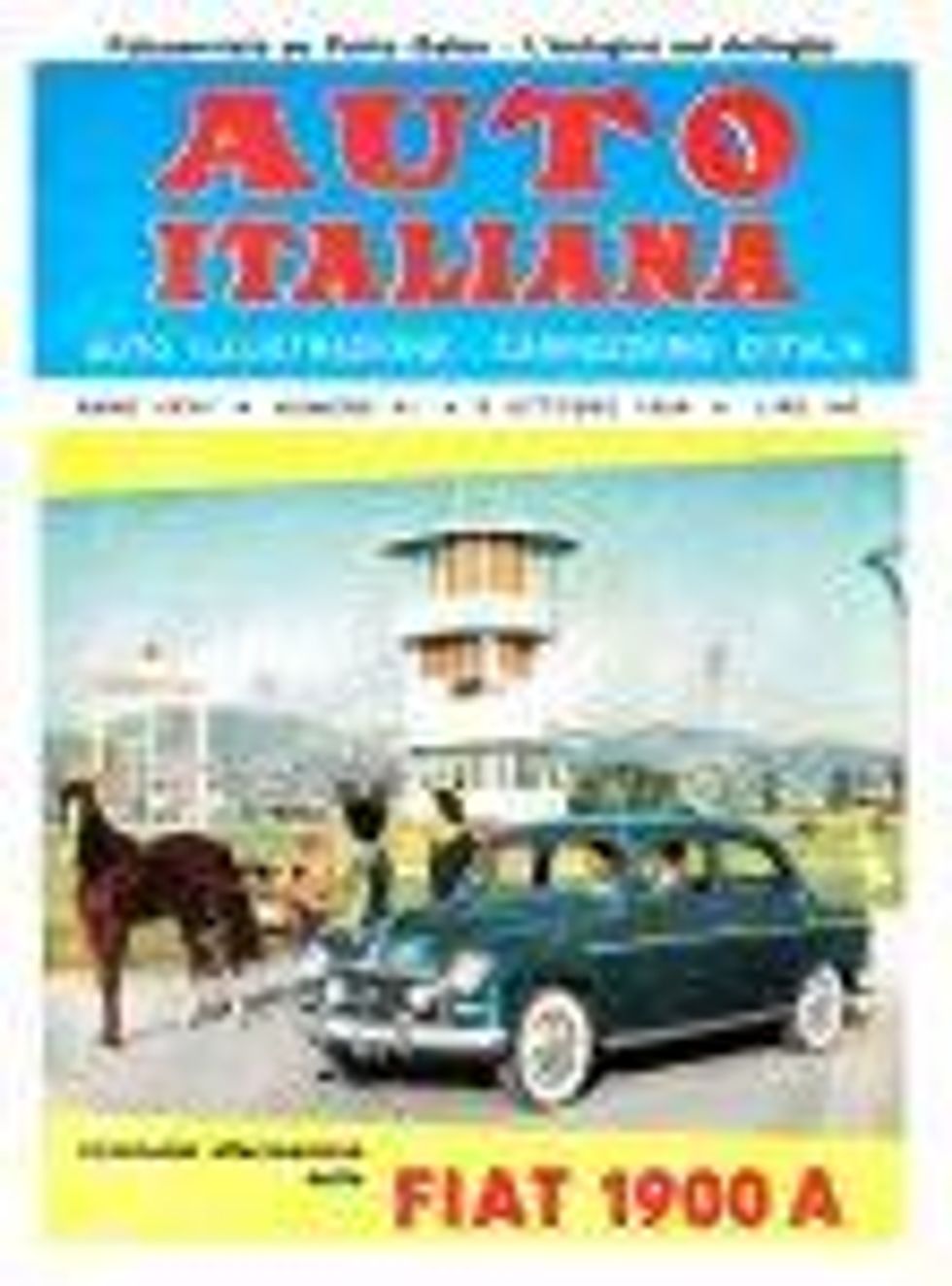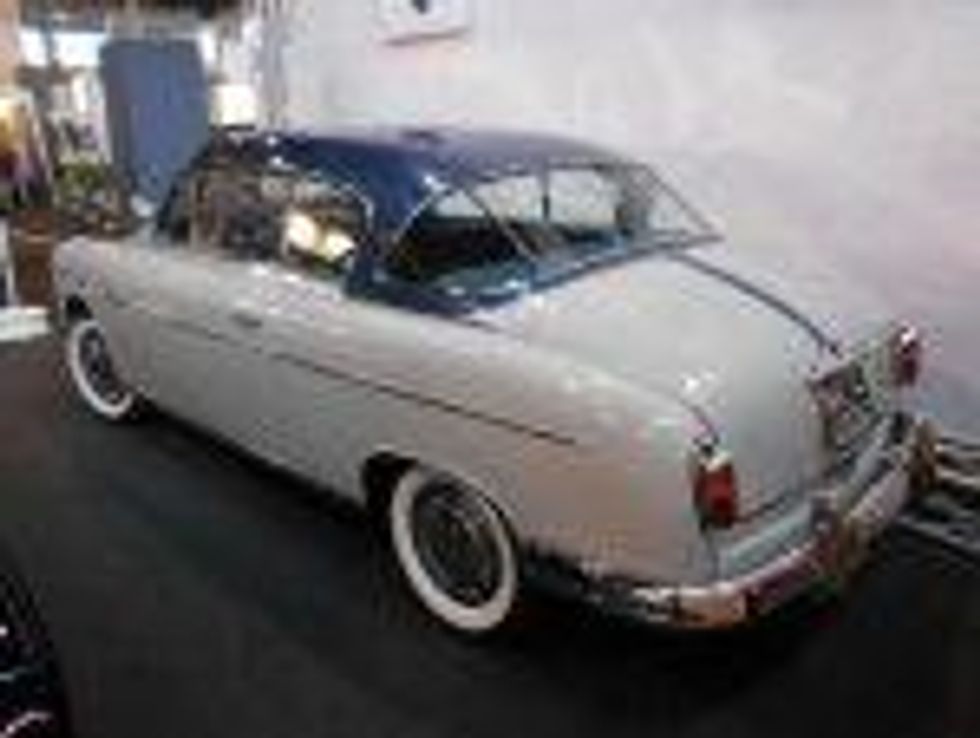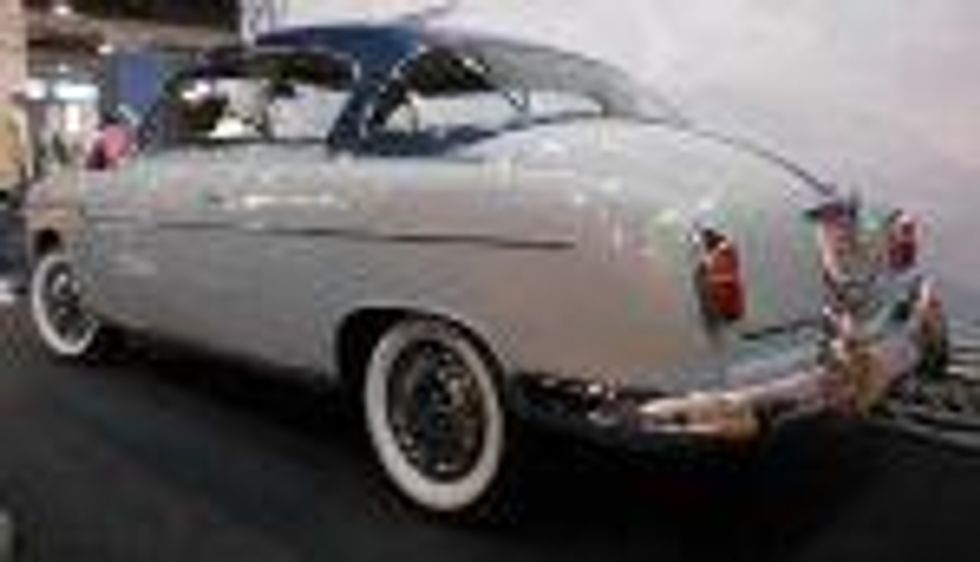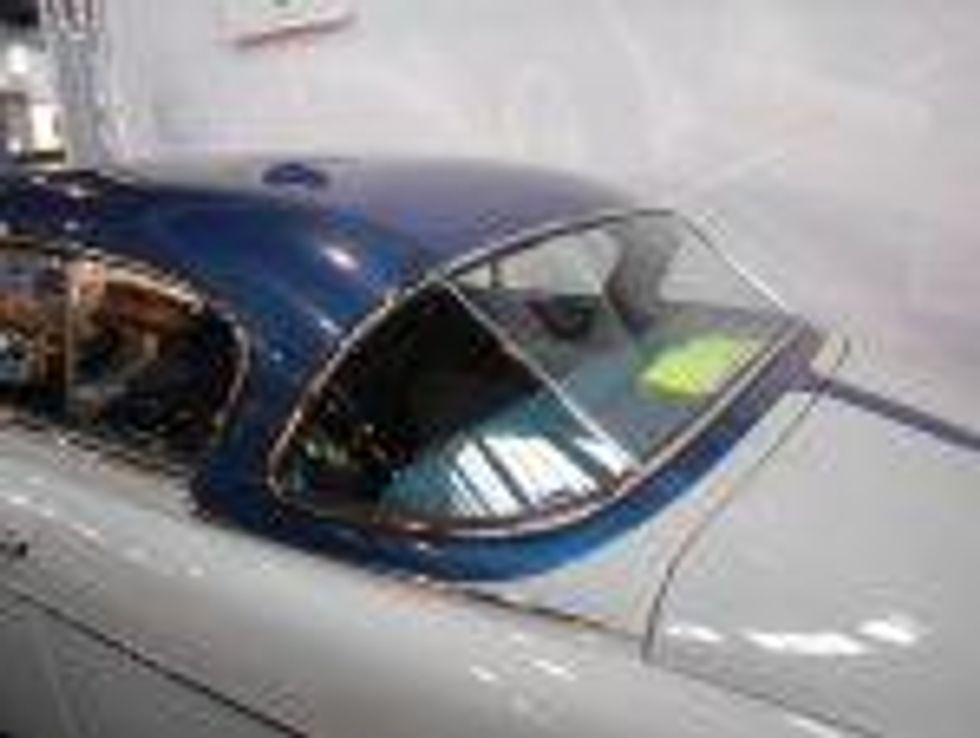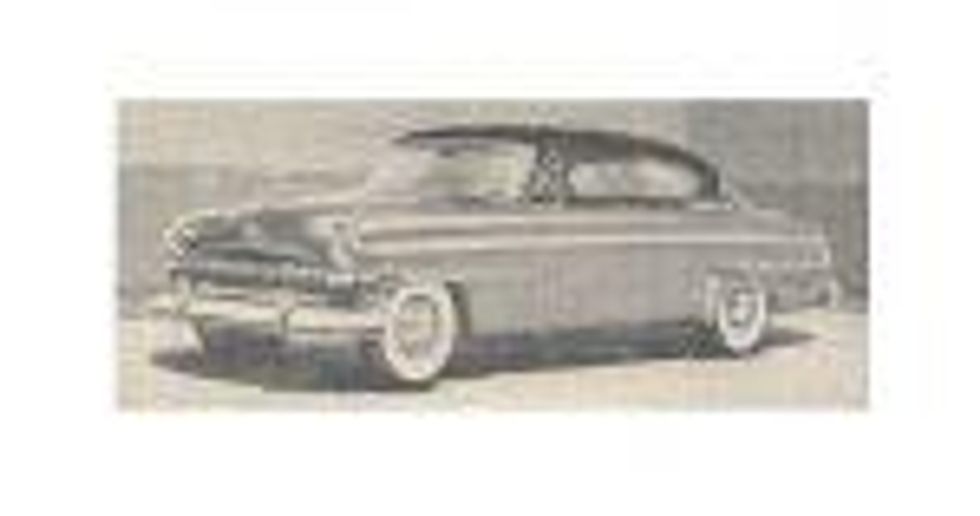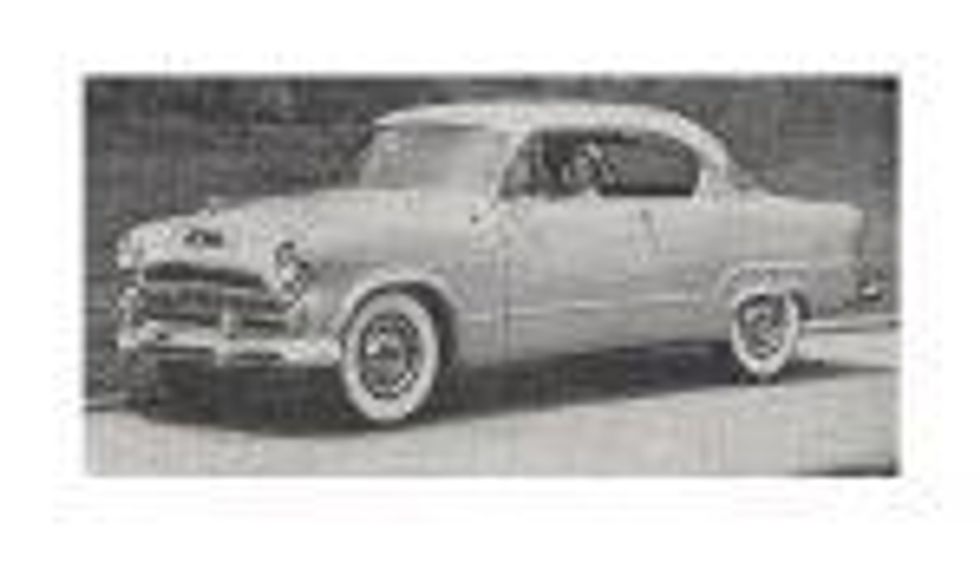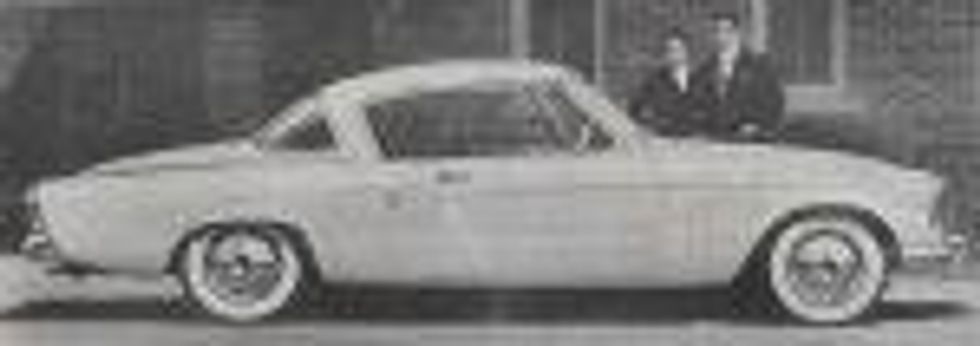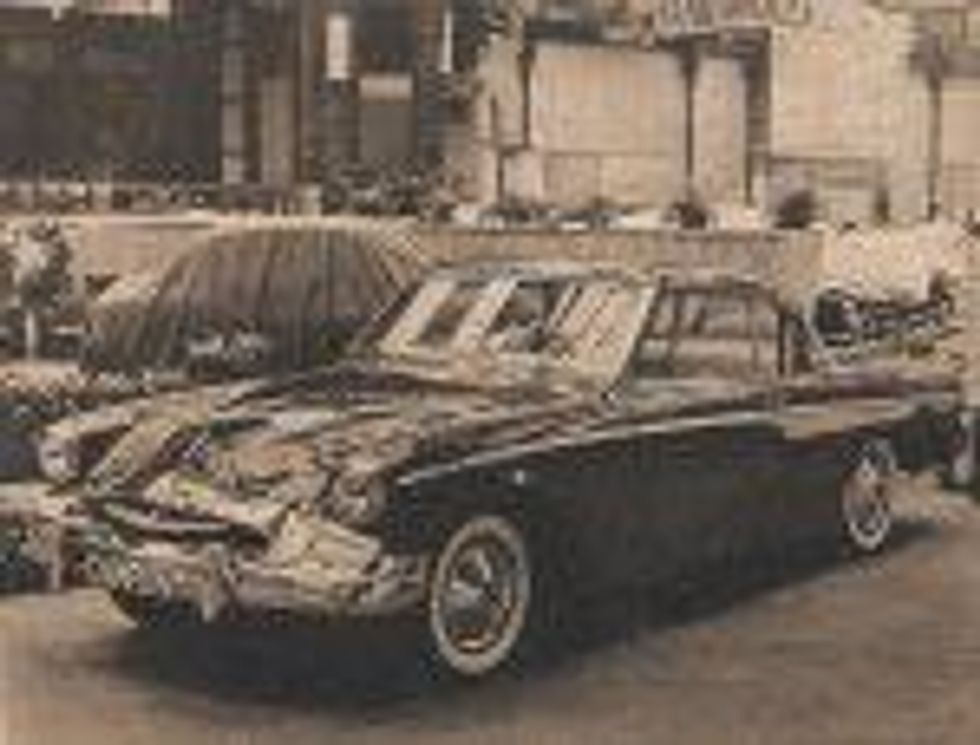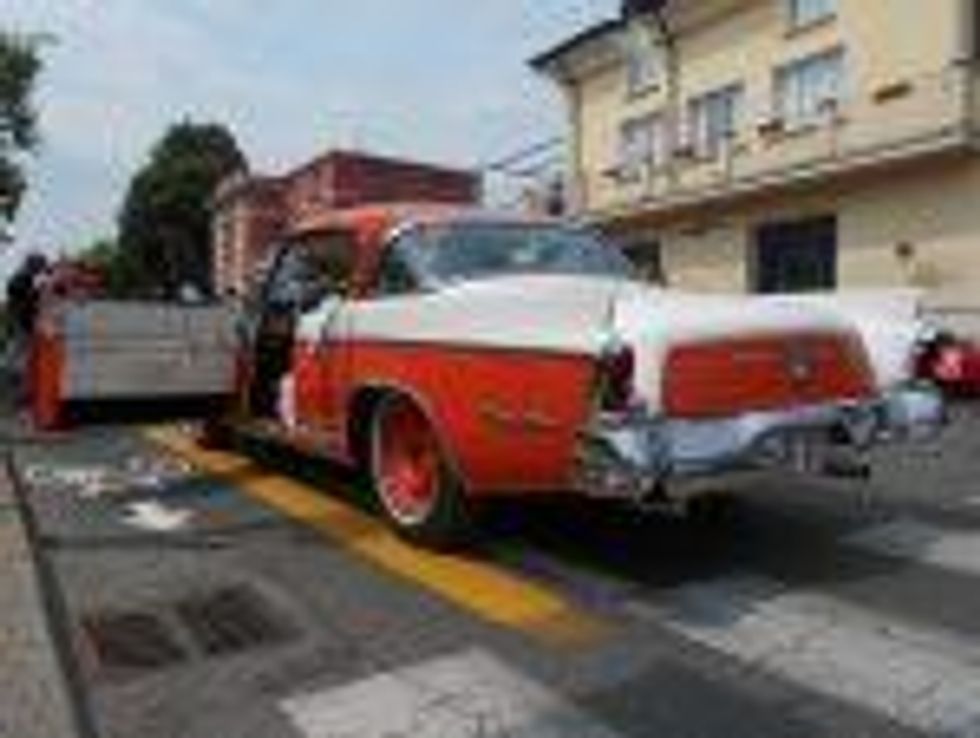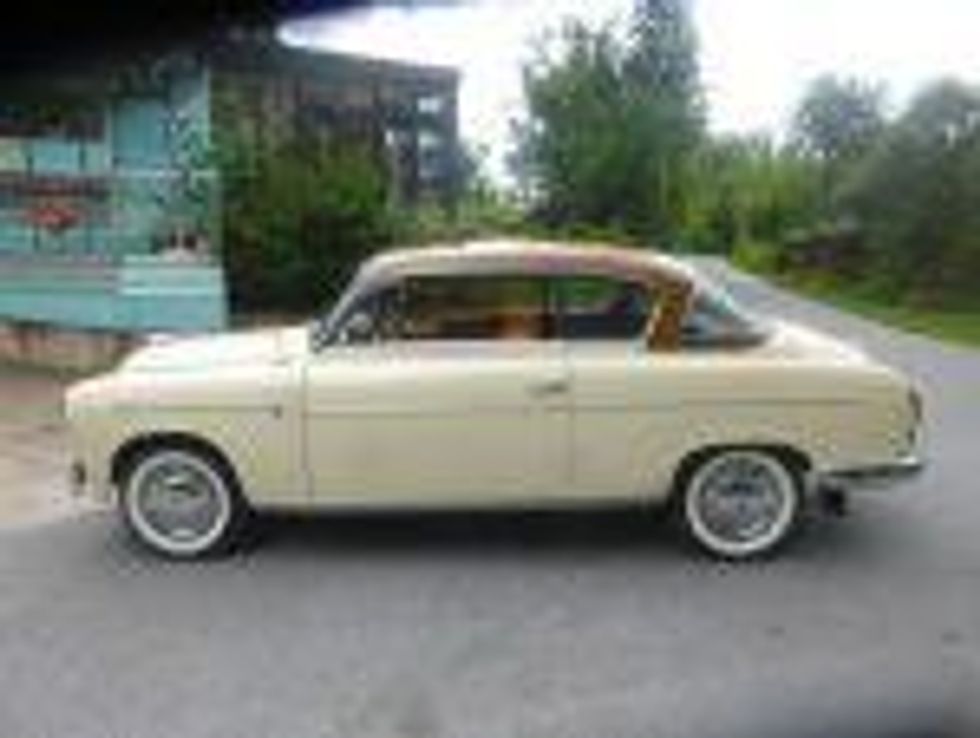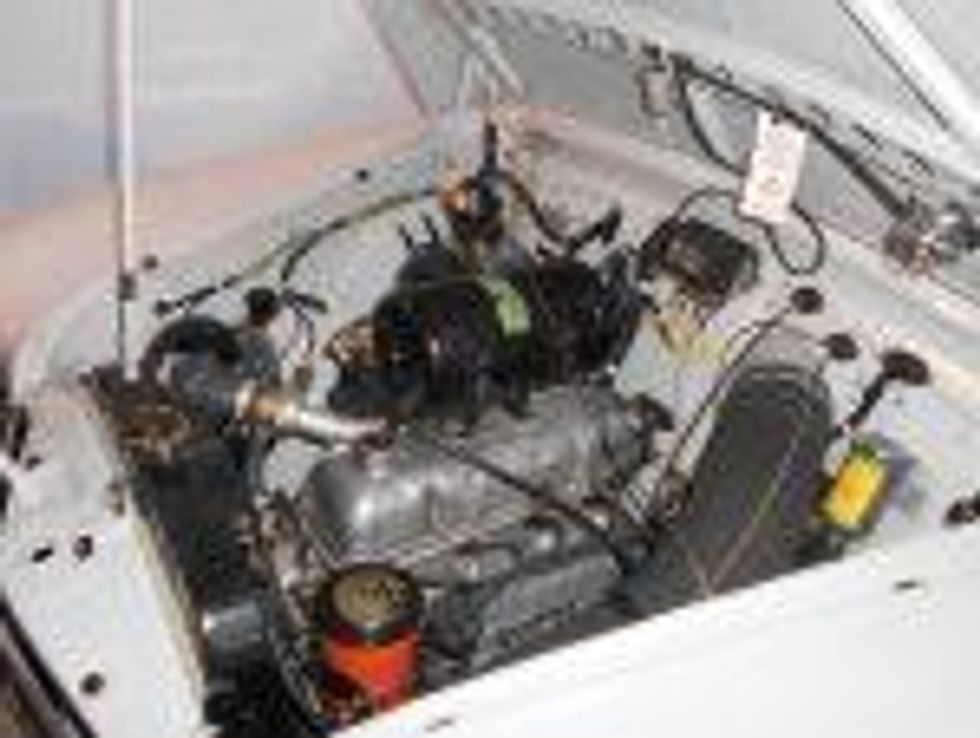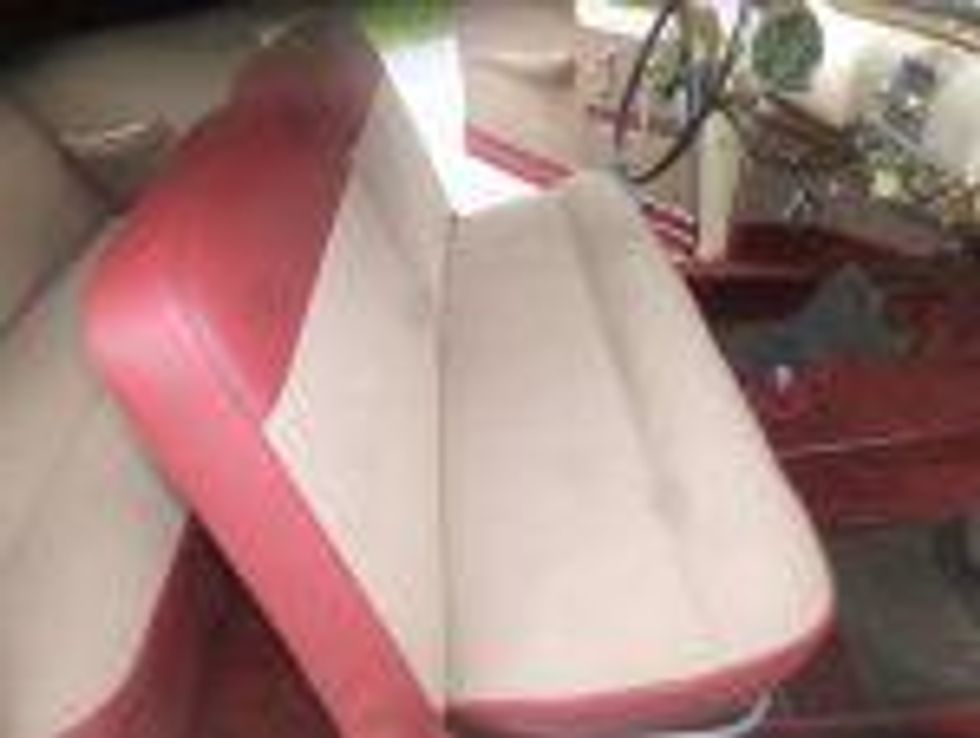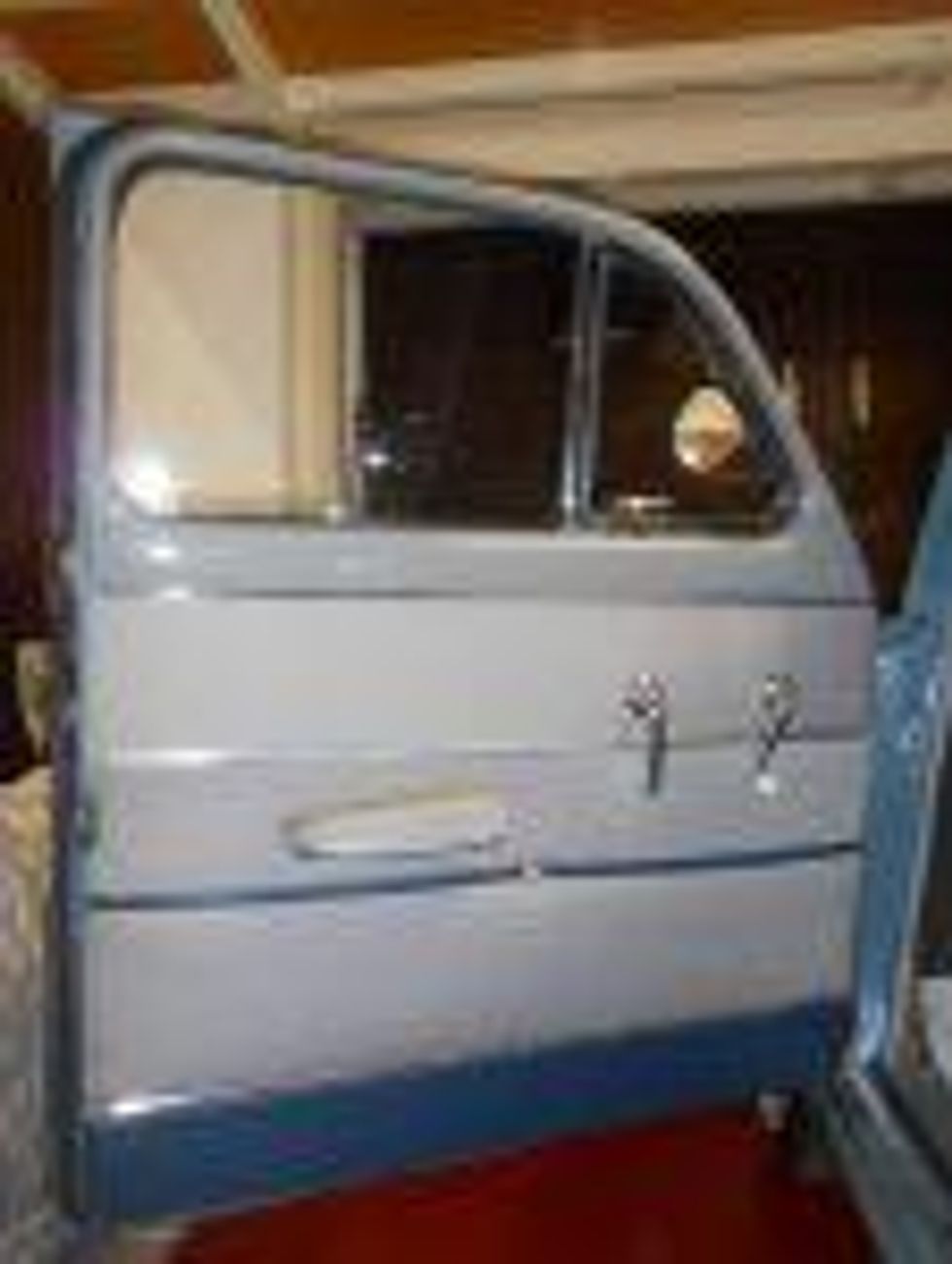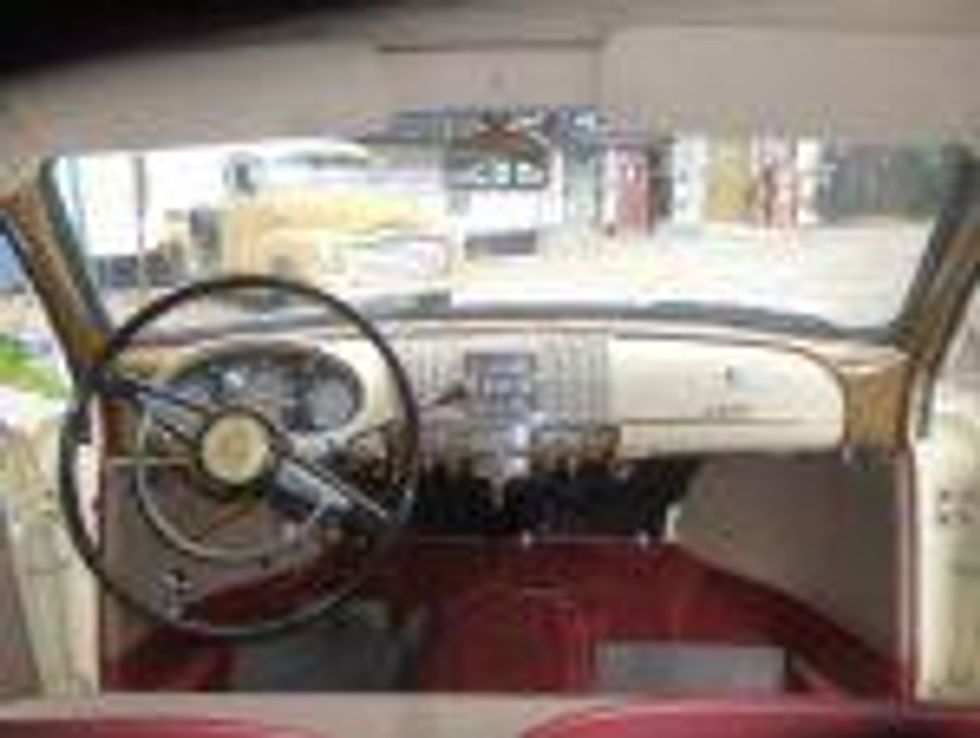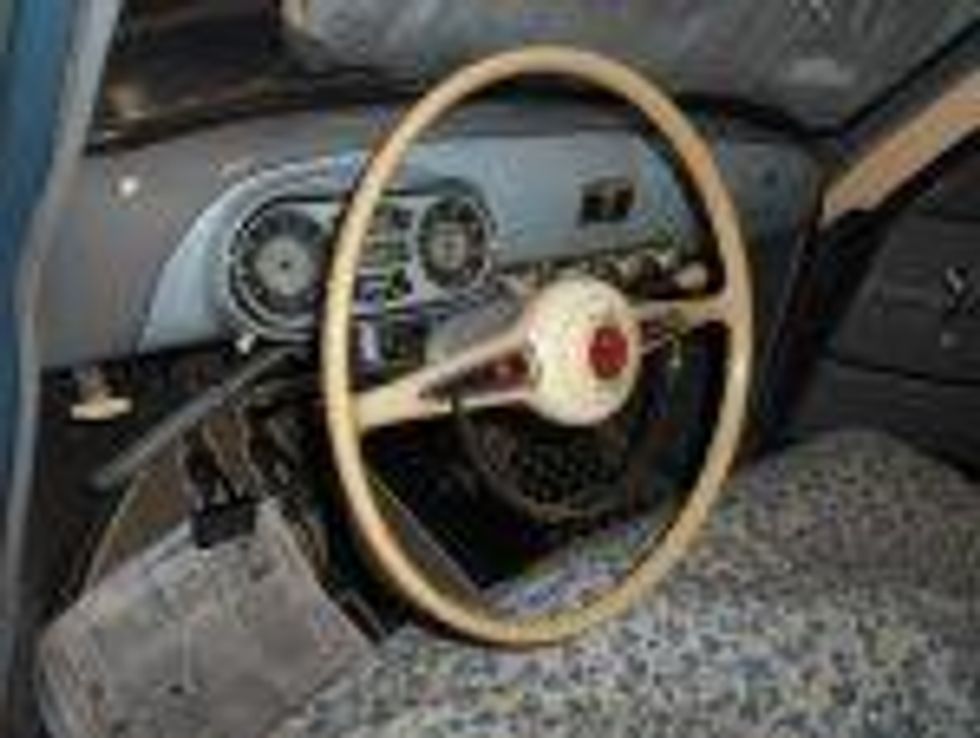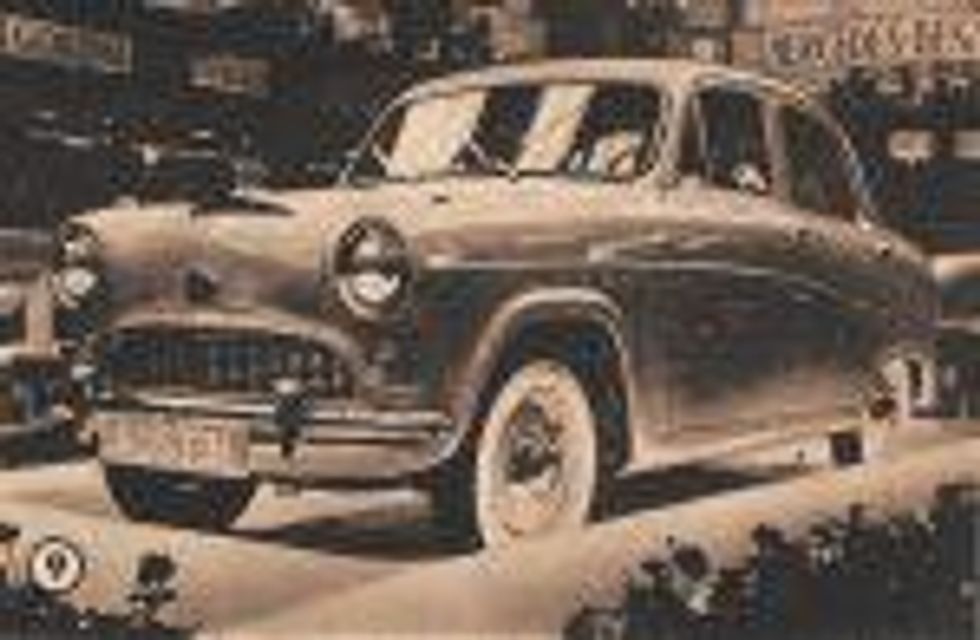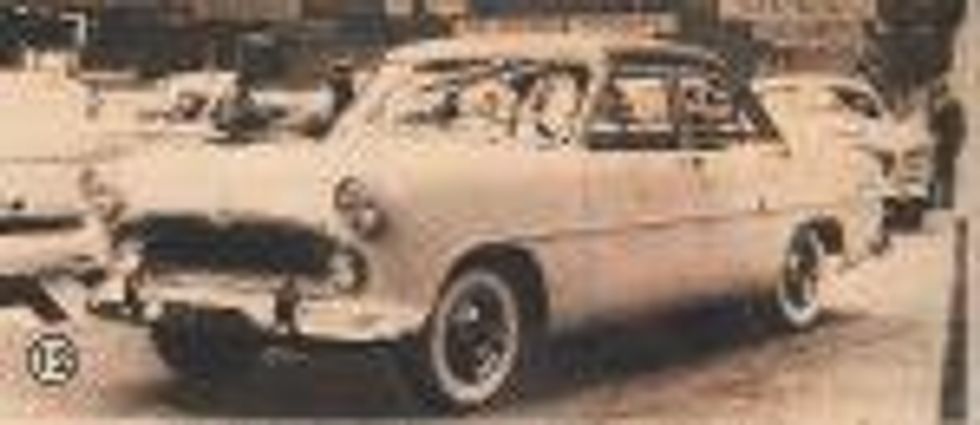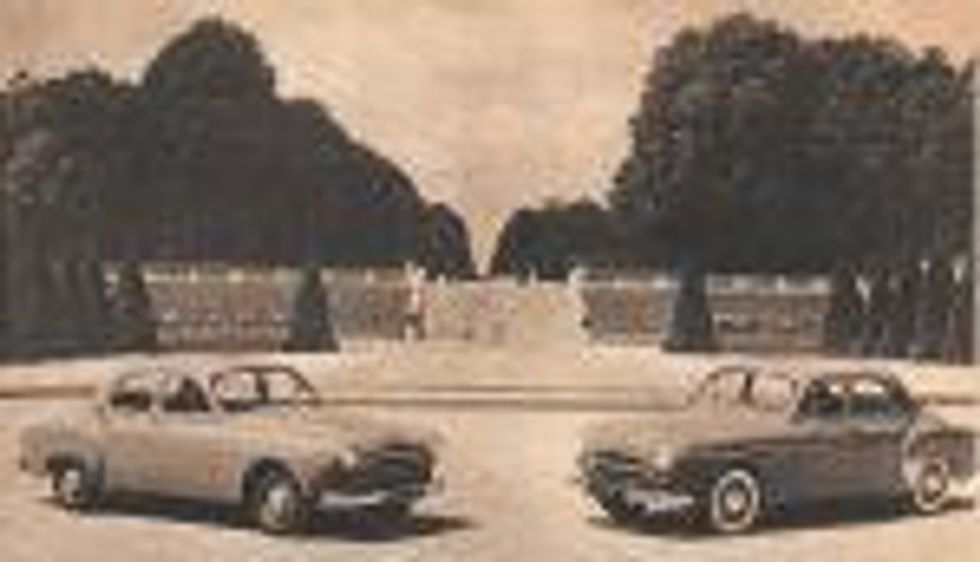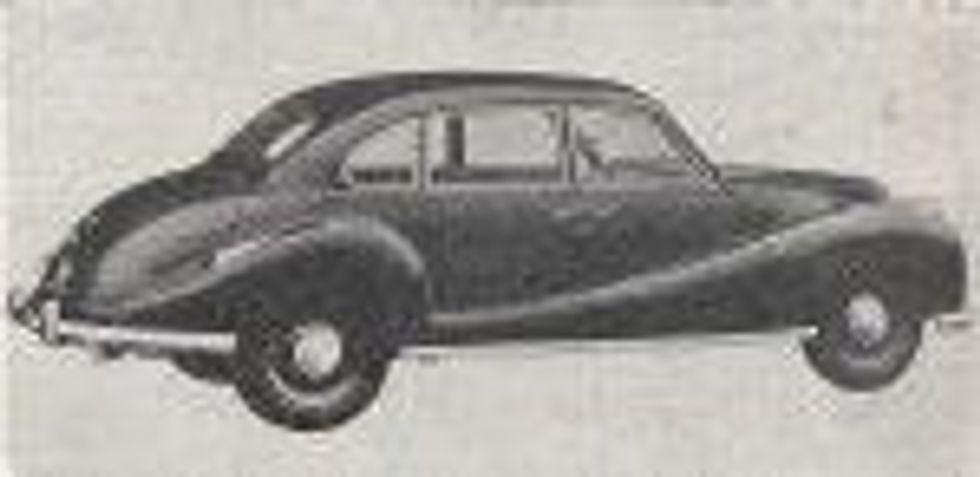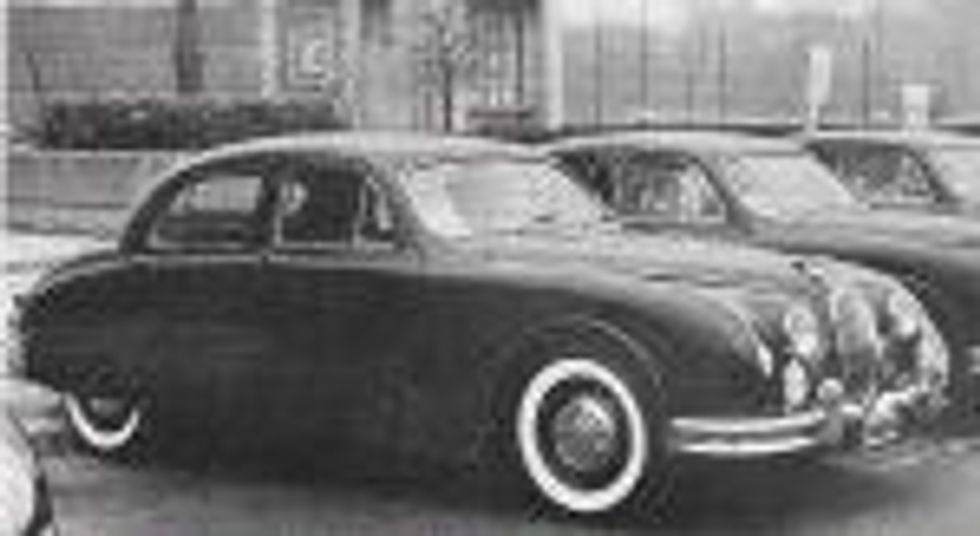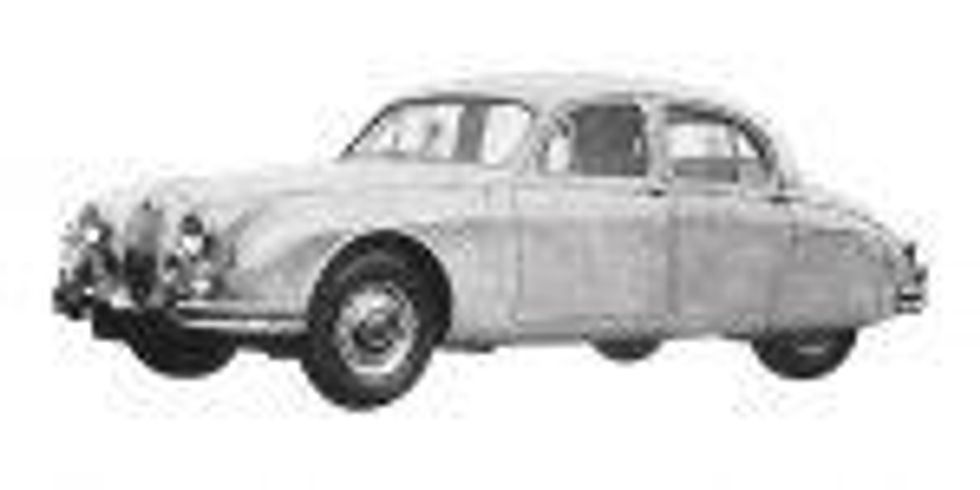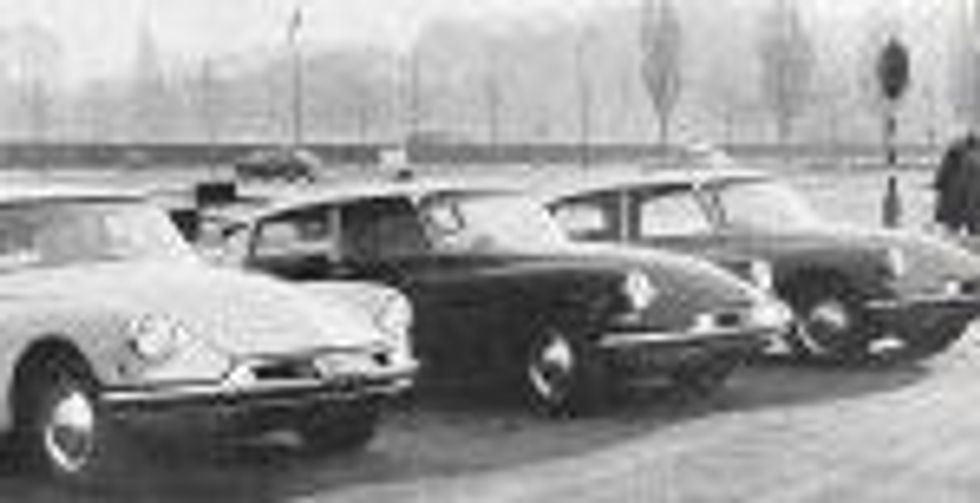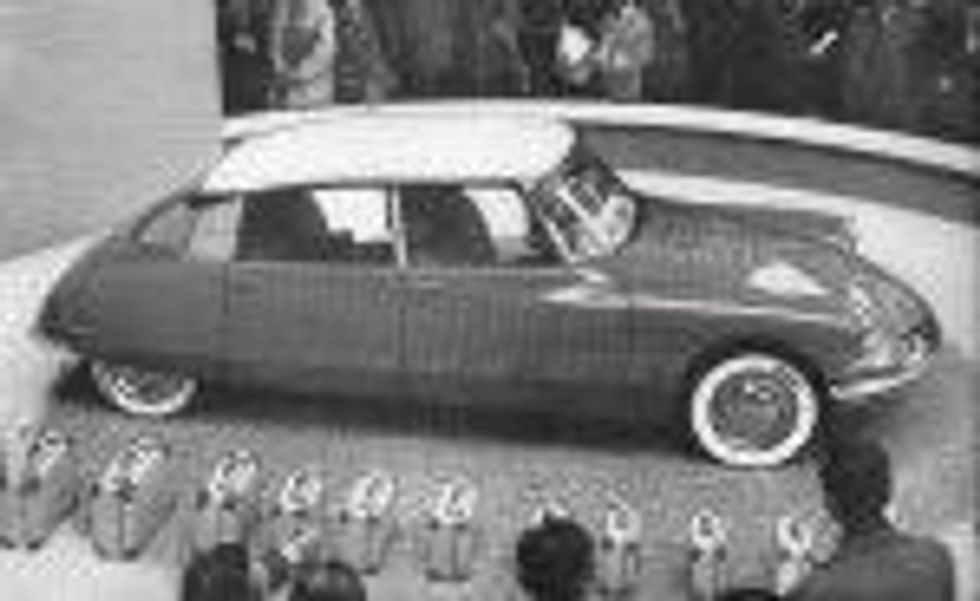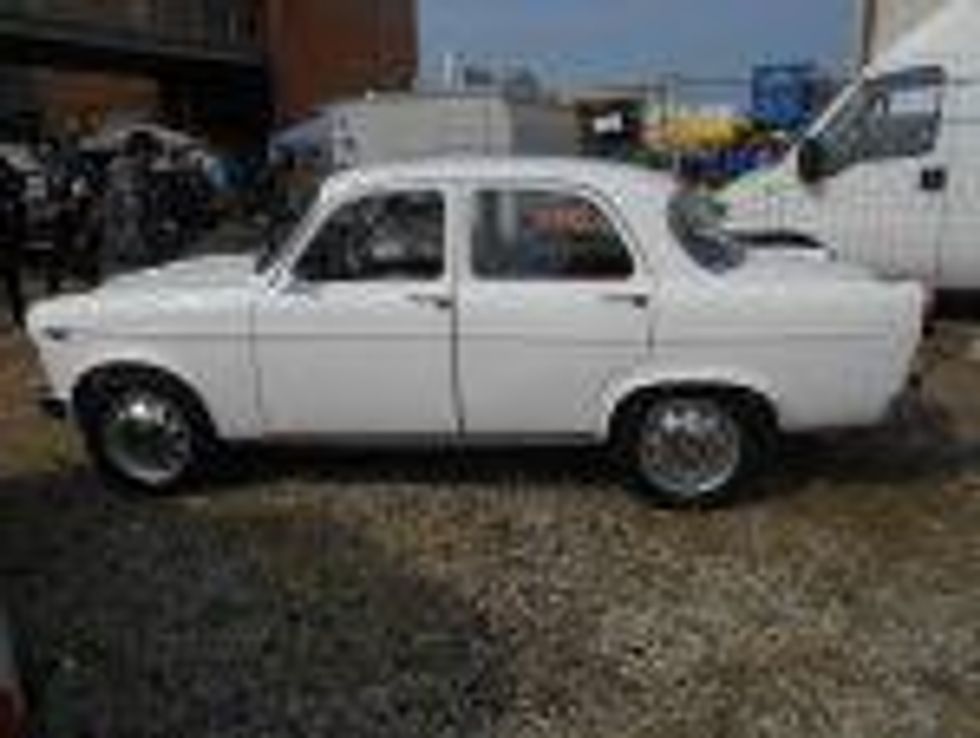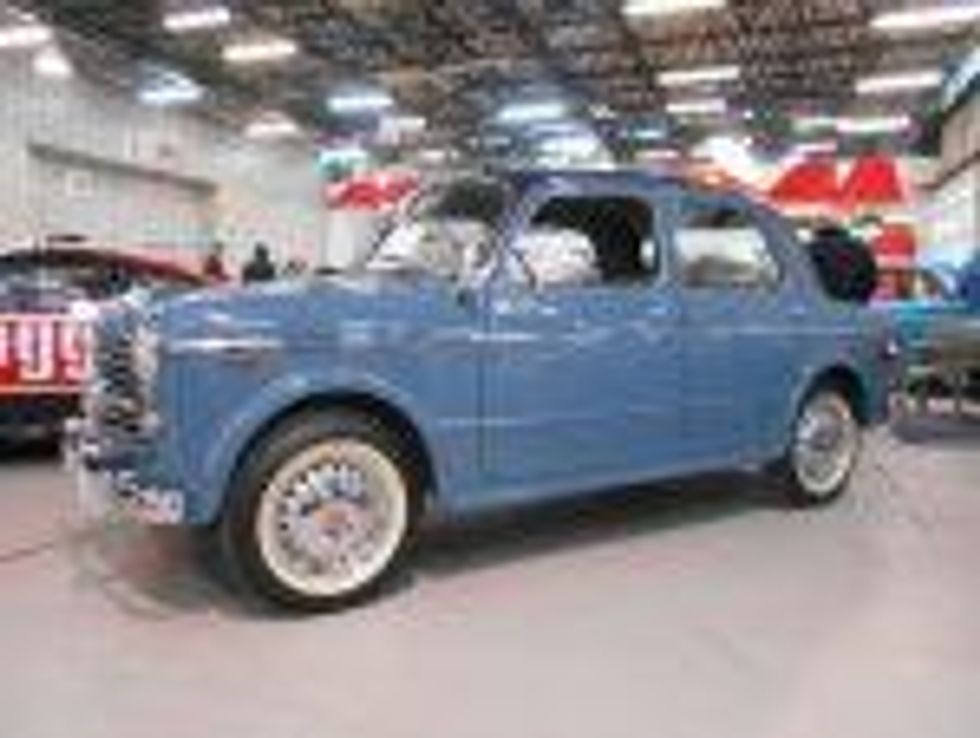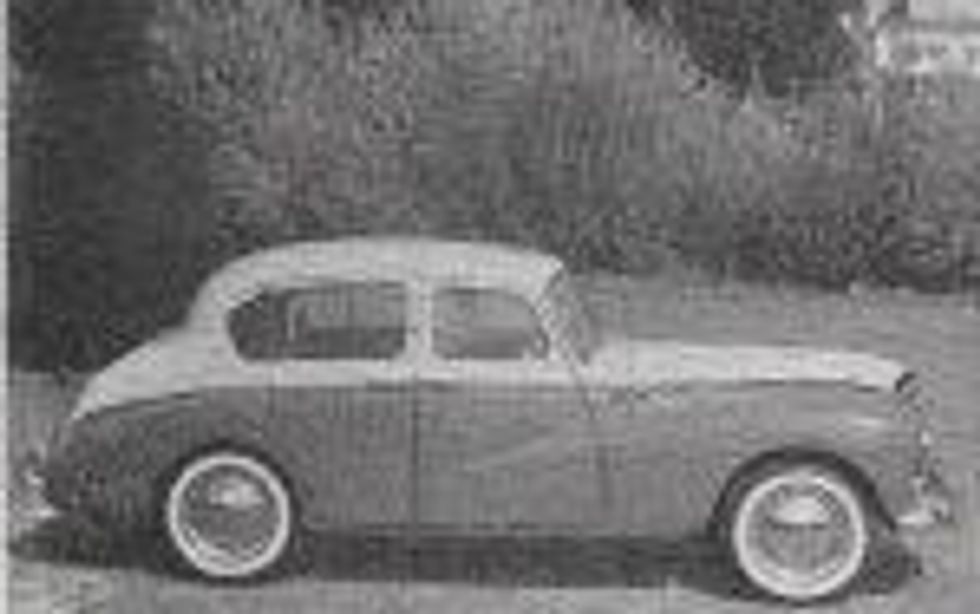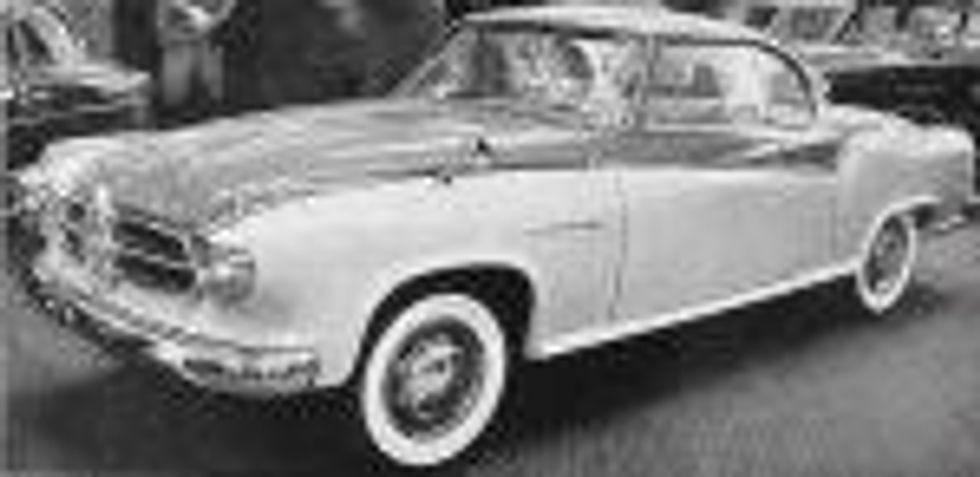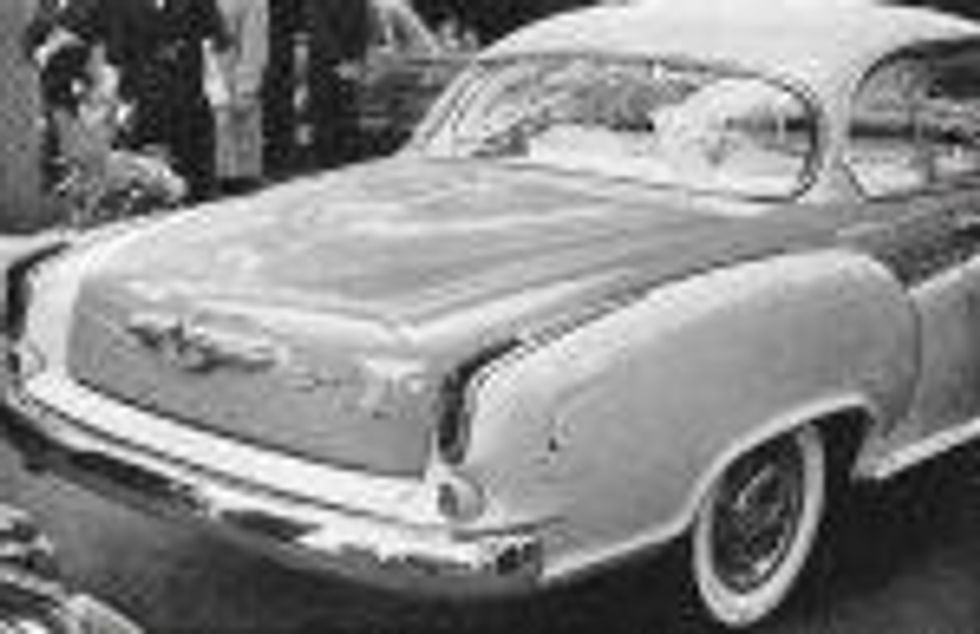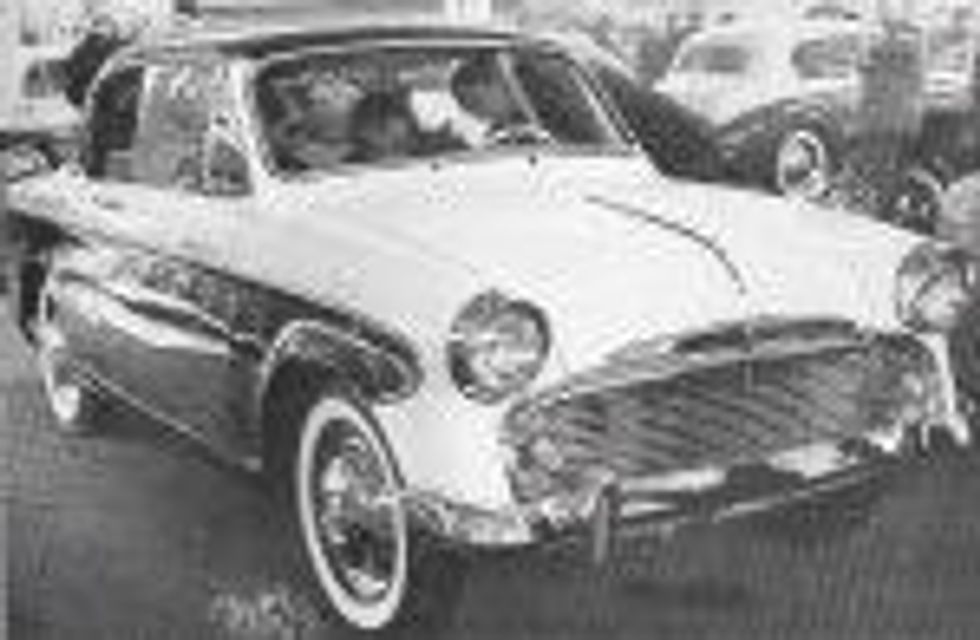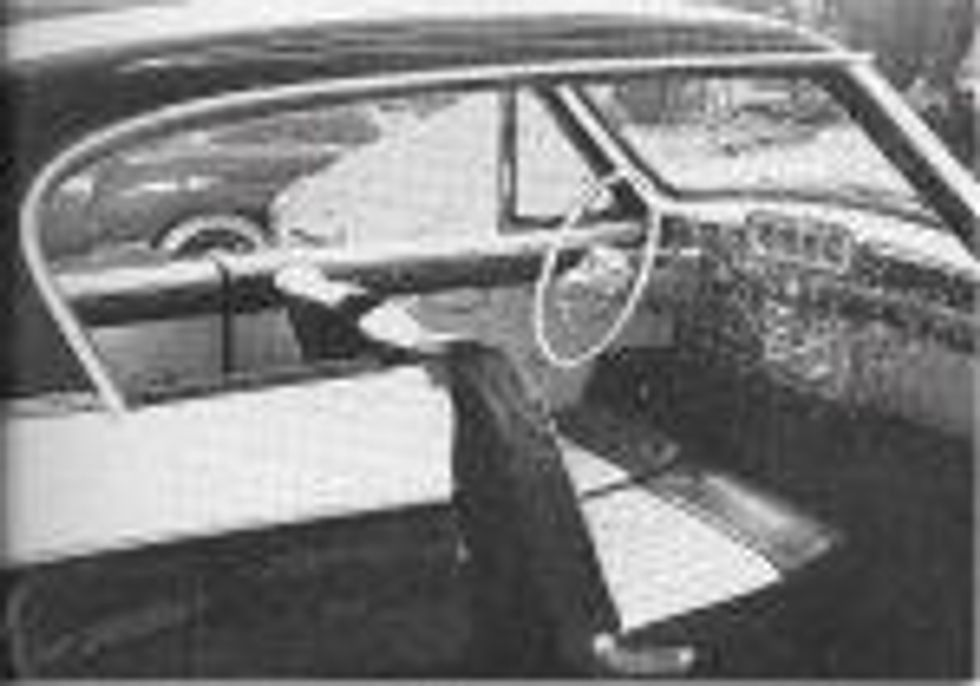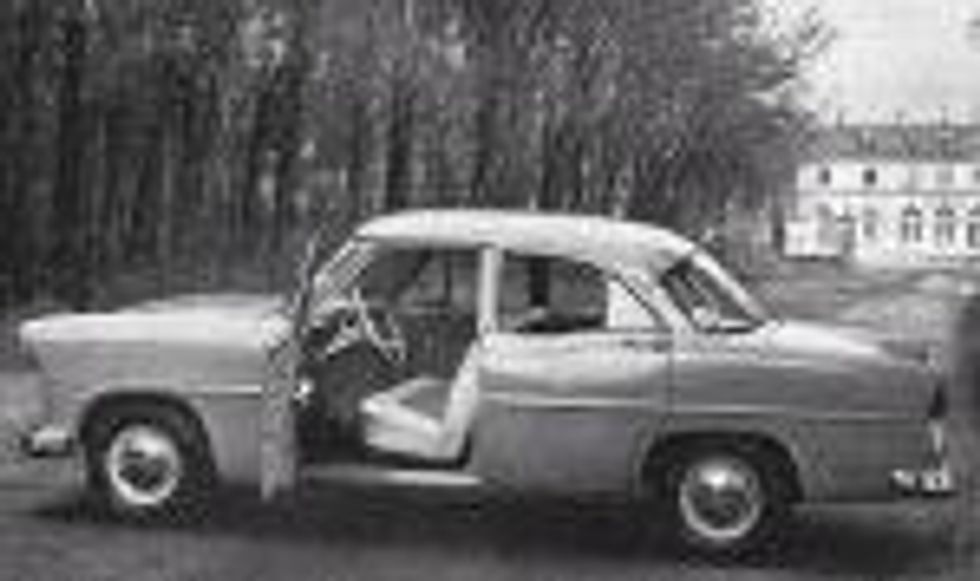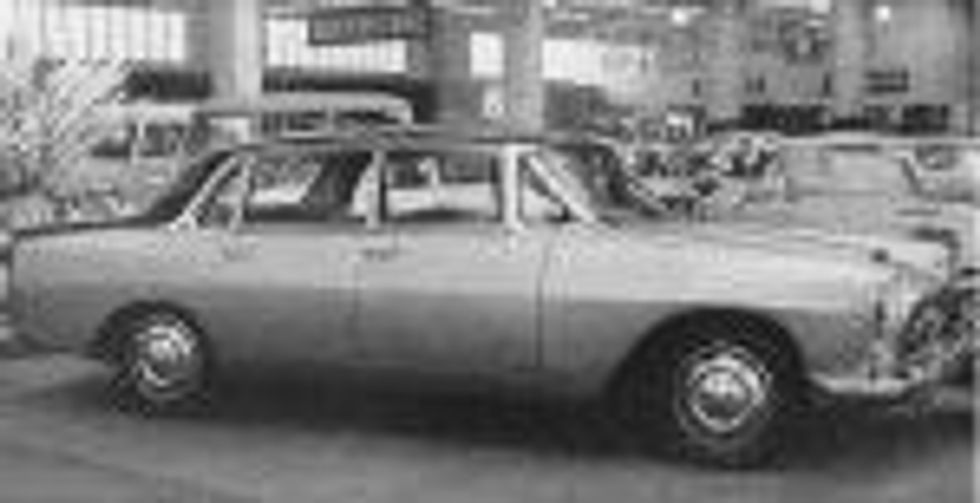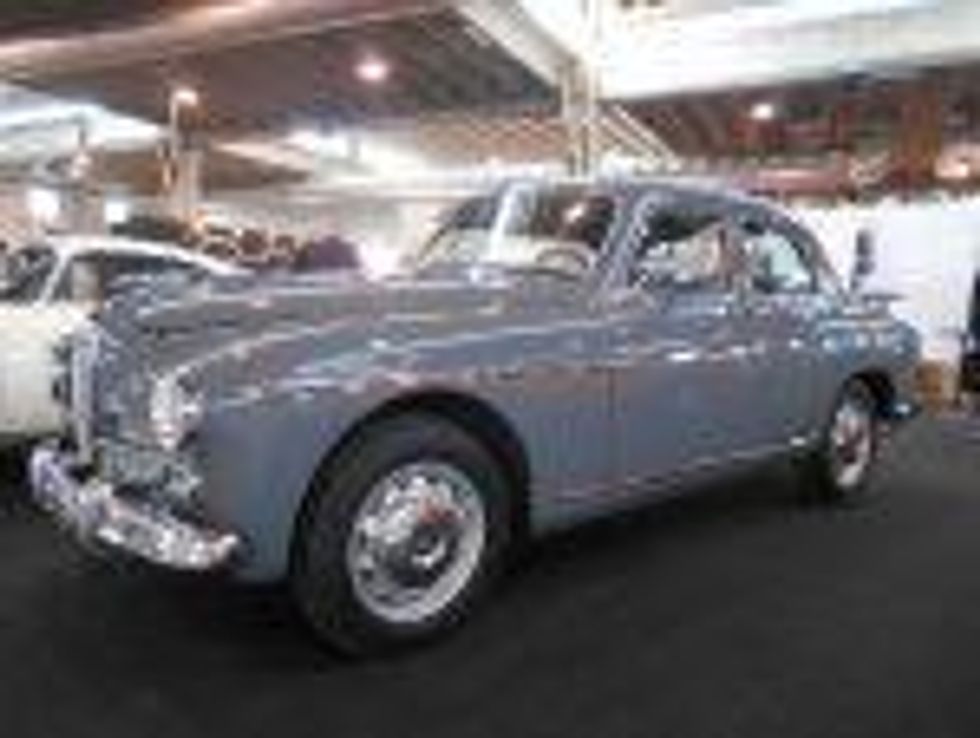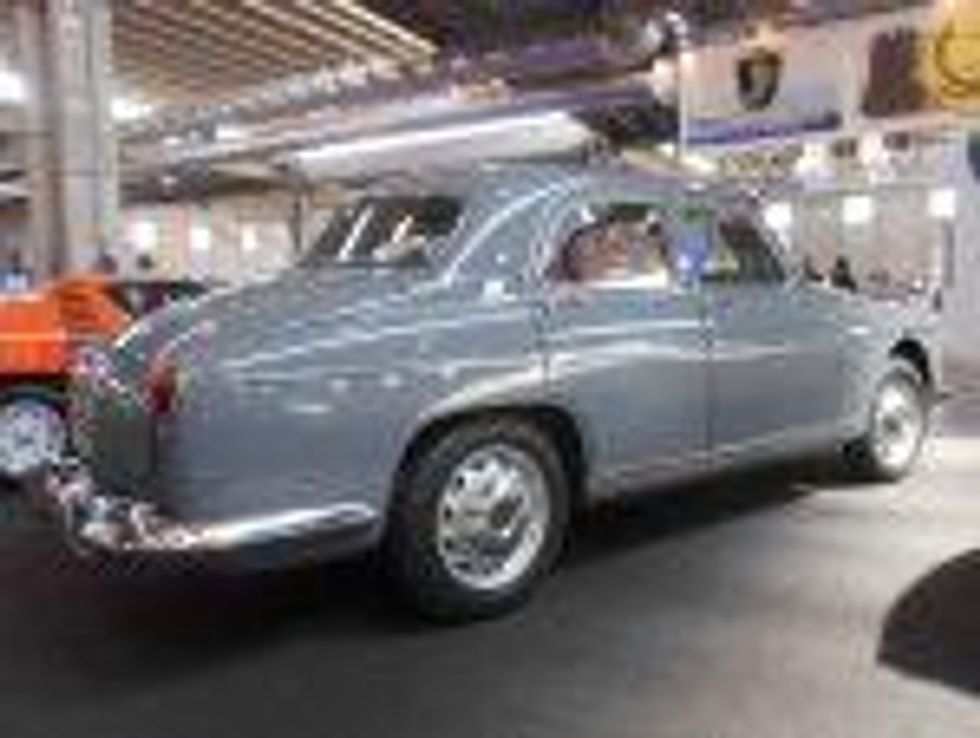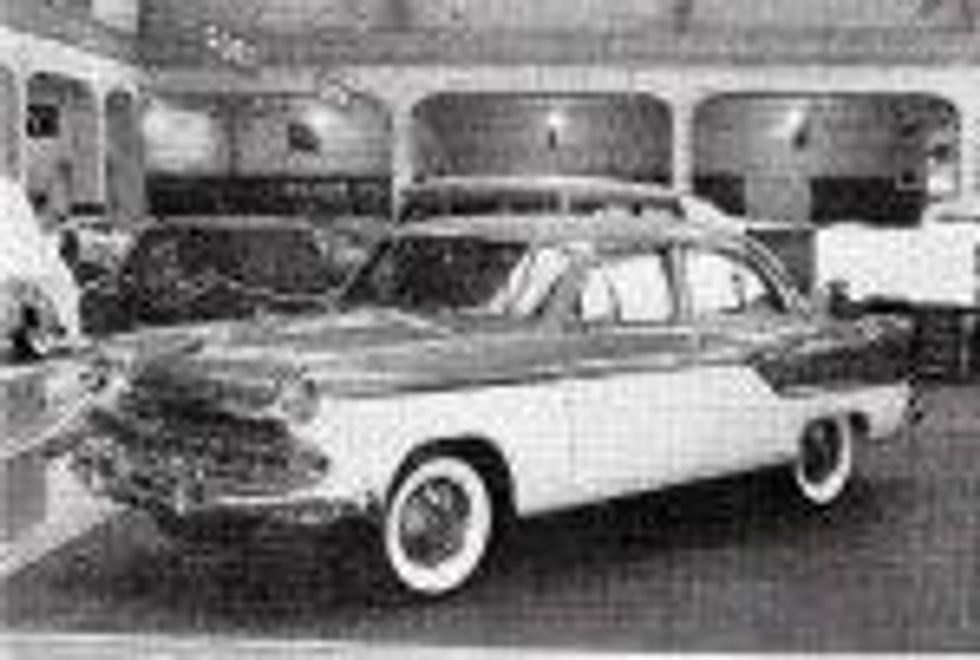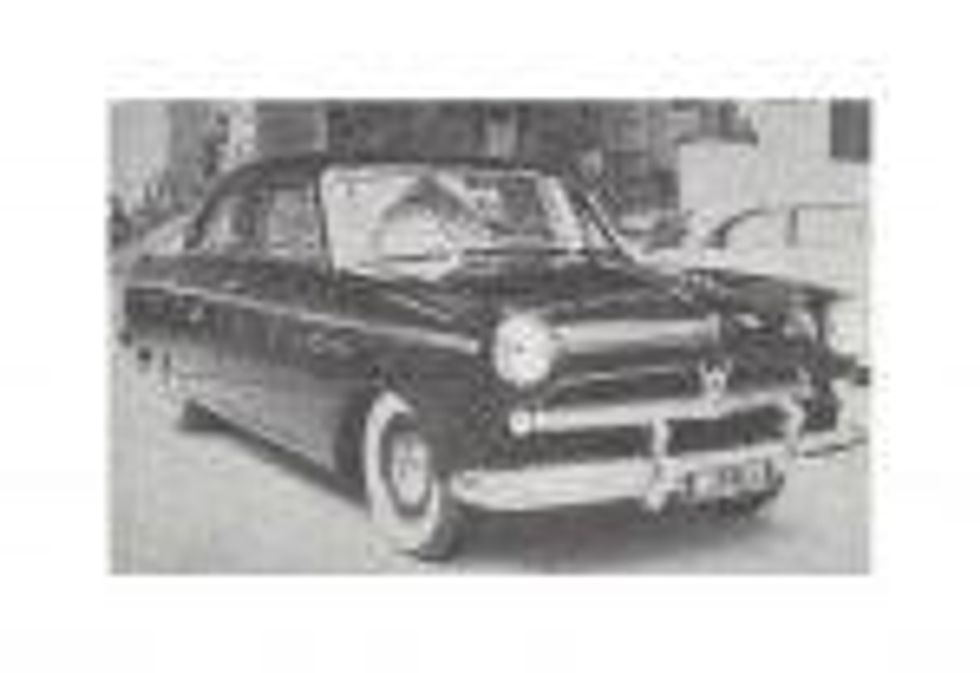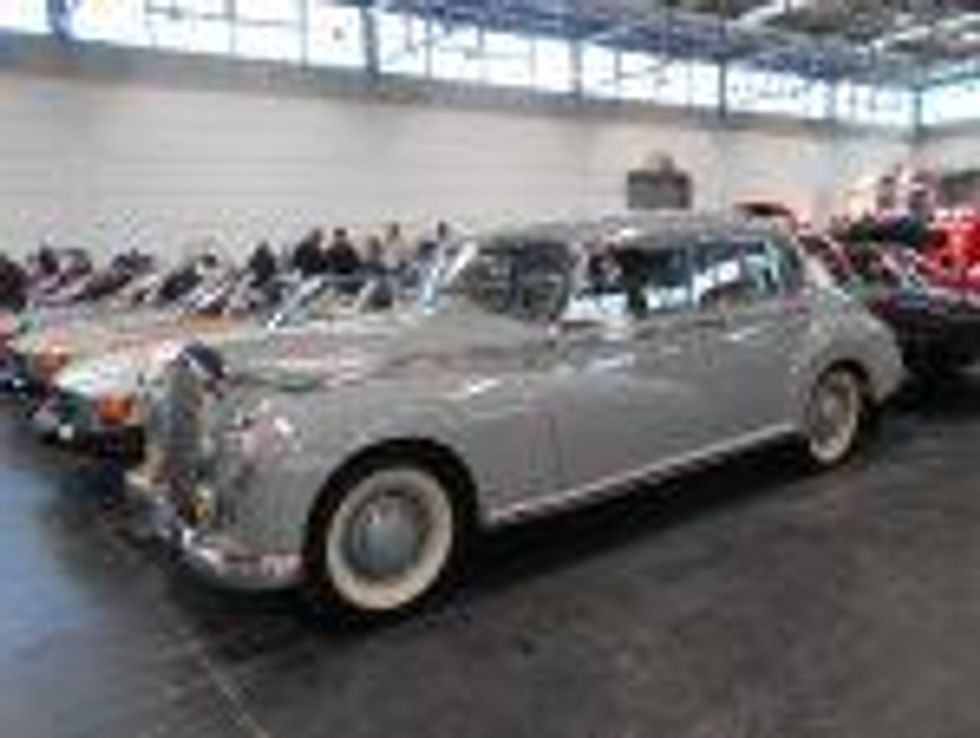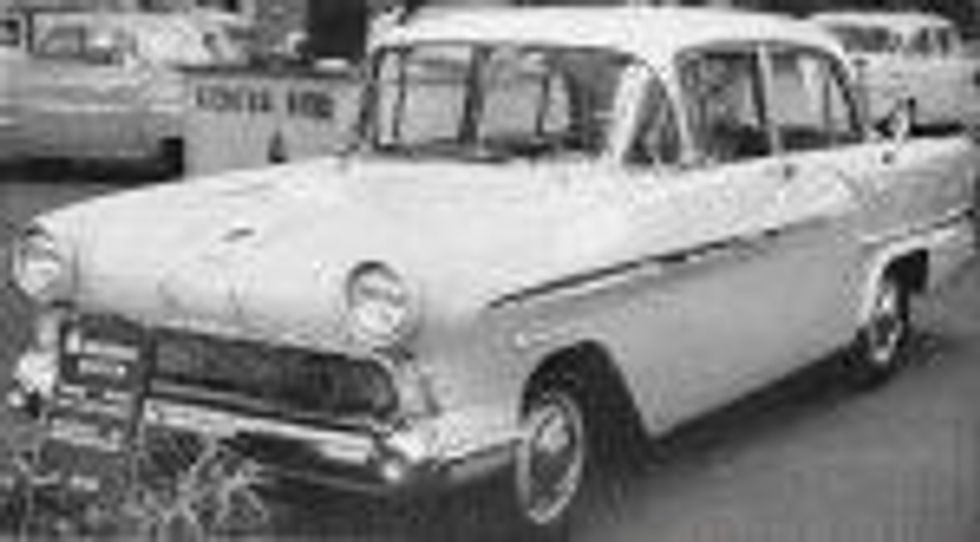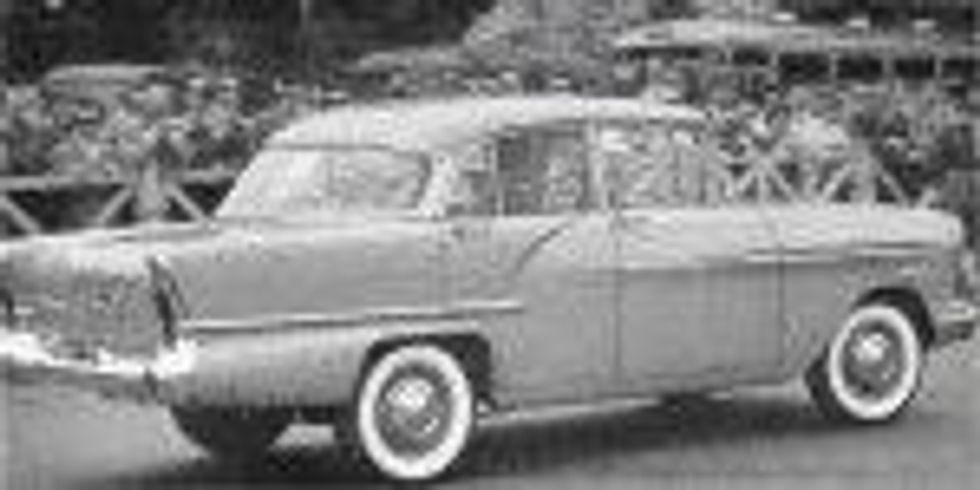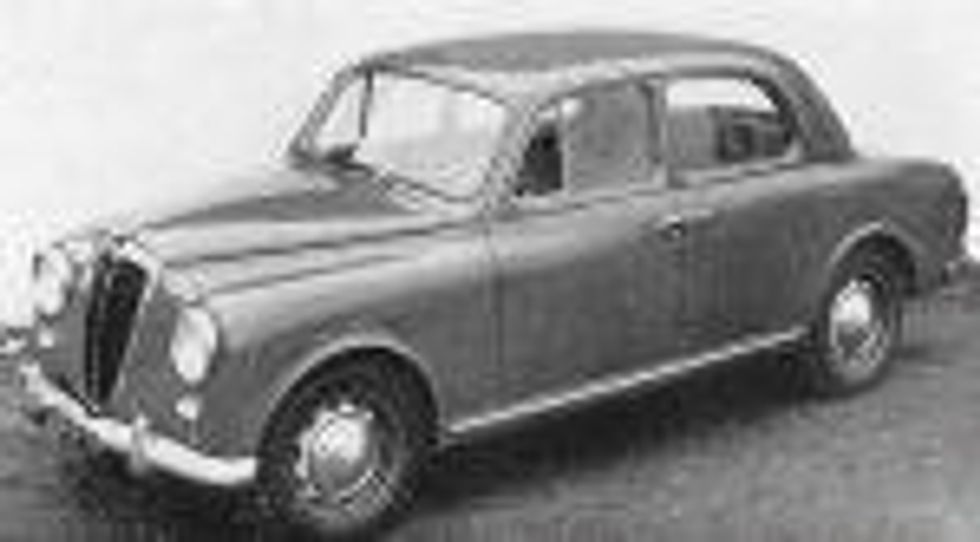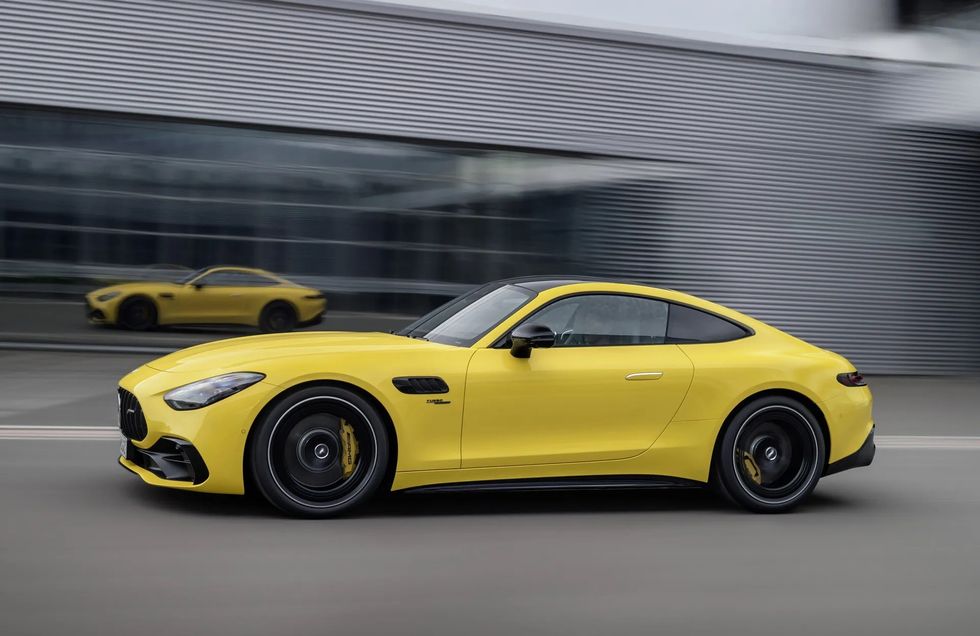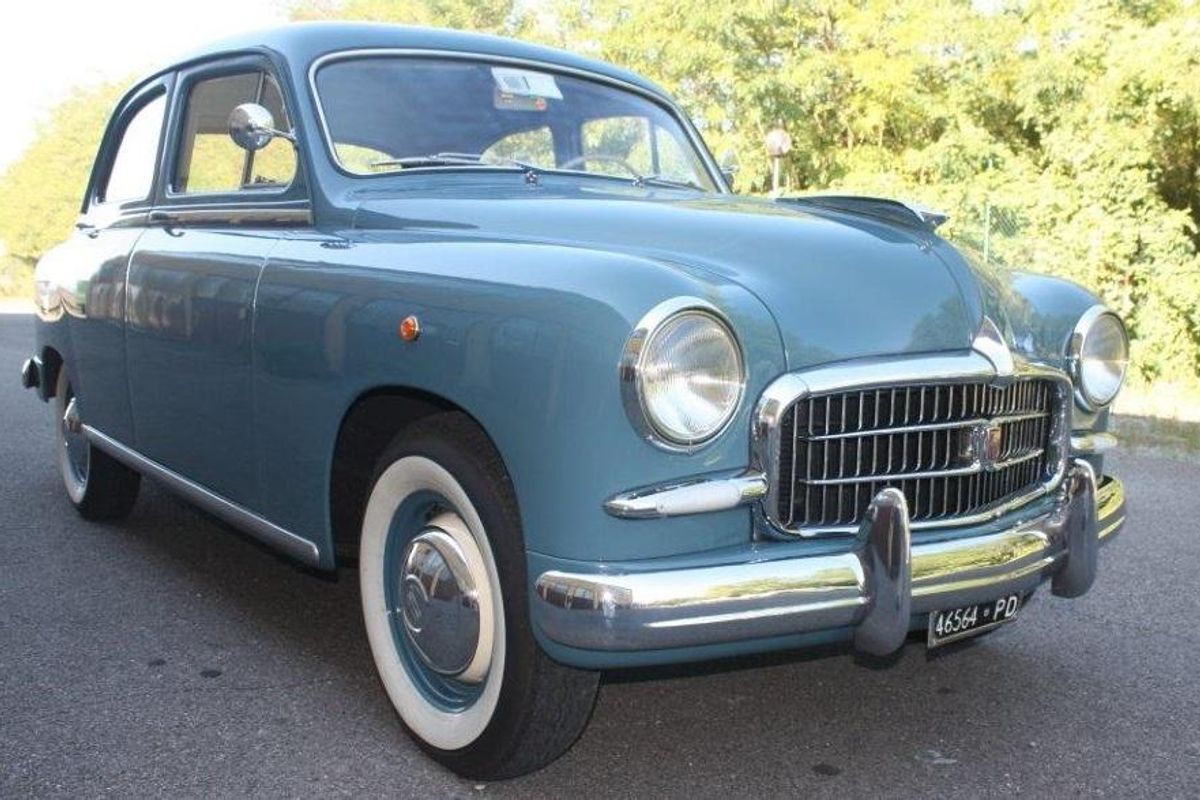
Buy
Resources
Entertainment
Magazine
Community
[Editor's Note: Building on last week's story introducing us to the Fiat 1400, this week Matteo Giacon elaborates on the 1400's changes during its time on the market.]
By 1952, the 1400 had established itself as a robust Fiat success, enjoying happy years on the Italian market and, as seen, also making some inroads on the European automotive scene: Despite relatively low export numbers, the 1400 was widely acclaimed as one of the foremost automobiles in the world, winning accolades by foreign critics. However, Fiat men were also aware that in a reawakening Italian and European economy, the small original engine of the 1400 wasn’t totally fit to fight in a more upscale market segment, a segment where most Italian and European rivals were now trying to set their place. Therefore, the project to offer a Fiat expressly devoted to that kind of market spectrum was resurrected, albeit not in the grandiose way originally devised when there were talks of American construction or V8-engined autos. While those remained dreams, a more solid reality entered in the equation: It is the 1900, named with a lack of fantasy just like the Alfa’s first all-new postwar car, but offering some originality and distinctiveness of its own. In this chapter, we will see its origin and story, and also the evolution of the whole original 1400 concept, with cars as diverse as the A and B models, and the hardtop Granluce and the fleet special Diesel variant, all accompanying the car’s life until its demise. Quite a thriving evolution!
Just like in the previous chapter, I used again original photos taken off old Motor Italia and Auto Italiana’ magazines, images here used strictly as Fair Use materials, with no commercial or promotional purposes, in order to offer a fascinating vintage look at how the 1400 and the 1900 were considered back in their glorious days. On the other hand, the contemporary photos of the various 1400s, 1900s, and Granluces come from my own archive, showing mostly cars of my dear Italian 1400's owners and friends, with the noteworthy addition offered by Mr. Hans Johansson, who let me use his magnificent 1900 A Granluce’ images, a car which has just been the subject of a perfect restoration in Sweden. Thank you again Mr. Johansson for showing all of us how deep and how far reaching is your love for these often overlooked Italian cars. Surely they deserve the kind of attention you reserved to them!

Enter The 1900--When Italian Riviera Met Buick Riviera.
The dream of a Fiat-badge modern admiral was never abandoned by Fiat top management and designers. But the dream of a really upscale proposition, something far different in image, styling and dimensions from the already existing 1400, had to be quickly forsaken. What’s more, for a while the 1400 alone was plenty enough for also typical upscale connoisseurs. For a while. In fact, in an era when affluent buyers had to be closely pursued also by those European makers apparently devoted more to popular priced market segments, because profit margins also in those days were difficult to reach with economical autos (and in proportion, European motorists were, as an average, more on the affluent side of the market ladder ), a more prestigious and more important auto than the 1400 was almost mandatory. So, enter the 1900, a simple yet effective – for a while – way to lure richer buyers in Fiat’ showrooms.

Rarely an Italian car ever looked so outlandish in some details, yet so elegant and so rich-looking in others, like the Fiat 1900, in its hardtop coupé format especially. But a very quick glimpse at the Granluce (in English Grand View, an obvious reference to its airy greenhouse) makes everybody understand why the 1900 could well be considered as one of the (if not The) most American-look Italian car ever. Later As and Bs Granluce are the epitome of this phenomenon, and one could say that early 1900 were positively austere, but just like Detroit again suggested, when in doubt about how to offer a luxury car, just add: add cubes, add horse, add niceties, add chrome, add glam. And the 1900 sure added, so much so that among all the 1400 family members, I could almost say that the "ideal" 1400 might well be the original 1900, thanks to its formula which addressed some shortcomings of the original 1400. But while this could have worked in case the 1900 was nothing more than a larger 1400, maybe also sporting the same name (say, 1400 1.9 or some other Mercedes Benz-like practice), this didn’t exactly give prestige to the car: it was always considered too much as a derivative of the 1400, and not the distinctive Aurelia-beater it should have been.

Marketing considerations aside, what in the end resulted was a good car.
As anticipated, the idea of offering a “large” engine car to the buyers wasn’t abandoned and in October 1952 , at the Paris Salon, the 1900 debuted. Soon after the 1400 entry on the market, it had become clear that in order to compete with even newer cars like the Lancia Aurelia and the Alfa Romeo 1900 a larger engined model was de riguer, but the idea of adapting to it the V8 was in the end deemed as too difficult and costly, especially because a large export effort toward the USA was already seen as economically unfeasible for Fiat (this explaining why, during its production life, the most American-looking and American-dedicated Fiat was a very rare beast on the market which apparently was the Chosen One for the model). Of course, the V8 became the engine which was used by the eponymous sensational coupè, so it wasn’t all a waste of time and money, but the aforementioned V6 was out of question, at least for the all-important bean-counters, and this despite the fact that Fiat marketing director, Luigi Gajal de la Chenaye was among those pushing toward a more fractioned and larger still engine. In effect, Dante Giacosa himself wasn’t terribly convinced about the feasibility of offering more than a four cylinder engine, considering the timing of the car’ birth. In 1950, the market for a Fiat with a larger than 1,5 liter engine wasn’t all that wide, and if the export projects towards markets inclined to accept larger engines were to be doomed, as in effect it happened, it was somewhat futile to continue with the “more than 4 cylinders” approach. There were tentative experiences about developing a larger car with the V8 as early as 1950 but the project, with a body made by none other than Pinin Farina, was superseded; in its place, the Project Code 105 was set, whereas main body structure had to be maintained. During its development, even the Project 105 lost some of its supposed distinctive aura, and the resulting car was nothing more than a mild restyling of the existing Project 101 structure: in other words, this did mean putting some chrome and a slightly larger back window on the original 1400’ body. One of the various tentative efforts done as studies for the eventual Fiat flagship by Pinin Farina apparently provided early design ideas for the Peugeot 403; albeit some sources stated that most of the proposed 1900’ ideas by PF were judged ugly, certainly what was later used for the 403 was as good as many. In any case, using the body of the existing 1400 was certainly a good solution for a marque, like Fiat, where at the time the very same engineers thought about some manufacturing solutions like full-time bean counters. And naturally, the V8 idea wasn’t lost, and neither its role as bearer of an “upmarket Fiat” tradition; however, this role was now worn by a sensational sportscar, quite a distant car from the last grand-looking Fiat admiral, the 2800. But that’s another story.
In any case, the projects aimed at developing a far different looking car that the 1400 failed mainly because of a lack of funds and time to build such a car in a proper way: in the end, Giacosa in person said that probably the production costs of the 1900 drivetrains were as high as those considered for the more sophisticated engines studied until then. Drivetrains, that is, because what had made an enlarged 1400 engine viable in the beginning also continued to be as such during production car’ life. In effect, what made the differences in costs was mounted aft the engine…And naturally, a larger 1400-derived engine was already available for usage, because a certain very special car which had debuted exactly one year before the 1900 was putting it to good use. And just like some other contemporary luxury cars from abroad (’49 Lincolns, just to name one), there was no scandal in using a truck-derived engine for an upscale auto.
In any case, what finally resulted was a far different animal than the fabulous 8V Berlinetta, the car which had the engine originally imagined for the most luxurious Fiat sedan.

The 1900 engine wasn’t nothing more than the short stroke block of the 1400 with a longer stroke, and this resulted quite helpful in production, because both engines could use the same machining and toolings of the smaller unit, with an important costs saving. Back then “stroking” was a neat and simple way to gain cubes, and from 1395 cmc the four cylinder engine became a 1901 cmc unit, with a bore and stroke of 82 and 90 millimeters, respectively. There were external differences between the 1900 and the 1400 engines, but this was limited to a mere inch or so more in height, while the added weight was only about 10 pounds. The new engine adopted a new crankshaft, quite obviously, and also new pistons, of the offset type. Compression ratio was again 6.7:1 , and the maximum output was 60 horses, obtained at the even lower regime of 3700 rpms . The engine, in effect, came to life as the powerplant for the ’51 Campagnola, aka A.R.51 (Autovettura da Ricognizione, in English Reconnaissance Automobile), where it cranked out 53 hp at the same regime. The Campagnola was the Italian way to provide Italian Army (and Italian rural prospective users) with a go-anywhere kind of vehicle, and the good torque abilities of the 1.9 liter motor were sufficient enough to make Fiat engineers sure that this engine could be mounted on a luxo-car also, just what it was designed for since day one too. With some modifications , that is.
Nothing quite exotic indeed, and this despite for a while Dante Giacosa had pondered other, more interesting projects: the V8 and the V6 wouldn’t ever be used under the 1400/1900 bodies, and for some more years they remained absent from a Fiat badged car or even from a car built by other marques belonging to the Fiat galaxy (Ferrari excluded, of course): the V8 wouldn’t be put into a Fiat sedan platform until the Lancia Thema 8.32, while the V6 would seen the light of the day under the hood of the ’67 Dino-and in both cases they weren’t proprietary Fiat projects either. Regarding the 1900’ engine, code-named 105, it must be noted that new long stroke unit was rougher than expected, because of inherent vibrations which if not dangerous for the block itself, surely were considered something of a nuisance for prospective luxury-car drivers. Using a Chrysler as comparison model, the well known Fiat veteran test driver Carlo Salamano had these vibrations to be noticed by other execs, apparently nothing really to be blamed for, but Dante Giacosa, after trying to work on the engine’ mounts, decided to mate the block to a fluid-coupling and a 5 speed ‘box, here obtaining an exotic feature for both the Italian and the foreign markets – a combo unheard of on both sides of the Atlantic, with ‘boxes usually glued to tried-and-true 3 or 4 speeds – and in doing so he gave the new car a striking feature good enough to distinguish it from both the competitors and the kid brother. The fluid coupling was of the well-known Foettinger type and it was very effective. It was also costly, not so much like certain other would-be solutions studied to deaden the engine’ vibrations, but sufficiently pricey to prompt in later years Giacosa admitting that, from a production costs’ point of view, it was likely almost as costly as a new larger engine with a simpler, more basic transmission. Its inner design features also prompted Fiat to adopt a lock for the propshaft, because engaging a low gear in order to stop the car on a gradient was nowhere possible, since the fluid coupling didn’t provide any kind of gears lock.
But from a marketing point of view the fluid coupling worked, for it could always be promoted as yet another American-born device installed in the most American-like (and therefore, most advanced by default) car then built in Italy. No wonder then, if most Italian magazines of the time remarked the similarities between the 1900 and some American cars equipped either with fully automatic or semi automatic (like the Fiat’ one) ‘boxes: it was a novelty, it was effectively advanced, it sounded good and it worked well to grant an effortless and relaxed driving experience to a 1900’ owner; just what Fiat wanted: everybody had to think that its newest creation was another all-new technological marvel, engineered for the driver who wanted effortless driving in a most commodious interior, where fit and finish maybe weren’t the very best one could pretend, but as a whole the best compromise between ride and driving pleasure, this at a time when Aurelias were aimed at the most luxurious and refined segment of the market, and the Alfa Romeo 1900, naturally, at the most aggressive and sporty one. Fiat was left with those seeking mostly comfort and effortless pleasure with dependability and no excessive concessions to frivolity nor sporty pretensions, and those buying 1900s precisely for these reasons surely found something up to their tastes. Arguably, the single piece of mechanicals which led them to the Fiat 1900 was the fluid coupling.

And it was sorely needed, because in effect, aside the engine still with four cylinders only, the 1900 appearance-wise was really nothing more than a gussied-up 1400, with some more chrome, new wheelcovers, the trafficators deletion, a different grille, newer and larger taillights, and a slightly larger back window.
I need to remember that these “economies” were done expressly to save money; it is a bit ironic that in the end, the adoption of the fluid coupling wasn’t all that economical solution so craved for, and its adoption was nearly as costly as using a proper six cylinder engine; however, those were the days before the introduction of the much more important, as far as volume was concerned, 1100/103s and 600s, and even a few savings could be really important; so, after so much speculation about what its upmarket cars should have looked like and what kind of chassis and drivetrain they should have used, Fiat came back to its roots of mainly a small displacement, popular priced automaker, and clearly Turinese executives and bean-counters preferred to invest more lire on those projects) . What was really new was a two door hardtop model named Granluce, which offered Italian motorists the novelty of a pillarless closed car directly from as an official model : the roof was rather similar to many hardtops of that era, namely the Olds Super 88/Buick Special Riviera, and also senior GM hardtops had an almost identical top’ design and many an Italian carrozziere creation, and it was available in a different color than the lower body portion, thus helping the Granluce to show how beautiful a two tone car can be without garish excesses. Needless to say, the experience gained by Fiat in building the 1400 droptop –which was offered during the first series only, and for a brief period too – was quite useful in developing the pillarless hardtop. Like the old droptop, also the new hardtop were assembled in the Fiat Carrozzerie Speciali factory, with help given by external coachbuilders – for example, some sources say that also Boano Lavorazioni Speciali, the firm founded by Mario Boano after his famous ousting from Ghia by the hand of Luigi Segre in 1954, was involved with this job. Regardless of who built those early Granluces, in any case, it was Fiat costume to subcontract special limited editions or small-series jobs to outside specialists, and the famous Reparto Carrozzerie Speciali was involved mainly in assembly rather than ground-up creation. Much of the experience gained through the work done for the convertible came in handy while building the hardtop, and the car itself enjoyed a better sales success than the ragtop. Evidently, public liked the newfound luxury of the 1900 Granluce, and the very same concept behind the hardtop success in American evidently could work fine for a similar car in Italy too.

During its early days, the Granluce was the subject of a redo, which brought along a new roof line, a toothy grille and reworked trim. A quick comparison between the early Paris Salon car’ main features and some later ones’ details makes this immediately clear. Thus, the very early roof line was modified, changing from an Aero Willys-like appearance to one more akin to certain GM hardtops of the era, with longer rear side windows, higher, slightly narrower and more rounded back window’ contours . The grille also was changed in favor of a more gleaming look, with the adoption of vertical bars which gave the car not only a more massive look, but also a clear similarity with the unit used on the sedan. Also the side chrome trim moulure was changed – but not abolished. And those two massive auxiliary fog lamps housed within the grille and the two tone combinations, some of them rather daring ones, also contributed to the basic idea of an American car mistakenly born close to the Po River. Nothing timid about a 1900 Granluce: flash and glam were the keywords here, and Fiat was able to offer something relying more on comfort and high drama rather than the deft sportiness or the suave elegance of Aurelia B20 GT and Alfa Touring offerings, this at a time when ostentation was considered an important plus for certain buyers.
Naturally, the interior of the 1900s , both the sedan the hardtop, was the best Fiat could offer, offering fine cloth upholstery and central armrests for both the fore and aft benches, again offering room for six, and this desire for more amenities aimed at driver’ and passengers was seen in the instrumentation too : there was in fact as standard item the radio, with a winding antenna mounted on the front fender – which was adjustable via a crank-operating system mounted on the driver’ side panel close to the pedals -, and an interesting device conceived to calculate average speeds, named Tachimedion or Mediometro, a complicated instrument completely based on mechanical clock mechanism ! It was almost as costly as the rest of the instrumentation, one reason why it was abandoned after the first series, but it pretty much reminds of what later Merc Turnpike Cruiser would offer. Another plus offered to the 1900’ buyers was a hood lamp, while the trunk remained large, albeit no lavishly decorated, as in the original 1400.
There were minor tweaks to the suspensions and steering wheel gear, while more precise roadholding was achieved via the adoption of wider tires (6.40-14), usually seen with wide white walls. Brakes too received minor updates.
The performances of the 1900 were more gratifying than those offered by the original 1400, what with a top speed of 81 mph and the possibility to exploit the more torquey engine thanks to the pleasant 5 speed ‘box which is a real bonus even today, and a decisive contributor to the general impression that the 1900 is a more modern car, even better suited to the hilly and twisted typical Italian national roads; its highest cruising speed is also a good advantage, although the expected gas mileage is closer to 20 mpg rather than the hallowed 27 of the kid brother.
In any case, while Fiat’ desire to offer a decent flagship which could fight with the Aurelias and the Alfa 1900s was again a bit short-sighted: surely the newborn car had features good enough to compete with other European cars: things like the Renault Fregate, were closer in spirit and qualities, and also British cars like the Rover P4s, the Humber Hawk and the Standard Vanguard, soon to be offered in a more modern, albeit oddly proportioned, version – or, more generally, most of other European cars in the two liter segment. As mentioned above, Resurgent European economy also meant that in the same years, and in those to come, further quasi-luxury cars were brought to market by mass-production makers, and cars like the Ford Zodiac or the Vauxhall Cresta, the Morris Isis or the Riley Pathfinder were all good examples of a renewed interest toward the higher priced spectrum. This without forgetting that in those Continental market where there was no domestic auto industry, so everything was imported and everything started on the same line, the 1400 had already enjoyed a good success – albeit not continuous – and the new 1900 could further contribute to Fiat’ sales success, even if there could be further rivals like the Traction Avant, or Mercedes – albeit the older look 170 S was about to be superseded by younger ’53 Ponton types - and BMWs.
But the Alfa 1900 and the Lancia Aurelia were, by default, the Fiat 1900’ closest competitors, and from an image and prestige point of view they were a step or two above the 1900: The latter still had its fair amount of qualities, and some really avant-garde details, but the uncertainty about its very own existence and how it was finally offered to the public, while not a real defect per se, was nothing whoever had money to spare for such a car wanted even in the rarified Italian market of the day; while the 1400 had been initially offered for 1,270,000 Lire (and when the 1900 debuted it cost 1,400,000 Lire), the newcomer started at 1,750,000 Lire, a great deal less than both the Alfa and the Aurelia, ok, but maybe a tad too much more than the 1400 for what really distinguished it apart from the smaller brother – of, for what the public, after initial enthusiasm, began to perceive about the Fiat’ flagship. In any case, the 1900, at least initially, enjoyed a fair success, also in the hardtop format: the Granluce had started with a list price of 2,150,000 Lire, quite a sum (even when compared with the initial Convertible list price, 1,675,000 Lire in 1950), and while this meant that it cost as much as a 1900 or an Aurelia, it nonetheless wasn’t too much hampered by this price, for , like the four door counterpart, it enjoyed in first two years of life more or less the same number of examples sold in the last 4 years on the market. In effect, judging from these results, it is evident that the initial 1400-1900 stamina on the market was already long in the tooth by the time the 1954 models were being offered.

Stamina, however, was a strong 1900’ quality, at least if the real item had to be considered: the car was surely rugged, its quiet big four had been studied to properly propel a Jeep-like Jeep-variant for Italian conditions of the time, and the fluid coupling wasn’t an unproven technology. And naturally, the innate ride qualities made it an effortless mileage-maker, even because the 5th gear effectively reduced engine – and passengers – stress. This sounds as the most desirable features to be found on a given auto selected for an across Africa raid, especially if said raid had to run across 1952’ Africa. Three Italians thought this too, and they selected a 1900 as their mount for the 1952 Rally Algier- Le Cap (Cape Town), one of the most rugged competitions ever. Rabezzana, Mazzuchelli and Martignoni, the three intrepid Italians, had to cope with the usual issues of transAfrican raids, like impossible climate, impossible weather, impossible (and impassable) roads, paths, quagmires, jungles, savannahs and rivers. Only the radiator fan belt was changed during the raid, and this says a lot about the superb and rock-like qualities of the 1900 – and the car lacked the bumpers too ! However, despite such an exploit, the Fiat 1900 didn’t enjoy the kind of mild sport career endured by its smaller brother: considering what else was available back then in the Categoria Turismo spectrum, (cars like Aurelias and Alfa 1900 …just to name the two most challenging competitors, ideally battling with the Fiat’ car on everyday roads as well as on race courses), it was clear that the 1900’ relatively meager cavalry wasn’t the best for pursuing downright successes in races the likes of Mille Miglia, Giro Di Sicilia, Stella Alpina, just to name a few of those where the same 1400 obtained, in stock or specially built form, some sort of successes. The 1900 had not been created with downright speed and sporty qualities as primary targets.
On the other hand, this did a lot to shout about the 1900’ best engineered features and qualities , and likely the ideal displacement and output for the large 1400’ body was just the long stroke 1,9 liter motor. These qualities also came in handy for a second wave of coachbuilt creations made again on the basic 1400’ floorpan: this time, the larger engine and its inner good qualities made it almost a natural choice for special cars expressly made to showcase some new and distinct esthetical solutions which were different than the standard Fiat’ own ideas. No wonder then, if many of the coachbuilt autos made during the ’53 and ’54 seasons were powered by the 1,9 liter powerplant: it was ideal both for mere numerical questions and also because now also proper specialty cars could easily be offered as an alternative to similar Alfa and Lancia-based one-offs. Finally, Fiat too had classy and unique-looking cars with clothes built by haute couture tailors, just like its main rivals. But the rich world of 1900-based specials need to be explored in a deeper look soon.
Despite the problems in achieving massive and undisputed sport successes, the 1400 and the 1900 were arguably among the best autos of the whole European market in those early Fifties days, and their owners, as a whole, were more than happy with what the cars had to offer.
What was a bit lacking in this equation was maybe a better fuel mileage: while the one associated with the 1400 was always considered good, but not extraordinary, the one offered by the 1900 wasn’t clearly any better, albeit in proportion still it wasn’t all that bad. For a car devoted to travelers above all, this sounded a bit strange, also because the 1400’ engine was a modern unit, and its output was any but all-out sporty: it was therefore normal that some buyers, desiring more fuel sipping of sort, might also hope for improvements in this area . A problem was now looming – the 1400 needed some solution to cut its running costs. Add to this the fact that as the time went by, more modern cars went for sale, which in our context means mainly one car, the new-all new ’53 Fiat 1100/103, which gave performance qualities akin to those of the 1400 for less money, both when purchasing it and while running it. And it was a roomy, yet compact auto, and a modern yet rugged proposition, available to a larger spectrum of would-be buyers – also including some of those otherwise destined to drive a 1400.
In sum, the 1400’ market was, for the first time, threatened, and this time by an in-house competitor close in almost all basic aspects to the Fiat frontrunner. Therefore, it was about time, at least in the short period, for a more economical variant of the 1400 – and luckily Fiat engineers and marketing experts had similar thoughts -, and, in a slightly more distant future, for a restyling of the whole 1400 family of cars, just to keep it on the market in a continued, successful way.
Thus, for now, in 1953, the 1400’ real novelty would’ve be seen in the way of a revolution into the engine bay, a very novel motor indeed, a powerplant never seen before on an Italian car, an item still rare on Continental cars (also Borgward thought there could be a market for similar cars, ‘cause a similarly conceived version of its successful Hansa debuted just about in the same time): it was the oil-burner variant of the 1400, the Diesel, done precisely for those thinking that the fuel consumption of the gasoline 1400 could further be improved.
The First Italian Oil Burner
Those craving for even more fuel sipping were unexpectedly gratified in 1953, because the last great achievement of the original 1400 was the adoption in 1953 of the Diesel engine. This was more or less nothing more than the 1900 block converted to oil-burning and already in use for a year on the already mentioned 615 light truck . With a puny 40 hp , it was able to propel the car to around 60-62 mph, but it soon became a long-term travelers favorite, although not in sufficient a manner to give Diesel engines new life on successive 1800/2100 models . In any case, after certain experimental tentative done by both external firms and the same Fiat, it became apparent that a diesel-engined 1400 was not a peregrine idea. And albeit Fiat eventually gave up to the idea of starting a dynasty of diesel-powered cars, a thing which would’ve brought Turin at the forefront alongside Stuttgart, motorists quietly went to appreciate 1400 as oil burners, for, since the Diesel’ ’53 debut, there was almost a 50-50 division of sales with regular gas models.
The need for economical yet classy and roomy transportation was surely a still sought after thing in early Fifties Italy: gasoline prices, as per long Italian “tradition”, weren’t exactly low, and the 1400s were more and more finding a following among those privateers who drove cars for professional work, a la Uber. It is what in Italy is dubbed as NCC, Noleggio Con Conducente (Rent With Driver); back then, with cars still a relative rarity for many and with many smaller towns and boroughs not easy to reach due to insufficient roads and barely adequate bus services ,on the other hand, were becoming more and more beautiful and luxurious, exactly because they had to answer to a strong need for better people mobility, at a time when railroads were becoming insufficient and private motorized vehicles were still a dream for most Italians, all that was needed to sort out this situation was a roomy and commodious car, ready to god lots of miles also on gravel roads with no troubles: a diesel-engined car could be an even better alternative than the already economical gasoline original. Yes, it is true that Italian buses were becoming more and more beautiful and luxurious, exactly because they had to answer to a strong need for better people mobility, at a time when railroads were becoming insufficient and private motorized vehicles were still a dream for most Italians, but for some jobs what was really needed was a car which bore the ideal of a big inside, small outside vehicle, a car fit for mountain roads as well as downtown alleys as well as remote country paths: and what was working in the same era for Mopars, just to name a car conceptually close to this ideal, could well work for Fiat too, with the fascinating- but still relatively unheard of – advantage of greatly improved fuel consumption, this in an era when Italian gasoline was already one of the most pricey around.
Early-to-mid Fifties were evidently good times to see some diesel engine tentative, and Standard, with a dedicated version of its Second Series Vanguard, and, as said, Borgward, with its Hansa 1800 were also eager to jump on the oil burners bandwagon. But only Mercedes at that time, with almost two decades of experience, was enjoying good and deserved success for a diesel variant of a given gas-powered car, also spurred by its well-deserved reputation in certain taxicabs European market. Others remained a parenthesis, and only Peugeot, with its 403 Diesel, likely designed also after the Suez Crisis woes were still a tangible event, was able to start a long lasting diesel success story as an alternative to the one already experienced by the Stuttgart’ firm. But by the time Peugeot had its oil burner ready, Fiat had already decided to push the glamour and flashy side of its really modern 1400-1900’ heirs, the 1800/2100s, and the mundane and humble image of the 1400 Diesels had already began to seem a bit outmoded and out of place in the economic boom’ Italy. A pity, considering the acceptance given by the faithful 1400 Diesel buyers’, who were evidently content with their car. And, all in all, Fiat hadn’t taken a formidable effort in building the diesel 1400: its engineers had simply used as a basis a gas motor, as per safe practice, and they had brought the modifications strictly needed to make it acceptable for road use. Nothing fussy nor exotic here.

The gas original engine itself was in fact modified and at least one prototype was built to start developing work about this 1400’ alternative, but the original displacement was evidently considered not adequate in order to provide acceptable levels of motivational power. Not that those few diesel-engined cars then on the market were something to write home about, when taking alook at their performances, but evidently 35 meager horses were considered a tad too few, when they had to move along six full size men, their luggage and more or less 2300 pounds of car when dry.

Once again, solution was already at hand, in the form of the 1,9 liter engine (derived from the enlarged 1400 block) which saw use in the small cabover truck which did see the light of the day in August 1951, the immortal 615. This truck, the one which really put Italian industry on the roll again, was initially available with the 1400’ gas engine, slightly detuned, but soon, during 1952, it became available with the diesel engine also, better fit for the kind of suffering jobs a truck had to cope with in Italy back then. It was in fact a one ton and half capacity truck, but this did mean back then that it had to cope with usually a good two times that payload. Evidently, the small 1400-derived original gas motor was not exactly the very best powerplant ready to do this, and the larger diesel unit was as good as anything from Fiat in order to ease things both on roads as well as on gas stations.
What was good for a light truck was evidently perfect for a car devoted to be used at full load too, so the 1,9 diesel motor debuted in spring 1953. Code-named 305, the engine used the 105-type 1900 engine’ block, while the head was naturally changed: the one adopted used Ricardo-Comet indirect injection high turbulence system, with a 20:1 compression ratio. The engine cranked out those 40 horses ( 3 less than the slightly smaller and similarly gas engine-derived Borgward unit) at the quiet regime of 3200 rpms. Naturally, the engine was just like diesels of the day, slow to start and noisy, but not worse than what used by others. But fuel mileage was almost phenomenal, with Fiat claiming 35 to 40 mpg as average, and as much as 47 in certain conditions. Doubtless, this was likely the best single argument to justify such a peculiar deviation from the engineering and marketing practice of the time.
The car was also distinctive because of its powerful 24V electrics-a clear truck-derived device, which might surely sound impressive to those used to 6V (important to remember that practically all Italian cars since the late Thirties had 12V electrics, it is always curious that countries with brutal winters still had plenty of cars with weaker 6V units, while a country like Italy was already ready for the 12V wave). But the engine, initially conceived as a motor for the light 615 truck, was also soon to be adopted, and for a long amount of years, in the Jeep-like Campagnola: clearly, electrics and ignition system rugged enough to cope with the worst conditions army and commercial users could find in Italy back then were very welcome items, even if this did mean that they seemed somewhat exaggerated for a car like the 1400. But that was the norm in cases like this one.
Despite the initial curiosity and a well-deserved enduring success, also granted by a price which was not excessively distant from the gas-fed counterpart (1,550,000 Lire when it debuted, 22nd March 1953) the 1400 Diesel did remain a solo experience after the final B models production ceased, and not until late Seventies (and after a gas crunch), the need for diesel Fiats became once again a veritable problem. Strange to say, especially because the short-lived first series saw a wealthy 13,585 examples built, with more or less 25,000 for the A model and 19,000 circa for the B – interesting to notice that these numbers almost exactly matched the respective gas-engine units produced for the A and B series. So, a flop it ain’t. But fast-changing times and tastes, the same that more or less doomed the life of the 1400 as a whole, also meant that the diesel experiment could quietly be put out to pasture. In fact, with the Italian economy quickly growing, and with the Italian public more and more concerned toward flash’ n speed, fashion’ n luxury, a slug-slow diesel buggy was somewhat out of the market desires, or at least it was felt so, and so what was an interesting experiments ceased its existence after a few years only. Also the same 1400 diesel image had became maybe a tad too much mundane at that time, to grant existence for another large diesel car. As we will see, the same 1400 and 1900’ image was fast becoming out of fashion as the decade ended. And a car like the 1400 Diesel was too much mundane for those fast-changing days.
A pity, because in the Sixties technologies had modified for the better the diesel-powered cars, and what was a slow, cumbersome affair good mainly for those seeking for an alternative to a microbus was now beginning to live a second life in the hands of those craving not just for economical transportation along many miles of road, but also with a good deal of refined, typical automobiles’ manners: in sum, the diesel Mercedeses and Peugeots started to show the sales reps people what oil-burners could do for their pockets, and by the time gas crunch started to take its toll in Europe, those two marques, together with Opel, were set to rob great slices of the high-mileage autostrada voyagers’ pie. If only Fiat wouldn’t pull the plug after the 1400’ life ended, or, simply put, would continue to improve the 1,9 liter motor itself…
After all, the diesel, born with 40 horses, gained a bit of cavalry with the debut of the B version, and in doing so it also achieved some more in terms of pure speed: now, the car was good for full 100 kph, even some more, and so also the added weight penalty – something like 200 pounds - caused by the very same engine could be coped with in relative easiness. It was not a revolutionary move, sure, but together with this horsepower improvement some minor refinements were also put in the equation. And a certain segment of public seemed to appreciate the Fiat efforts in order to provide market with a no-frills, no-nonsense roomy miles-gobbler.
But sadly, by 1958 it seemed that Fiat itself was willing only to forget a great deal of past 1400-related experiences, so also the diesel was no more. And when the same Turin marketing honchos found a niche to be explored for a fleet-type model to be added to the 1400/1900 heirs, the 1800/2100/2300 family, they judged it was a better deal using the existing 1500 four cylinder rather than some sort of improved diesel engines. In the mid Sixties this might look like a viable formula, but ten years later a diesel would’ve been very desirable. In the end, the 1400 Diesel would’ve been another one of those What Ifs which often have featured in the Fiat’ very same life.

The Evolution Is As Soft And Gentle As A Feather – Feathers Coming From New Tails
Thus, despite all the peculiar features of the original project and the birth of two well conceived variants, and after a good success with 74,931 1400 units sold and somewhat less than 10,000 1900s (8060 sedans and more or less 1900 Granluces), by 1954 it was clear that public expected something more from Fiat, even more so once the ’53 1100/103 had debuted, robbing a certain amount of would-be buyers thanks to its basic qualities which made it a viable and more economical alternative to the original 1400. And naturally, with Italian economy fast improving, a car in production by 4 full years with few modifications was obviously beginning to make everybody desiring something new, especially from a mere aesthetics point. After all, very few changes had been done to the 1400 during its long initial life span: the deleting of the trafficators, with the introduction of proper front parking lights, for example, was one of them, evidently too little to justify another long period without changes of sort; the adoption of some assembly-plant modifications during the first months of life were practically invisible to public. It is true that significant evolution for the 1400 family had showed when the 1900 and the Diesel had made their debut, but the original basic sedan had stood pretty much still: a redo was mandatory to make the 1400 commercially livable so, it was time for the new 1400 A - and the 1900 A - to enter the market.
In April 1954 , Fiat showed the new two models, and in doing so they practically unified them : from then on, stylistic, chassis and drivetrain novelties would’ve been offered for both types at the same time – in doing so Fiat did achieve a great simplification in the production scheduled procedure, albeit the already weak personality of the 1900 sedan was even more diluted. But Fiat’ engineers and marketing men thought this was necessary, for the enormous funds invested in the new volume models – 1100/103, 600 and the future 500 - would grant great gains, something the relatively small-numbers 1400 and 1900 would’ve never been ready to do.
The new 1400 A had its major design difference in a larger back window, what was already used for two years by the 1900, and, most important, new rear quarters, practically a small set of fins, with much larger pointed taillights which gave the car a distinct look from behind, plus the obvious change to the front grille : now, the car looked more like a baby ’53 Chevrolet 150 - chrome was still applied with modesty, but sure it was there ! The engine gained 6 horses, developing 50 net hp@4600 rpm via a c.r. of 7:1, and some more torque : the top speed reached 78 mph and the general impression was of a somewhat livelier car, with gas mileage still close to 25/28 mpg.
The 1900 A design changes in the sedan version followed the smaller engine model mould, with some more chrome, a further enlarged semi wraparound back window which would’ve been used up until the end of production, and a grille similar to the 1400 A but with two integrated fog lights – just like the setup used on previous Granluce. The 1900 A also had the same rear quarter treatment of the smaller engine stablemate and standard wide white walls, nothing really new, for both first series 1900s and the 1400 convertible had them before it, but this added desirable flash at a time when Italy was more and more happy to live the good life just as per American costume. And naturally, just like in the first series 1900, it was the 2 door hardtop that looked every inch like the family’ glamour member, and in doing so it was even more different than its ancestor : Fiat followed typical early-to-mid Fifties fashion and changed its roof style in a striking way. Now, thanks to the addition of inverted C-pillar and a wraparound rear window –albeit still divided in 3 sections – the Granluce gained even more in appeal, becoming truly a spectacular and charming car, looking every inch like the elegant and upper class offering by Fiat had always hoped it could be since day one, what with a baby Nash Ambassador or ’53 Chevy Bel Air hardtop treatment, incidentally similar to many Vignale, Pinifarina, one-offs or limited edition cars made on much costlier drivetrains – albeit the somewhat stubby proportions and the side windows treatment, together with the slab sides, where flared fenders were absent, made it also close in design to the Dodge and Plymouth hardtops of the same time – apart from the wraparound back window.
And naturally, we must not forget those famous Studebakers which had already captured the hearts and the souls of many car designers. But as we already know, the same roof lines captured by Bob Bourke and Holden “Bob” Koto to be used on their immortal ’53 masterpieces were also some sort of trademark for Pinin Farina and some other Italian maestri. Fiat then was two times right in adopting such a scheme: it was definitely American-like, yet it could again linked to quintessential Italian flavor. It was only a matter of tastes, whether an onlooker preferred to think more about the American influence or more about the coachbuilt specials’ designs.

In profile, this distinct American flavor was even more evident, albeit the smaller dimensions and the, dare I say ?, sedate stem and stern clearly made the Granluce a somewhat different animal than a mainstream Detroit hardtop. If the Granluce looked like a slightly smaller Bel Air or Coronet and the 1400 maintained an austere demeanor not unlike the ’53 150, the 1900 A sedan could be compared to a ’51 or ’52 Buick Special, with the use of two tone combinations on the Italian cars still an exclusive of the hardtop model, this time in a decidedly captivating mode. In any case, the restoration of a car like a 1900 Granluce is a noteworthy feat, what with it using huge amount of chrome, its nicely detailed and downright luxurious –for a typical Italian car of the time - interior and some impossible-to-find accessory (like the ashtrays, the courtesy lamps, the exclusive radio and so on), offered back then to make everybody conscious of the luxurious inner nature of this car, despite the Fiat badge found on it. This wasn’t your average 600 or 1100, no doubt about this. Ask people like fellow Hemmings reader Hans Johansson, who recently restored a magnificent 1900 A Granluce example, about how formidable a task can be the complete restoration of these autos. And if such a restoration can be quite a feat in Italy, think how it can be in Sweden, Hans’s country, where parts for a Granluce aren’t exactly found everywhere…Hans, compliments for your car ! I hope you will enjoy lots of miles from its gutsy engine.
Yeah, the 1900 A engine: it wasn’t enormously different from its direct predecessor, but it enjoyed a fair amount of refinements. Just like its smaller 1400 brethren, also the engine of the 1900 A gained a bit of horses too, reaching 70@4500 rpm, via a c.r. of 7,5 :1 , with a top speed now in the nearby of 83 mph, still an adequate performance when compared to foreign competitors, although, once again, no match for an Aurelia B20 GT or an Alfa 1900 SS. However, just like the first 1900 Granluce edition, the typical owner of this kind of Fiat was thought to be in a different league than those driving Lancias or Alfas, so the Granluce had a fair number of admirers –admirers who otherwise would opt for a foreign glamour-looking car or some sort of even more costly fuoriserie made by some carrozziere. Interiors on both the 1400 and the 1900s had been subjected to refinements, mostly regarding better materials and a small facelifting of some parts – like the instrument panels, now elliptical on the Granluce, and with a slight difference in gauges’ design on others – but the Fiat’ flagship could now count on a very useful novelty, the standard windshield washer, fed by a big glass bottle anchored aside the engine on the passenger side of the firewall. A very appreciated item indeed.
Fiat sold more or less 50,000 1400 As (with 25,036 gasoline models and, as seen, an almost equal number of diesels) and only about 7,000 1900 As (5,923 sedans and 1,104 Granluces), still a decent number considering the differently sized respective market segments. And, a rare thing in automotive world, prices remained pretty much like the previous old variants’ latest ones: the 1400 A, when it debuted, cost 1,345,000 Lire; the Diesel 1,545,000 Lire, the 1900A 1,724,000 and the Granluce 2,124,000 Lire. In sum, it could sound a bit ironic that the in-between 1400 was also the one with the best sales numbers, all things considered: but the idea that it was a mild restyling, in an era when more was the keyword, surely haunted some Fiat execs’ minds, and the fact that in the meanwhile also a plethora of European competitors had seen the light of the day meant that Fiat couldn’t rest on laurels for long: and given the common origins of the smaller 1400 and the larger 1900, there were plenty of rivals to choose from, using the external dimensions, the interior roominess or sheer displacement as discriminating parameters. We can number as 1400-1900 competitors, for example: the renewed Austin Cambridge and the Ford – soon to become Simca – Vedette; the renewed Renault Fregate and the new for ’55 Peugeot 403 – and what a modern car it was; the Mercedes Ponton, which would also soon offered in really upscale and modern versions and the still successful BMW 501 and 501B – maybe hampered by old-school looks, but every inch formidable road cars, and soon to be offered with the formidable 2,6 liter V8, an engine which propelled the Bavarian car in a world of its own; the still recent and modern Opel Olympia Rekord and Ford Taunus 12M-15M; the Borgward Isabella. All of this autos were part of the same European wide mid price cars’ market spectrum, ranging from cars close to real economy autos all the way up to genuine luxury vehicles; and all were excellent competitors for the 1400 and the 1900: maybe, in the protectionist Italian market of the day this was not a problem, but arguably those shopping for new cars were well aware of what was hot and what was not also abroad. And naturally, in markets where there were no tariffs against foreign products, markets where all cars had to be imported and started from an equal basis, the 1400 and 1900 As found notable competitors amongst many of those newest and younger cars. So, also cars like the Jaguar 2,4 Liter, aka MKI, or the very same Citroen DS, or the pretty and peppy Sunbeam Rapier can arguably be considered for a reason or another as downright rivals to the 1400, the 1900 and the Granluce. The latter one, the Rootes’ car, was also interesting because it mated a roof pretty much like the one seen on the 1900 A Granluce (no surprises here, for this British car had a certain Loewy Studio flavor, and for good reasons) with a paint scheme later used by Fiat itself. More on this later on.
No wonder if in an Europe blessed with a booming economy there were so new and nice autos. No wonder if the European automotive scene was thriving. No wonder if older cars had to keep up with the latest models. No wonder if the mid price Fiat family’ members were starting to appear somewhat surpassed.
Sadly, in Italy there would’ve been yet another problem for the 1400 and 1900 As: cars like the Alfa Romeo Giulietta and Fiat’ own 1100/103 TV would’ve soon been on the possible drivable dreams’ list of a sizable number of Italian shoppers. For speed-craving Italians of the day, it was arguably difficult to resist the call of the 95-mph plus Giulietta T.I, and also the 103 TV was more than a slightly more potent model of the Nuova Millecento.
It was then time to give 1400 and its larger-engine brother another vigorous dose of dash and glam, because this was the era when those things sold. And if in the high speed madness of the Italian cars of the day there was no space for the mid sizes from Turin, then there was still plenty room enough in the realm of the flashiest cars around. And that’s precisely what the following and final versions of these 6-years old autos would look like.
Going Out In Style: The All-Flash, All-Dash 1400 And 1900 Bs
Well, during the 1954-’55 years ,with Fiat’s efforts still concentrated at the maximum degree on the 1100/103 and the 600’s launch, and with the Alfa Romeo Giulietta sedan 1955’ debut, the 1400 A and its richer sibling 1900 A didn’t endure the success that was initially granted to the 1400 3 or 4 years before. Or, to be more precise, while the 1400 A did have a good success, a very decent one indeed, the same cannot be said about the 1900 A. Too modest, once again, the difference between the two cars, and those desiring for luxury aboard an Italian family sedan found the Alfa Romeo 1900 and the Aurelia somewhat closer to their tastes.
In any case, Fiat had likely hoped for more sales of the same 1400 A too, because Italian market was fast recovering, so much so in fact that it was enduring a fast pace toward record numbers. Thus, while respectable, the 1400 A units sold during those years could surely have been more, if only the car would’ve been offered in a more palatable guise. At least, this seems like it was the real problem about the supposedly tepid market acceptance of the 1400: numbers good enough to be deemed respectable at the beginning of the decade were seen as acceptable and nothing more as the years went by. So, it was clear that the 1400 and the 1900 had to be made palatable again for a wide percentage of typical Italian middle class motorists, those otherwise lured by competition (also in-house one), with more brilliant cars.

Problem was, what was “palatable” to Italian public ? Or, to be more precise, what did the Fiat execs think could be “palatable” for the public ? Was it only a matter of aesthetics, or a matter of performances, or a matter of ride and accessories, or a matter of all these three features, features which had to be bettered in a bold way to keep the 1400 and the 1900 alive and well ? In addition to these questions, It must also be noticed that in the most typical American Fifties fashion, would-be buyers were now expecting more and more novelties year after year, so the mild 1400 A restyling needed even more “new” allure after 2 years only. Therefore, it was rather obvious that it was once again time to take a close look at the American style trends, also implementing typical Transatlantic practices: in Italy as well as in USA, if you couldn’t afford a total redesign or an entirely new model, in 1955-’56 there was only one way to give an old car new strength, thus giving more chrome, more colors, more glass, more power, more standard features and where possible, more fins. Fiat duly obliged and on 21st April 1956 – during the Turin’ Salone Dell’Automobile, just like the previous A, for that matter, and apparently in the same day two years apart - the new 1400 B and 1900 B made their appearance on the market.

There was now no doubts that Fiat wished to exploit passing fads of the day with no heavy changes on the basic lines, in order to avoid again an expensive restyling which would’ve been uneconomical, given the fact that the 1400 and 1900 legitimate heirs were already under development. What was timid on the previous 1400 and 1900 was now bold, almost provocative. But the evident appearance changes, albeit superficial, were done in order to make people think that the new 1400 and 1900 were very different beasts than their earlier siblings: nothing true, sure, but those not familiar with the automotive world could surely think otherwise – in doing so, Fiat hoped to gain some precious time before pulling the plug about the whole 1400/1900’ adventure. Added momentum was what Fiat wished, and thanks also to better all around performances and better fit and finish, and further improvements regarding ride and comfort, And the new 1400 Bs and 1900 Bs delivered it. And, in effect, nothing could beat, while describing the new 1400 B and 1900 B, the sheer impact of their new clothes. For a moment, this 1400’ restyling operation seemed to work fine.

Now the differences were, in fact, quite more striking when comparing the newer models with the older ones : a garish – for Italian standards – two toning treatment, with contrasting colors separated by chrome trim in the purest Detroit mode, made its debut, although for those desiring a more austere appearance a pair of sober monochromatic dark hues were available; both the 1400 and the 1900 now could be obtained in extroverted two tone combos, quite daring even for those years, giving also the lesser model’ patrons the same kind of color extroverted fantasy until then reserved for 1900 Granluce only. This kind of two tone scheme was likely inspired by certain special-bodied 1400 and 1900 made by coachbuilders, but arguably the result was somewhat wilder than one could expect from an apparently conservative firm like Fiat. Clearly, Turin was riding atop the American-born fashion of the time, but it is a bit ironic that one of the most austere family sedan on the market had all of a sudden become one of the flashiest around. But, considering the very same American-themed 1400 project, this doesn’t seem so far-fetched as one could initially think. Not that the phenomenon of similar revamping was confined to Turin alone.
To the contrary, there were various European cars of the same era which endured similar flashy restyling done mostly with added gingerbread: among 1400 and 1900’ various competitors, the contemporary Austins, the newest Standard Vanguard models, the Sunbeams - also if they didn’t belong to the Rapier format but instead they still were the older Talbot 90s in disguised format and finally the Vauxhall Crestas surely used whatever colorful and bright trick available in order to stay with the latest models. Latest models which were usually advanced and great looking cars by default, like those fabolous French autos: Citroen DSs, the already mentioned Peugeot 403, the Simca Ariane - but also the French firm went wild when there was need to embellish its flagships with no need for too much costly all new projects, what with chrome, fins and dazzling paints freely used upon the basic Vedette-Ariane body in order to obtain things like the Versailles and the Chambord; and let’s not forget some German cars too, like the same Isabella, especially if we consider its noteworthy coupè model, those various Opels and Fords, and so on. And naturally, most of those two-tone combos were relatively simple “two-step” affair, with the now classic color longitudinal color division running the entire bodyside length, complemented by contrasting roof color (contrasting to the central motif used for the area around the belt line and on hood and trunk): needless to say, an approach pretty much like the one used on the Sunbeam Rapier, a car with many similarities with the already existing 1900 A Granluce, but which also predated the way Fiat used when Turinese designers had to study color and trim for the B variant. In effect, one can say that what was used by the zesty British hardtop came in handy for the latest Fiat hardtop, showing that the same Fiat idea about the striking hues and trim used for the outlandish 1900 could well have been extrapolated by the Rootes Group’ car, a car which undoubtedly started where the Granluce A finished; but, on the other hand, Fiat simply started again with the obvious iteration of a theme all of its own, after British designers, together with some brave American souls, did a nice celebrative job of all the design virtues of 1900 A Granluce details when they adopted them in a very good mode on the Rapier. You the choice: did Fiat used some Rootes idea for an application on an original, all-Fiat design, or did Rootes freely used Fiat early ideas and then elaborated them a bit ? In any case, all of these models were typical examples of what American tastes and fads were producing back then in the European automotive world; and in effect, back then and for a while, there were two keywords only: Chrome. Color. When in doubt, you had to add them…
And in Italy, while Lancia was about to go further upscale with the Flaminia, Alfa too wasn’t immune from this phenomenon, because it had done for its 1900 precisely what also Fiat did for its own flagship: adding chrome and, in some cases, garish two tone color combos. Needless to say, also the Alfa product looked exactly like the 1400 and 1900, therefore it was nothing more than an old body with mild facelifting, mostly done by adding chrome trim and using, when possible, glamorous painting options, in order to update an already old body.
As a side note, it must be remembered here that Alfa Romeo 1900 also was offered in the Primavera edition, a small-series two door hardtop with a roof line identical to the one used for the Fiat 1900 Granluce. It was made in a two tone variant too, and the sight of an Alfa Primavera with two toning made undoubtedly people looking twice at it, in order to see whether it was an Alfa or the Fiat variant. The overall effect was one of a truly American-born car, albeit the fact that Carrozzeria Boano, and later its direct business heir, the Carrozzeria Ellena, were involved with the Alfa Primavera production, surely explained why the Primavera was so unmistakably American-look – and garish also. It was also rare, for that matter, just like the similar Fiat model…
And speaking of American cars, the ones which can be often seen as the epitome of extreme facelifting jobs made with shoe-string budgets which nonetheless made engineers and designers alike going heavy with chrome and colors, how can we forget the latest iterations of the Aero Willys ? Among the various American autos, the Toledo product was close to the Fiat’ in dimensions, yet it was also close in spirit, at least in the way the ‘55s’ redesign was executed. And naturally, with the Willys available for close sights as early as fall 1954, Fiat management could also have pointed fingers to plead for something similar to their technicians, as far as 1400 and 1900 were concerned…
There was now an even larger wraparound rear window for the 1400, because now the 1400 shared the one already used on the 1900A, and effectively it helped both the visibility and the interior’ spaciousness feeling. It also improved styling, at least making the 1400 updated to another one of the latest trends. The back window of the Granluce finally became a one-piece affair and more pointed fins and frenched headlights’ housings, both fully integrated within the fenders, were also adopted on the two door hardtop – the whole effect was of something which could easily pass for a ’56 Studebaker, even more so considering that the already radiant two tone combinations of the previous Granluce were naturally maintained and, if possible, further enhanced. Thankfully for 1400 and 1900, there were no strange efforts done to tentatively adapt a wraparound windshield on the old body. And also thankfully, the “fins” seen on the 1900 B Granluce were then of the integrated type, with no risky “tacked on” concoctions like those used on ’56-’57 Hudsons – or Packardbakers and Studes in those famously horrid ‘58s. In effect, the 1400 and 1900 B sedans didn’t adopt the Granluce fins and frenched headlights, so the impression of newness was somewhat diluted. But at least nobody in Fiat thought seriously to add chromed extensions; things were already on the gaudy side, there was really no need for further glisten. In effect, those exclusive-to-the-Granluce body touches made quite easy to identify a Granluce apart from a 1400 B. It made also easy to mistake the newest Italian glamour queen for something coming from the Great Lakes shores. As said, while the distinctive duotone treatment was made following simple basic lines used by other European makers too, certain American two toning (or three toning ) treatment also looked a lot like the same one used on the Turin hardtop. There was no risk in identifying the Granluce: only some foreign cars looked like this hardtop, and its Fiat’ siblings surely weren’t so garish and so glamorous in details and styling.

Problem is, the same couldn’t be said about the 1400 B and the 1900 B sedan. Once again, there was a certain identity crisis which didn’t do nothing to help the prestige-seeking mission of the largest Fiat 4 door.
The 1400 B and 1900 B sedans had a new front grille, heavy-handed in effect, surely full of chrome and with a peculiar single central rectangular fog light (soon outlawed by the new 1959 Italian Road Act) which was in the center of a sort of wide mustachioed-shaped bars outline, and thicker headlight bezels, while the 1900 B Granluce’ grille was also new and still distinct, with new two rectangular fog lights at its lower edge. Sadly, more than ever before, the 1400 and the 1900 sedans were now very much alike, doing a big pleasure to those who couldn’t afford the bigger model, but further diluting the prestige image sought after by the would-be buyers of the bigger one. And naturally, while the garish outside 1400 treatment might seem alluring for a typical middle-class bourgeois owner seeking for fashion statements, those desiring austere upper class peace of senses in a car found the latest 1900’ iteration a bit disappointing, too much similar to the more “vulgar” smaller brethren. So, after only one year, some slightly more distinctive changes were made to the side trim treatment of the 1900 B sedan, which ran to the taillights, creating a color “strip” close in look to the one seen on the hardtop’ rear quarters. In order to further improve 1900 sedan’ image, Fiat men opted for the Granluce’ grille to be shared with the sedan, in order to add a bit of distinction which was now almost desperately needed; the front bumper also was now the same as the Granluce, and 1900 sedan’ wheelcovers too were changed – albeit those used on the distinctive Granluce, with their small rectangular holes, remained exclusive for the hardtop. Considering that the grand total production of the 1900 B sedans was a mere 1,776 examples – at least, this is the number which I found to be closer to effective total – and the hardtop was an even rarer animal, with its circa 724 examples, one pundit can still shout that in likelihood whatever restyling was done for the 1900s surely it didn’t provide the desired success to it, and that last attempt made in 1957 didn’t make any sales improvement. It was too little, too late.
Those small production numbers paled also because the previous 1900 As were blessed with more robust totals of 5,923 examples for the sedan and 1,104 for the Granluce: if these were considered disappointing, what can we say about the even meager sums found for the 1900 Bs’ production ?
In any case, Fiat had made something to improve also performances and ride comfort aboard its B variants of the 1400 and 1900, and arguably the results made the last models the best.
Once again, and in perfect Fifties fashion, thanks also to better gasoline availability, engines gained horses, with the 1400 reaching 58 horses@4600 rpm, (practically the initial ’52 1900 output) and the 1900 cranking out 80 nhp@4000 rpm. In both engines, two barrel carbs and a compression ratio of 7,5:1 were adopted, and while the latter was still low if compared with the contemporary American standard, it was nonetheless a good gain considering what gasoline was available at the decade’ beginning – and what was the Italian standard gas of the time. With all this new “cavalry”, the cars could hit respectively 83 and 90 mph, not bad in itself , but when compared to, say , a 1,3 liter Alfa Romeo Giulietta TI Sedan, which naturally continued to be improved, a car able to do 95 mph right out of the dealer, it is quite clear that once again the Fiat models were short on the sporty side. Thankfully, their continuous development helped them to be at least as commodious and well refined as any in their respective price segments, and the fluid coupling/5 forward speeds combo of the 1900 continued to be a particularly welcome feature for those needing a car for long effortless traveling, a virtually unmatched idea. Now cruising speeds were higher on both models, with the 1400 effortlessly capable of 70 mph all day long, and the 1900 good for 75 mph in a most comfortable manner. Sadly, fuel mileage was now somewhat worse, especially for the 1900, demoted to an effective average of 18-20 mpg – and naturally, those desiring extreme fuel sipping habits could still count on the 1400 B Diesel, with a virtually unchanged motor and still plenty of built-in ruggedness. The 1900 B also adopted tubeless tires, among the first ones in Italy, while one further improvement was the adoption of wheels with more ventilating holes than the previous types, in order to improve the brakes’ ability to dissipate heat. As mentioned, however, the second 1900 B sedan’ variants, those built after the ’57 Salone Di Torino debut, adopted full wheel covers, just like most American cars of the time, so dissipating heat was again relying more to the brakes inner abilities rather than on external air flows. But thankfully, brakes themselves were of the finned type, so at least they had been upgraded. This was a really nice feature, just as the “surpressore”, sort of power brakes system initially adopted by 1900 and then, during the last’56’ months, also offered for 1400s. Further mechanical refinements saw the adoption of redesigned gearboxes (still with non-synchro 1st gear, but with the same previous gear ratios, including the long 5th gear for relaxed cruising speeds on the 1900s), new and larger clutches and some tweaks to the front suspensions, in order to improve ride.
Another change done on the Bs was the move of fuel filler caps, now in a more orthodox rear left side location, concealed by a cover with lock; this was quite an advantage if compared with previous generations, where the fuel filler cap was located onto the trunk pavement. Spare tire was also moved, but in order to gain luggage room, the practical previous side position was abandoned in order to put the spare under the trunk’ floor, protected by a…cardboard panel. Not exactly a fit’n-finish improvement.
Someone could think that the last rendition of the 1400/1900 was nothing more than a caricature of Transatlantic cars, but the simple fact that the two tone treatment was divided by a chrome molding (in doing so avoiding some “tacked-on” peculiarities sometimes seen on certain Detroit cars) makes one observer think that at least this redo was done with professional zeal, and the larger back window didn’t follow fashion only but provided more security too, (because it further enhanced the visibility), the 1400 interior adopted features seen up until then in the 1900, and both offered a redesigned and more modern instrument panel – this time, the instruments were equal, with no differences between the small engine model and the large engine variant; only Diesel models continued to use previous A instrument cluster; also materials improved, and the basic feeling was one of a more modern and still capable car, especially when gobbling miles was taken in the equation. In fact, although still comfy, the driving position was like the one offered by all other 1400’ variants, therefore not the sportiest one in the world; but ride was good, and roomy seats and acceptable noise levels were still present, helping in the choice whoever desired a big, comfortable, roomy and affordable Fiat-made family sedan: quite the kind of car which would’ve come in handy for Fiat also when similar cars were no more in the Turinese firm line up.
Certain items previously adopted by 1900 only were mounted on the 1400 also: the rear seat’ central armrest, and the interior roof lights, for example, were now part of the smaller engine car’ equipment, while the usual rope cords and ashtray combo continued to be placed on the front seats’ back. Upholstery materials again saw use of vinyl and fabrics, but the overall feeling was more luxurious also on the 1400, which can partially explain why the 1900 enjoyed even less success in proportion to both its direct ancestors and to the kid brother in the line-up.
From a mechanical point of view, apart the usual improvements in engine output and livability, we have seen that the 1900 now used tubeless tires and both the 1400 and 1900 had better brakes, new ‘boxes and clutches and some front axles’ modifications: all this testifies to the Fiat’s will to give its larger cars some more life once again, and all this while their heirs, the 6 cylinders 1800/2100 were still being properly developed. But all the refinements of this world couldn’t help the 1400/1900 any more by the time the end of the Fifties was fast approaching: truth is, the steady and very fast improvements in automotive world of the era did mean that the first all-new postwar Fiat had reached its zenith, and it was now time for something bigger, something better, something newer, again in typical American way of thinking. Production numbers, though respectable, say that the 1400 B wasn’t built to the same tune of its earlier siblings: 20,360 gas and circa 19,000 diesel examples were produced. It was about time for Fiat to offer something else: the Longer-Lower-Wider ideals had to be better implemented, and there was need for a new and far different big Fiat to do so.
It is right, sadly : despite their rather sound project and their utterly honest inner nature, there was no way these cars could enjoy in the late Fifties the same kind of sheer success they had during the beginning of the decade, and despite the commendable efforts done by Fiat to make the 1400/1900 B fashionable again, it was quite clear that the immense efforts done by American firms, moving towards things like the Mercury Turnpike Cruiser or the Chrysler 300 C after starting their postwar production with cars like the flathead Ford Tudor or the Plymouth P17 had as consequence a fast-changing attitude for all what was concerning the automotive world – too much fast, maybe.
In particular, the Fiat 1400/1900 were born as truly modern vehicles as far as exterior design was concerned, but as the time went by, they began to look more and more ponderous, tall and narrow: exactly at the opposite end of the Longer-Lower-Wider way of thinking so much coveted in the mid-to-late Fifties, and in the case of the B versions, a showy two-tone didn’t help for a long time. In their later years, the 1400/1900s appeared more and more as staid, conservative cars preferred by those with no care for zoom and excitement. That alone wouldn’t be a problem, after all in Europe there were many conservative-looking cars, but often this didn’t mean they were also slow by default: older looking cars like the BMW 502s or the Mercedes 300s were by no mean slouch or underpowered, and if some horses were lacking under some engine bay, well, looks alone helped a lot : take the Citroen DS , for example. In England, those marques glued to the tradition soon encountered the same 1400/1900 problems (lackluster image and sales), and accordingly they made huge improvements for this (take the BMC Farina models, for example). And despite further foreign competitors, competitors like the already mentioned Vauxhalls, both restyled and all-new models, like the new Victors, with their fins and wraparounds - and Simcas, Peugeots and Borgwards, and cars like the novel Ford Consul/Zephyr MKII, the German new Opel Rekords and Ford Taunus, the Rootes’ group Audax series of cars (which the already mentioned Rapier belongs to), also cars like the Volvo Amazon, still there was a slice of the market for the 1400 and the 1900. Sadly, their main enemy wasn’t something coming from abroad: main 1400’ enemy was now likely Italy itself, or, to be more precise, the fast changing attitude toward a car like the Fiat midpriced representative.

In fact, Italy likely was now the worst country where cars the like of the 1400 and 1900 could live their commercial life. Here there was apparently no need nor market’ space for slow, comfy and affordable cars, designed like many other European rivals. Here, what apparently was needed were fast and exciting cars, belonging to a family of cars quite distinct from the tranquil 1400 and 1900. In Italy, there were 1,3- liters cars faster than cars twice that displacement, and even sedan models often had nervous, sporty temper which satisfied enthusiast drivers more than those looking for sheer comfort. What’s worse, also cars apparently positioned a step or two below 1400 in the Italian market ladder were now menacing them, because they were more in tune with the times. I am talking not only about Giuliettas or 1100/103, or the new-for-1958 Fiat 1200, another upscale move in the Millecento family which certainly made some inroads in the 1400’ market: also Second Series Lancia Appias can now be seen as strong, and unexpected, competition, with people apparently satisfied by the small Lancia, which offered sensations like those to be found in a 1400 in a slightly smaller scale – with likewise smaller costs. People also did appreciate the tasteful and elegant body penned for the newest Appia, and the little Lancia won the heart of those who didn’t equate chrome and shining hues with more prestige and uppermost good taste and elegance. What’s more, cars like the 1400/1900 duo were not drivers’ cars, they were commodious cars conceived for the tranquil owner, but this was the era when cars which seemed a bit old-fashioned and weren’t able to inspire a sense of performance in their would-be buyers became outmoded with a very fast pace: sadly, this was exactly what even in the short term happened in Italy to the 1400/1900s; and in the country of the Alfa Romeo Giulietta, it was clear that the 1400’ market was more and more threatened.

It was about time for the sharp, modern 1800 and 2100 to debut, together with a six cylinder motor which brought along both the prestige of two more cylinders and more useful horses , just to provide acceptable levels of performances and glamour. There were also novel wagons in the new large Fiat lineup, and the Granluce was soon forgotten once the 2300 Coupé made its debut. Really another era had arrived, and Turin was about to celebrate. Not that all of a sudden Fiat had become a builder of nervous and sporty upscale muscle cars; but, at least, here there were exciting cars, perfectly in tune with the times and tastes, and also correcting some of the problems endured by the same 1400 and 1900 as far as image consciousness was concerned. New Fiats again became status symbols, something the older models weren’t by some time.
In sum, the Fiat 1400 and 1900 began to be quickly forgotten as soon as they ceased to be built. After their promising beginning, the aforementioned ever-changing tastes and the resolute lack of tense performances, in a land where speed was everything, all these issues in sum condemned them to a fast oblivion: many of the remaining 1400s and 1900s which escaped a junkyard didn’t suffer rust simply because they were abandoned in the back of a barn, and many others before being put out to pasture were literally consumed because they were treated worse than trucks (especially the Diesel models, one of the most interesting experiences ever done by Fiat) , and they soon were missing from the Italian roads as early as mid-to-late Sixties, early Seventies. The 1400 as a whole almost became an endangered species but thankfully, what few of the 1400s and the 1900s was left until the 21st Century is now cherished by a small but militant group of enthusiast owners. Without them, the car could well be defined as the most obscure chapter in the postwar Fiat history, instead of being considered as the star it surely was when it debuted. As for the last B models, they were built until mid-1958, then the tools and dies were sent to Seat in Spain : in total , 20,360 gasoline 1400 B and more or less 19,000 diesel versions were built, alongside 1776 1900 B sedans and 724 1900 B Granluce. One last thing: a further modification in the 1400’ looks came in 1958 on its rear sides, which now sported a trim molding equal to what was already offered since a year earlier by the 1900 : the trim now reached the taillights and so also the two tone treatment. Maybe the 1400 and the 1900 didn’t go out with a bang, but surely they went out with another kind of explosion. Of colors and chrome, naturally.
A Latin Success
The 1400 and 1900’ qualities weren’t lost in foreign countries too, albeit it is quite clear that the bulk of this Fiat production was sold in Italy. In any case, as seen by the good successes enjoyed by the car with foreign press, the car did have its fair share of followers, in countries as different as Belgium, Switzerland, Denmark and naturally Germany, just to name a few. Also in Sweden the 1400 and the 1900 enjoyed a decent success, as witnessed by Hemmings reader Hans Johansson’s devotion to the 1900 model. During its life, the car was also the subject of a discreet names’ reshuffling, because, for example, 1400 Bs destined to abroad were accompanied by the “Venezia” denomination. But like other cars of the era, in the days when high customs duties were the norm, in order to achieve reasonable success in a given foreign country, there was only one option available: starting there a license production. And Fiat’ ample lineup offered plenty of such opportunities for commercial as well as political expansion, and the 1400s would’ve been built in formats akin to the Turin originals in more than one country. What’s more, they also started proper mass motorization in a country which would become an automotive industry giant in subsequent decades, and this speaks a lot about further evidence of the 1400’ well deserved place in the automotive history.
Thus, just to add even more importance to these first postwar Fiat cars, they also enjoyed the privilege of being another example of that political as well social success that was endured by so many other Fiats built in foreign countries under license: in particular, it was the first car made by Seat in Spain, enjoying quite a durable career and resulting also in further models than only the two types available under the Fiat badge; take for example the Seat Furgoneta Cerrata and its correspondent wagon model.
It became an icon of the Fifties and Sixties Spain and once the car’ career in Italy ended, the 1400 successfully went on to literally motorize the Spanish upper middle class, enjoying enduring success in the taxis and the ministerial markets too. The story of the various Fiat-derived models done under the Seat aegis is a long one and deserves a long text by itself, so here we must briefly mention the 1400 only. There were few distinctions between the Italian-made cars and the Spanish-made ones, initially was all a matter of badging, and the mechanicals remained pretty much alike. After the agreement between Fiat and the Spain’ government, in 1950 SEAT ( Sociedad Espanola Automoviles de Turismo) was founded. However, it took some time before early Spanish-built examples could be offered, and this happened in November 1953 (some sources attest that as early as May 1953, Spanish 1400s started to be built, but maybe this was still done on a strict CKD or pilot-line basis, because the Barcelona’ plant was still to be inaugurated, and this happened on June). They were initially offered with the first series look and were built more or less in 2500 examples for a year, but the car was already a well-known presence on Spain’ roads thanks to the various imported examples sold there as early as 1950. Interesting to add that there was never a correspondent 1900-engined Spanish version of the Italian upper class 1400 derivative. The first edition Seat 1400s were followed by the A just like it happened for the Italian-built models, and, starting in 1957, by the B version, with the former being built in higher numbers (30,990 units) than the gasoline Italian model and being built up as late as 1960, while the latter was produced until the end of 1959, with 17,053 cars leaving the Barcelona plant; the following 1400 C was the new 1800-bodied car which used the old 1400 B -58 hp engine, with some modifications, and in this form it survived until 1964; so, it was surely the most important Spanish-built car of the Fifties, until the arrival of the 600, and as a whole it must be considered a watershed product for the Spanish industry in general. Some nice convertibles based on the Seat 1400 were proposed by the Spanish coachbuilder Pedro Serra. Elsewhere, we need to remember the Yugoslavian built Zastavas, likely the first Zastava cars ever proposed, while the 1400 was also assembled in germany by the Fiat-Neckar firm, which built also 1100/103s and 600s derived models. Austrian firm Steyr proposed its own version of the 1900 : named 2000, it mounted an Austrian own 2 liter engine, later a 2,2 liter reaching the respectable output of 95 hp, which incidentally was also the maximum output ever seen under a 1400/1900 body.
In sum, the 1400 was a real watershed design for Fiat, and in some ways its heritage is still felt up until our days. Sure, Fiat don’t build family sedans of the same market segment under its own badge anymore, yet without the 1400 it is unlikely Fiat as we know it would still be with us, what with all the American help received to bring new techniques, new ideas and new targets which later translated in the creation of such masterpieces like the 1100/103, the 600 and, what’s more, the 500 (which was always intended not only as the first car for the lower income families, but also as the first second car for the affluent ones, families already owning, guess what? A 1400 or a 1900 !). So, without it, maybe also such a peculiar icon of the Italian costume wouldn’t see the light of day, at least in the immortal shape we all know. And its avant-garde engineering also helped the bravest among Italian coachbuilders to improve their ability in using the dreaded monocoque platforms as basis for their creations. Maybe I am exaggerating a bit, but I want to say that without the 1400, with its fair share of special-bodied models created exactly at the right time, usually offering to the right eyes the right lines, the world of Italian Style carrozzeria would’ve been in a far different shape by the end of the Fifties. The 1400 wasn’t the car which saved the day for most Italian maestri, but arguably without it things would be far tougher.
Recent
Ferrari
Ferrari’s first electric vehicle is slated to launch by late-2025. While the majority of the EV supercar’s specifications are still currently kept under wraps, Ferrari CEO Benedetto Vigna went on air with CNBC's Squawk Box Europe to reassure its customers and fellow automotive enthusiasts that the new EV will not lose its unique driving experience.
Vigna insisted that "electric cars are not silent” and said he's confident the company will deliver a special driving experience by harnessing the technology "in a unique way."
“Each Ferrari we make is unique. When we do a Ferrari, we look at the performance, the design, the driving traits and the sustainability,” he said, adding, “If you know the technology, you know you can do a lot of things also with electric cars. When we talk about luxury cars like our cars, we are talking about the emotion that we are able to deliver to our client, so we are not talking about functional cars like other EVs that you see on the road. We have no doubt, honestly, that we can deliver a unique experience to our client because we can harness the technology in a unique way. That’s what our company has been doing since the beginning.”
A large part of continuing to offer a unique driving experience while transitioning to battery power is, of course, incorporating the perfect sound. In 2023, the company patented an EV exhaust note. To achieve an EV "that will stir emotions and rival that famously produced by its combustion engines," Ferrari engineers are working on “sound signatures” for its future models.
Ferrari is reportedly striving to electrify 60 percent of its lineup by 2026, including fully battery-electric and hybrid cars. Ferrari's current lineup is currently split 50% between ICE models and hybrid models. As for the future of combustion engines, Vigna believes they will never entirely disappear from the luxury vehicle market, and alternative E-fuels that cut down on harmful emissions could keep I.C.E. supercars on the road for many years to come.
Keep reading...Show Less
Mercedes-AMG
Mercedes unveiled its AMG GT 43 entry model on Tuesday. The coupe is slated to arrive in time for the 2025 model year, after the AMG GT 55 and GT 63 models which are due to arrive this spring.
At first glance, the Mercedes-AMG GT 43 wears a unique front and rear fascia that is distinguishable from the GT 55 and GT 63. In the rear, you’ll notice round tailpipes take the place of the square-shaped tips seen on the other models. The GT 43 also wears different wheel patterns with 19 inches in diameter as the standard wheel size, but the real difference is in the powertrain.
The 2025 Mercedes-AMG GT 43 coupe packs a punch despite being equipped with four-cylinders. Its turbocharged 2.0-liter features a 48-volt hybrid system and achieves 416 horsepower and 369 pound-feet of torque, offering slightly more power than the same engine found in the Mercedes-AMG C43 sports sedan. Backed by a nine-speed automatic transmission,
Mercedes claims the GT 43 will accelerate from zero to 60 miles-per-hour in 4.5 seconds and top out at 174 miles-per-hour.
How are those performance numbers possible with a four-cylinder engine? An electrified turbocharger design much like what's used in Formula 1 helps boost the sports car’s performance. The tiny electric motor, powered by a 48-volt mild-hybrid system, is just 1.6-inches wide and sits between the turbine wheel on the exhaust side and the compressor wheel on the intake side. The purpose of the motor is to reduce turbo lag by spooling up the compressor at low revs, which makes the engine more responsive.
The higher trim levels understandably receive more power with AMG's twin-turbo 4.0-liter V8. The GT 55 offers 469 horsepower and the GT 63 boasts 577 horsepower, while also being equipped with all-wheel drive. The newly revealed GT 43 receives a more traditional sports car treatment by featuring rear-wheel drive, but still retains the expanded 2+2 seating that the GT 55 and GT 63 models offer. The GT 43 has the potential to be lighter weight by giving up its all-wheel drive system for rear-wheel drive, however the vehicle’s curb weight has not yet been disclosed.
The entry model does not come standard with AMG Ride Control suspension or adjustable damping, but that feature will reportedly be available on the options list. The GT 43’s AMG Dynamic Select drive mode actuator is also missing the Race mode offered on the higher-powered models.
Mercedes states the new entry-level coupe will go on sale as a 2025 model. Pricing and actual dates will be available closer to the model’s launch date. Considering the GT 55’s $136,050 starting price, it is likely that the 2025 Mercedes-AMG GT 43 will start in the realm of $100,000 or slightly above.
Keep reading...Show Less

